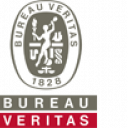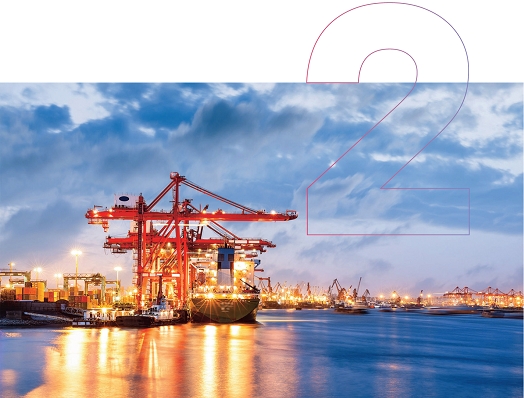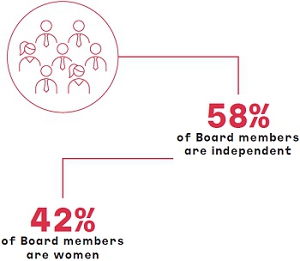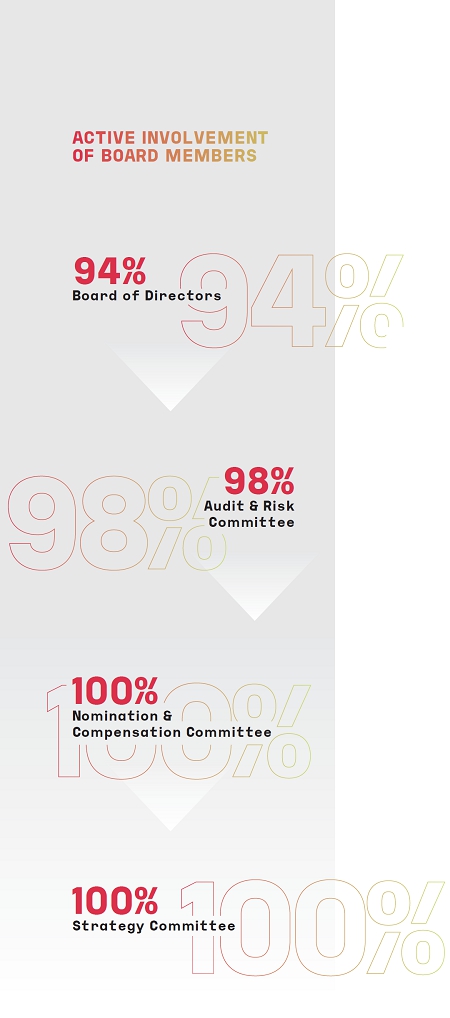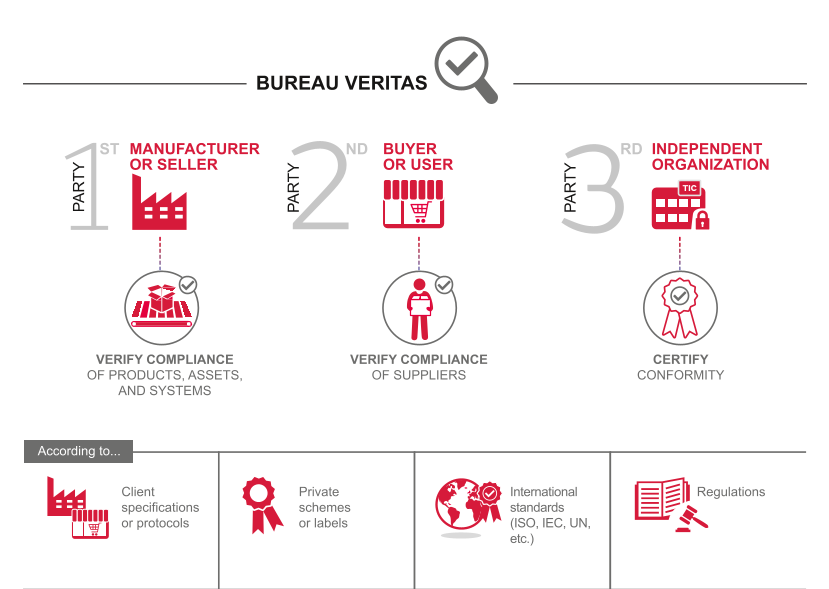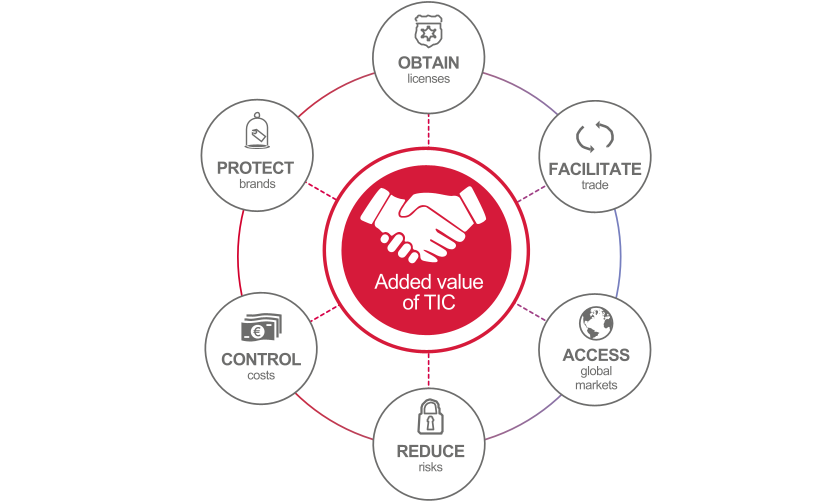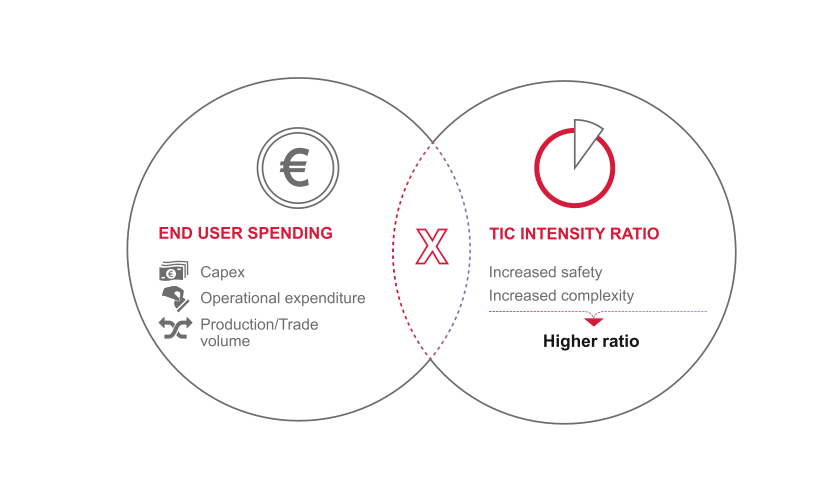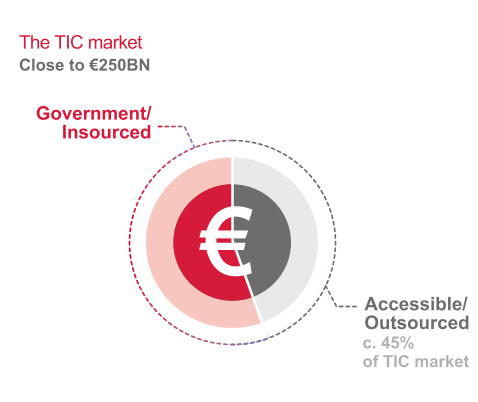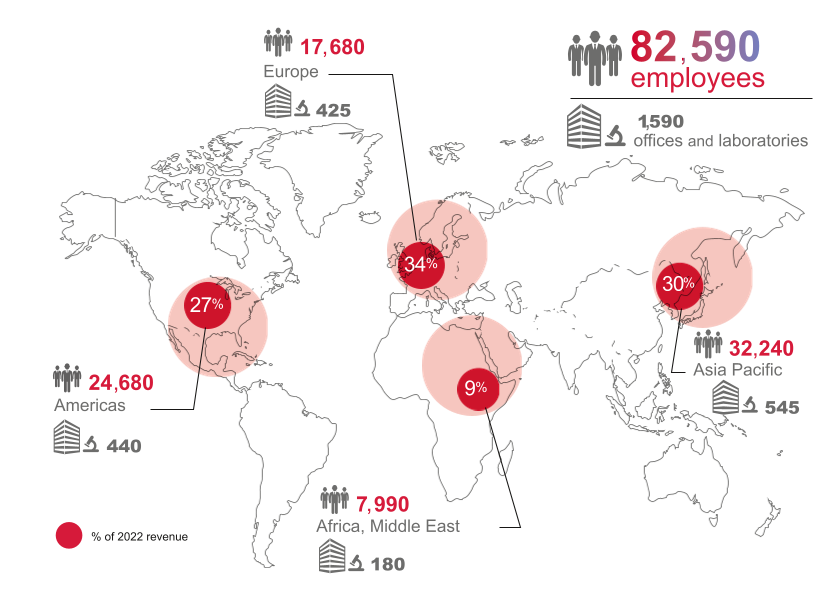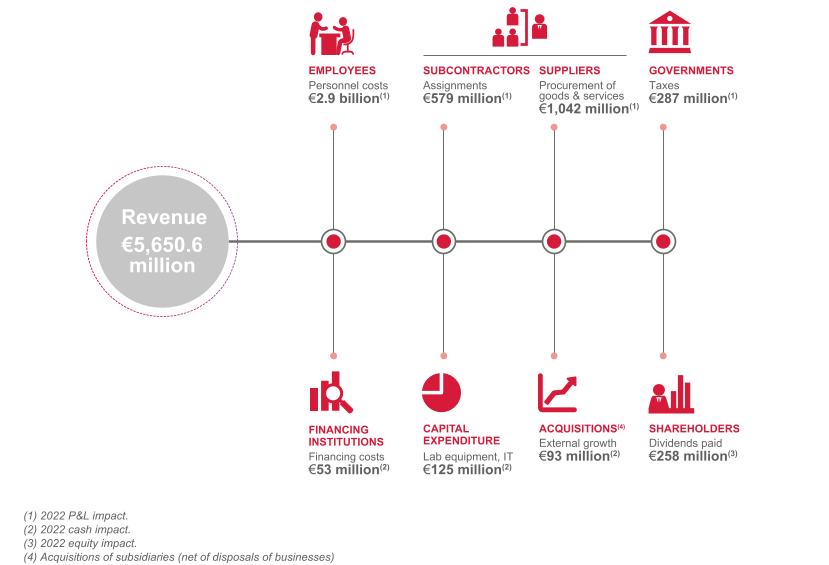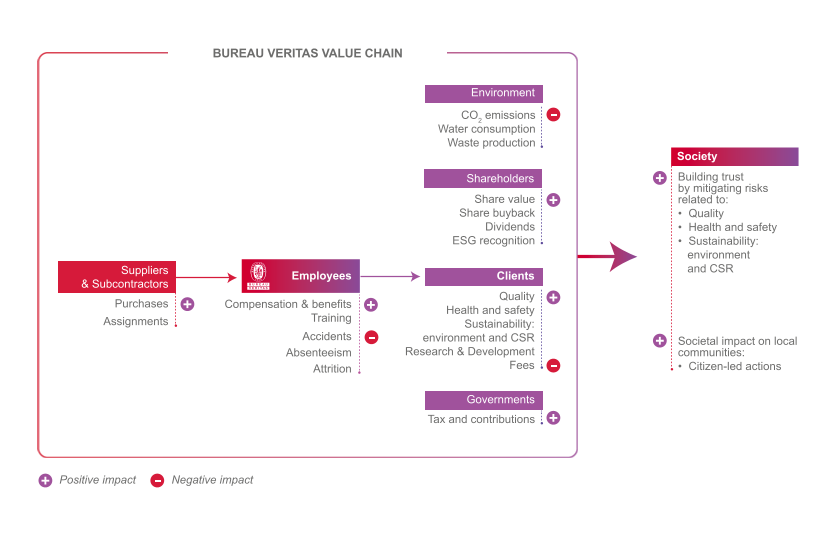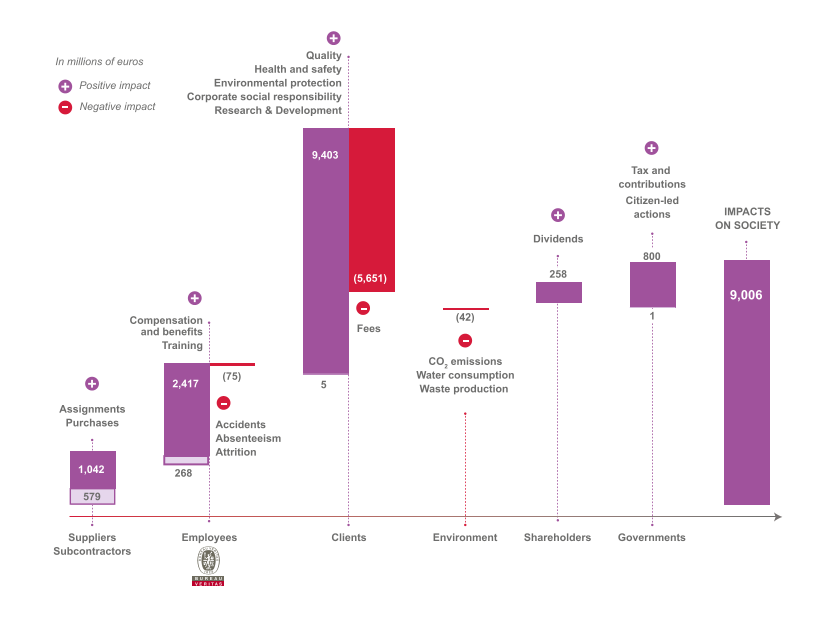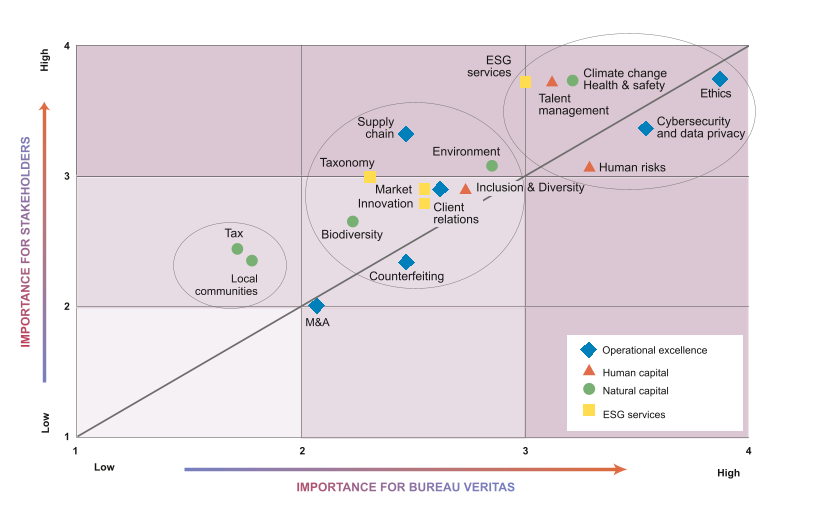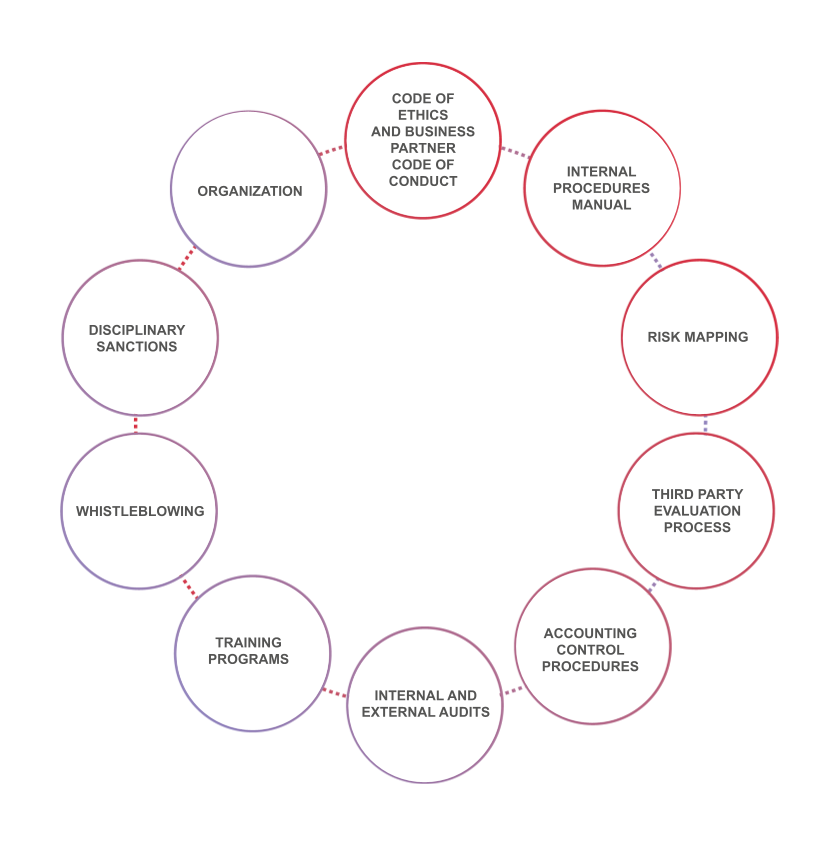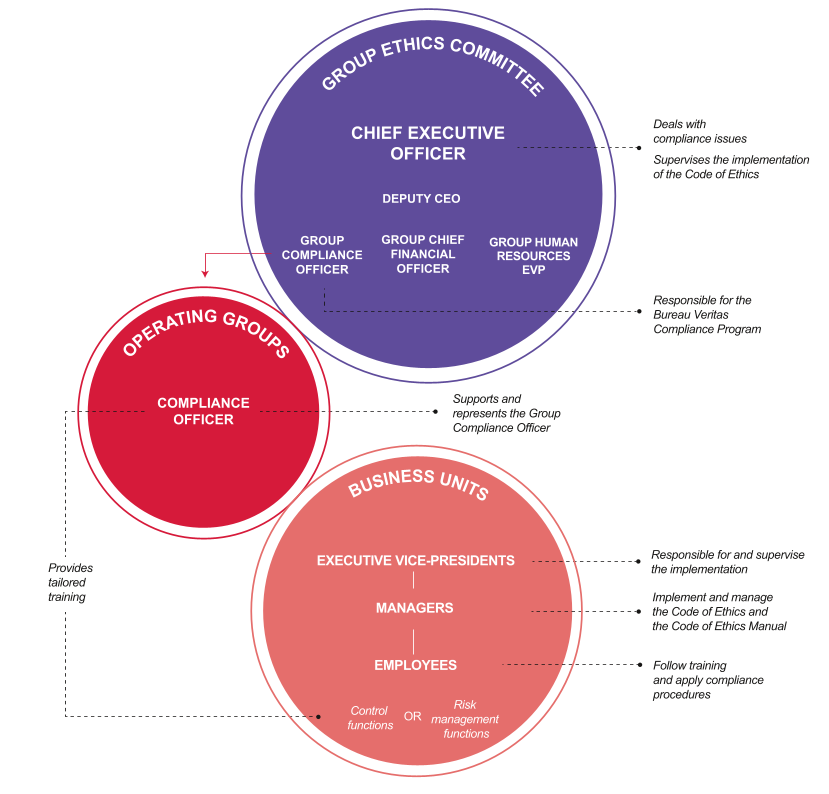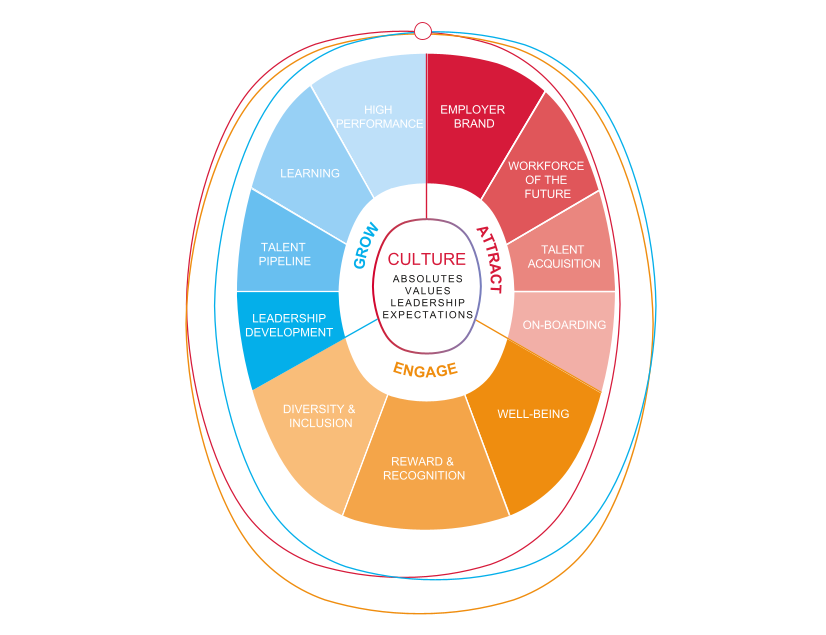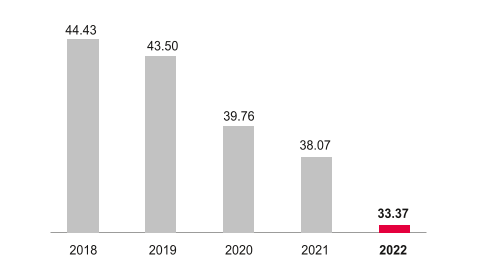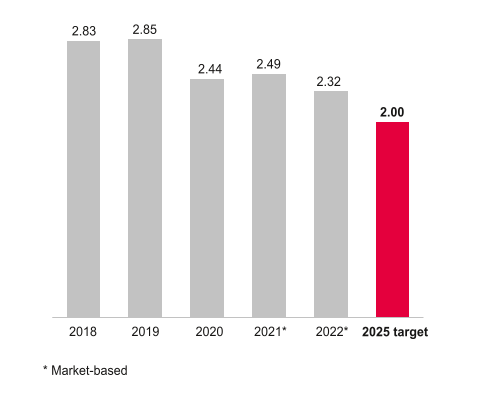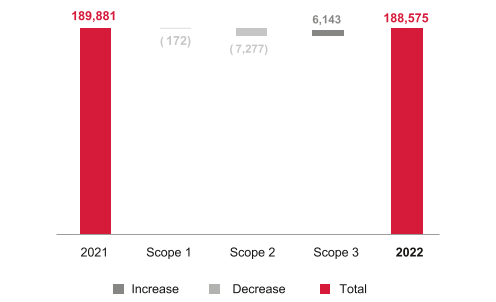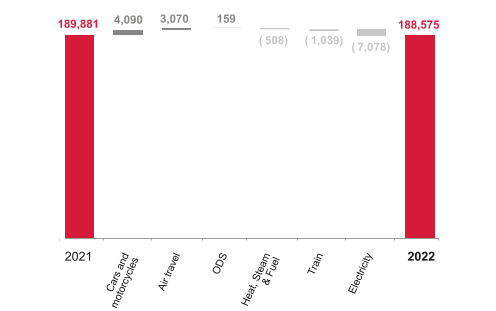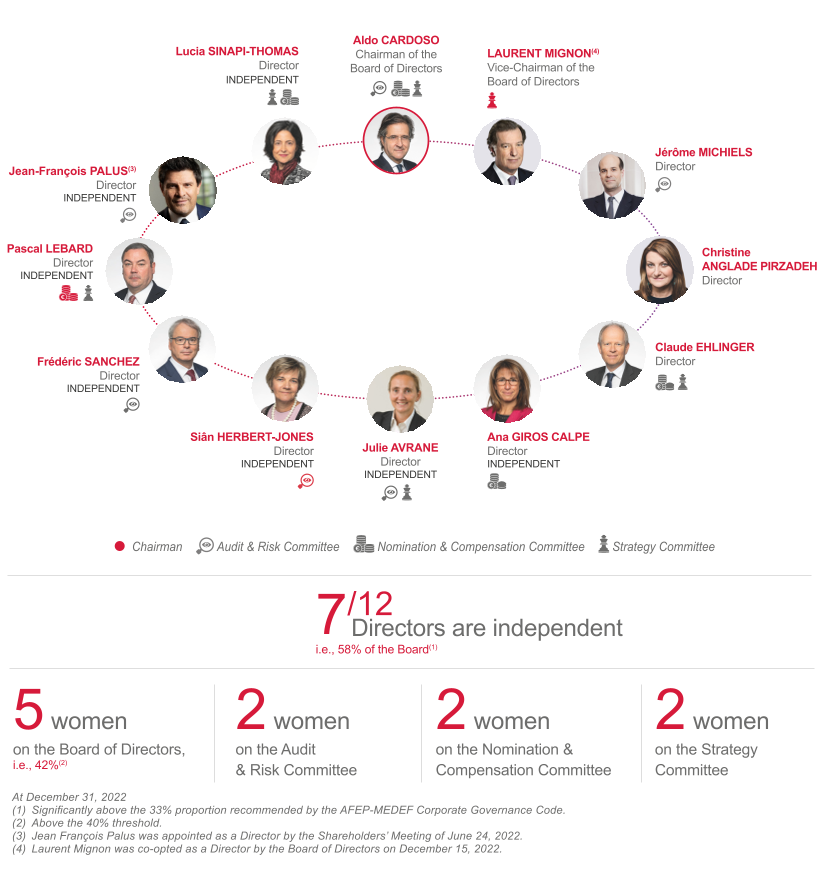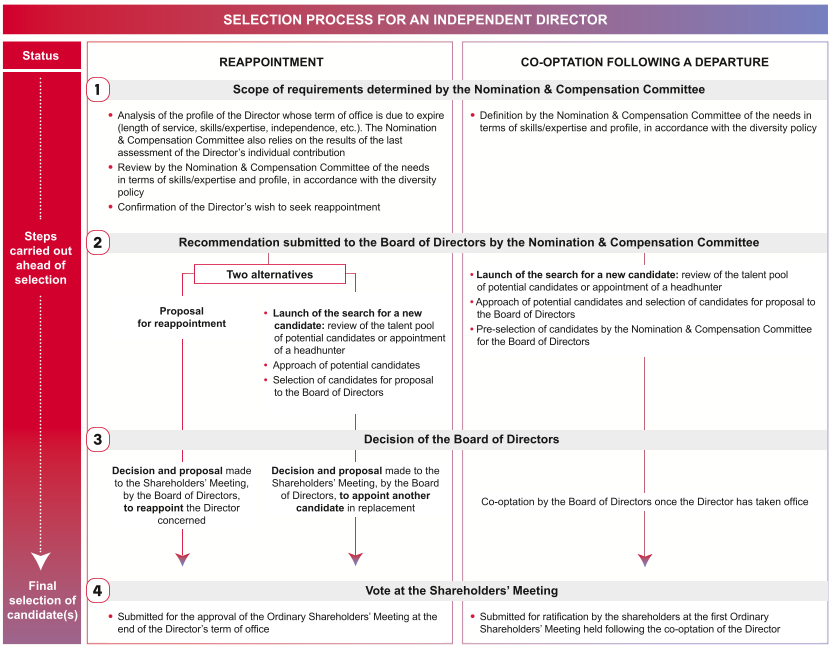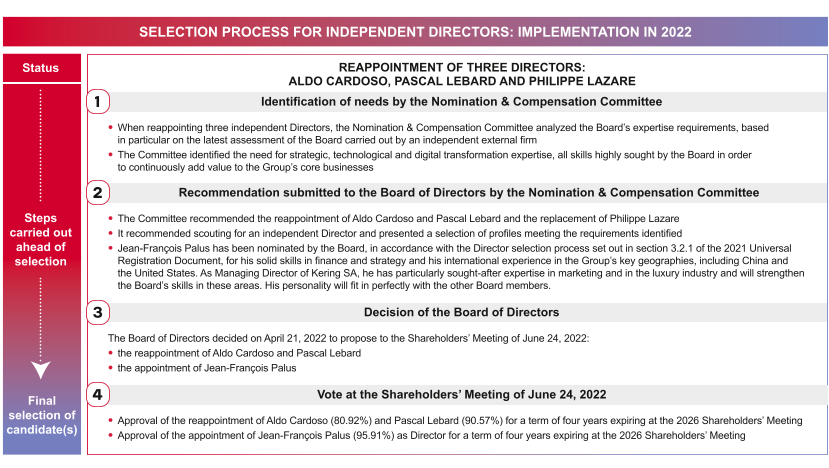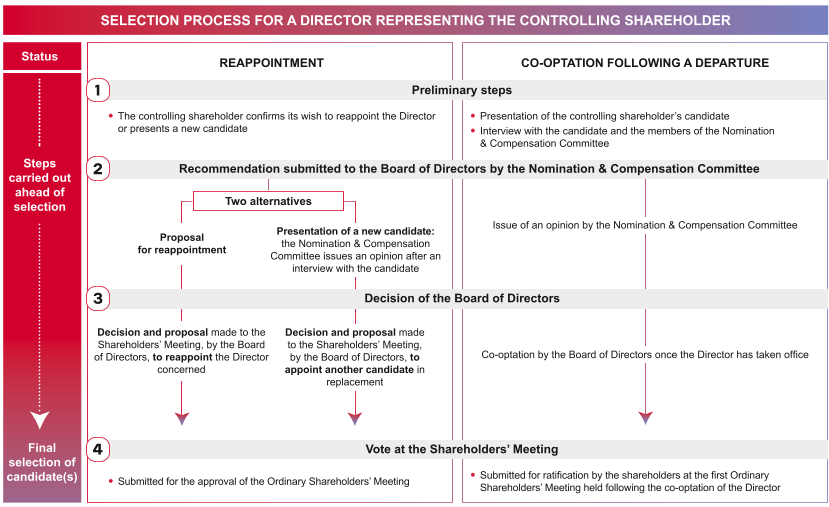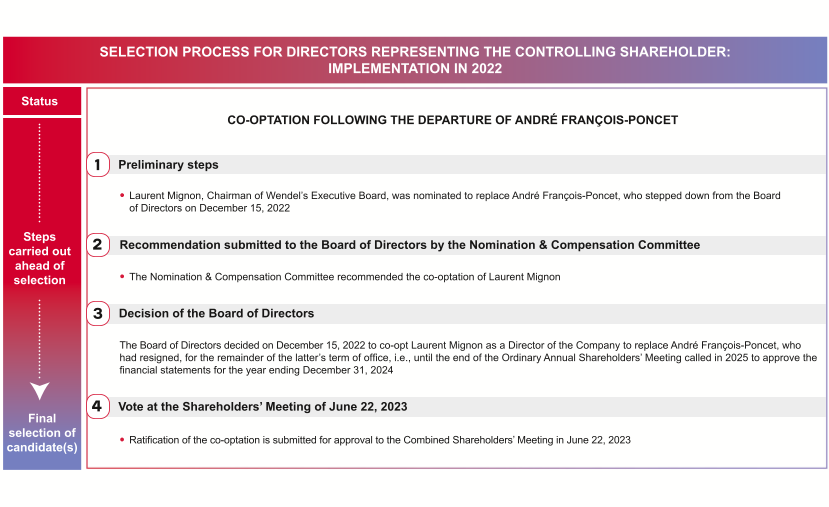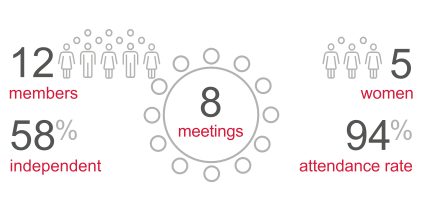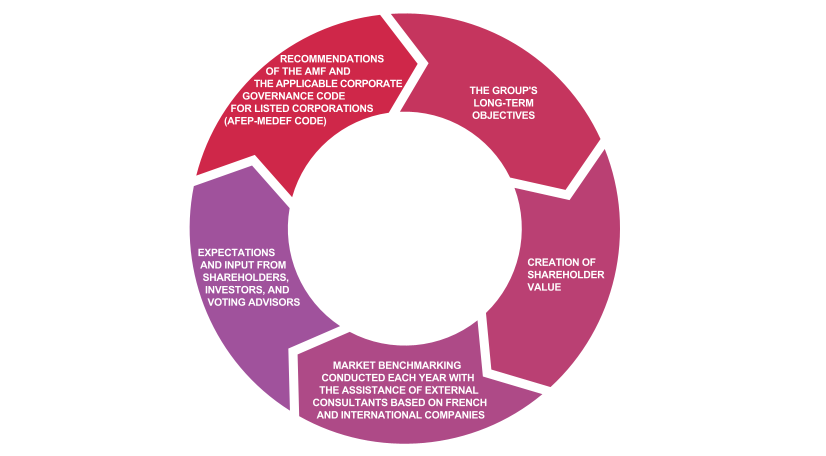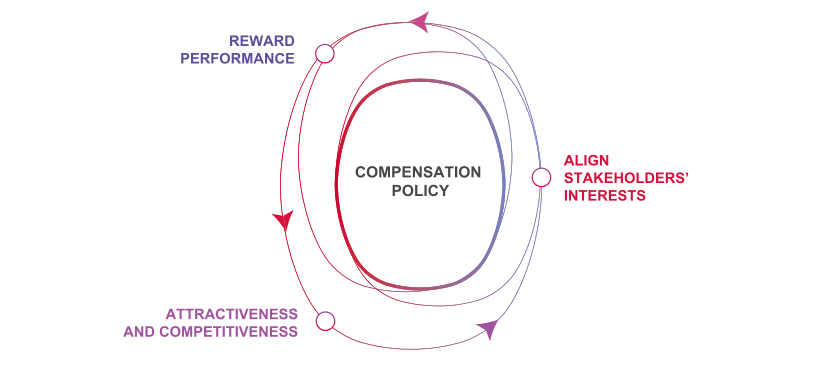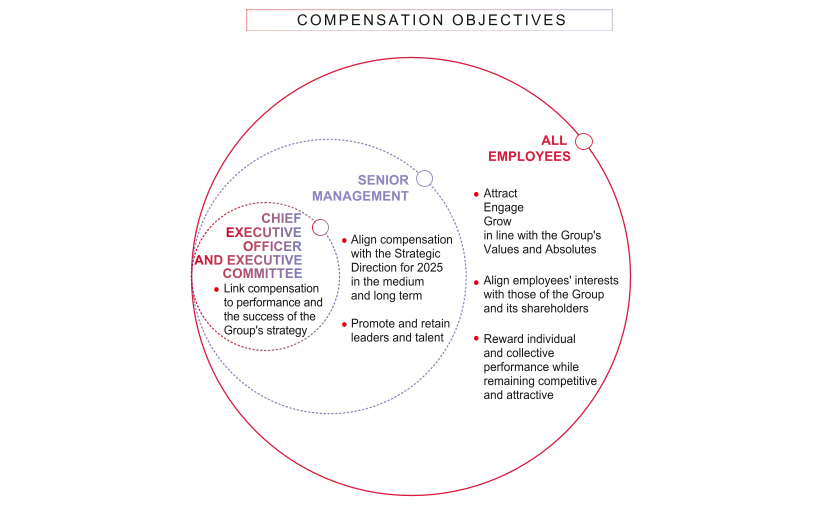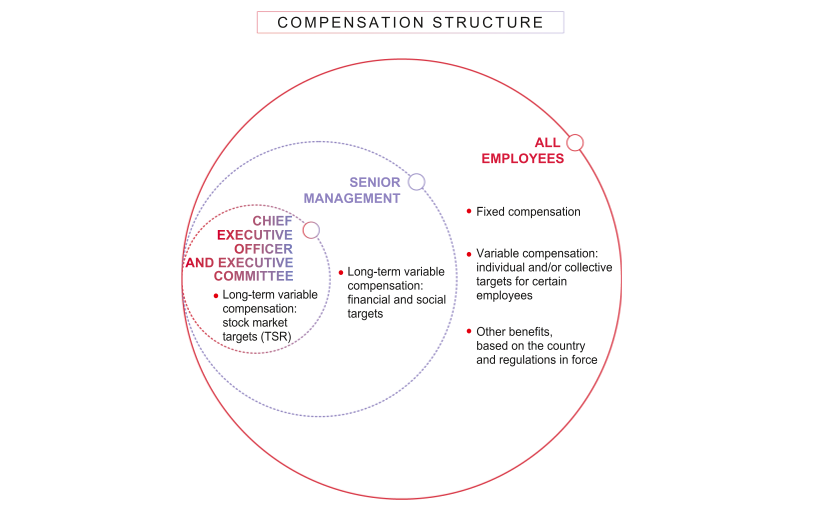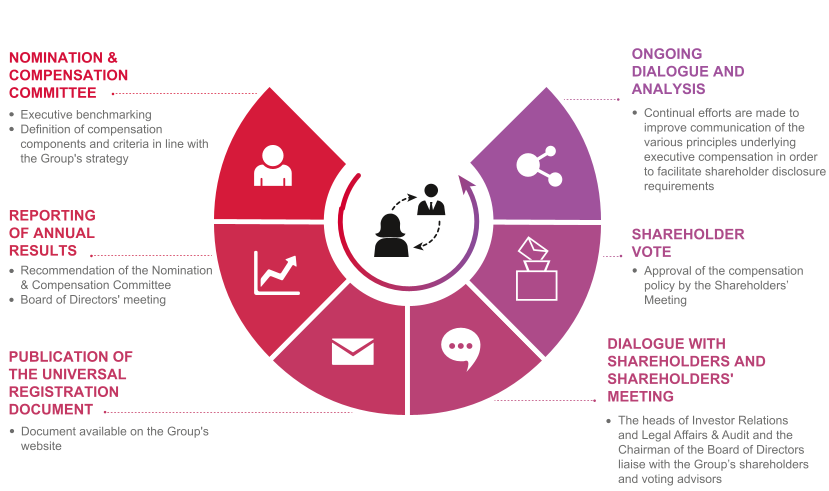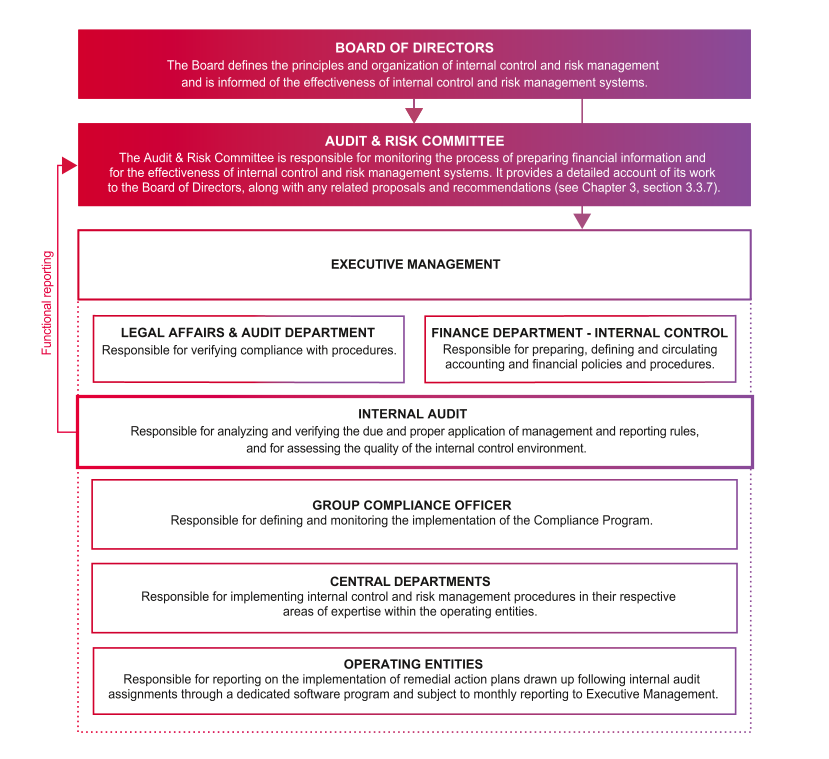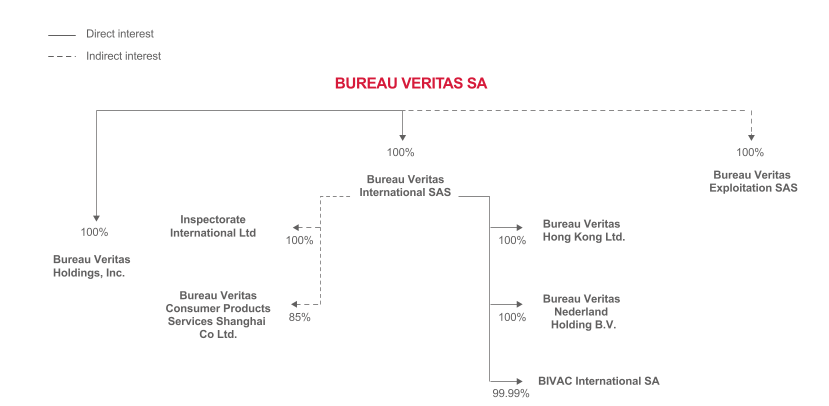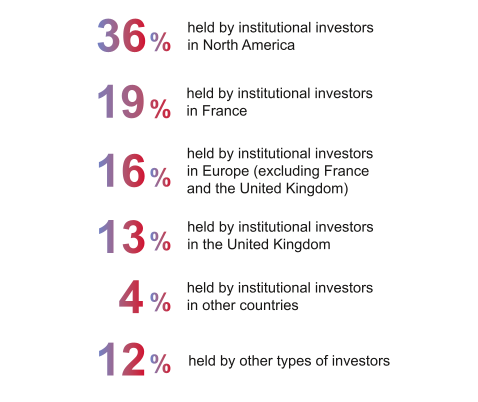URD 2022
-
Integrated Report
-
OUR PEOPLE: FOCUSED ON OUR CLIENTS, DRIVEN BY SOCIETY
Every person that arrives at Bureau Veritas has made a conscious decision to join a Business to Business to Society company. Together, we form a diverse community of over 82,000 employees in 140 countries whose ultimate vision is to address major societal challenges to Shape a World of Trust.
As a service company, our reputation, our added value and our development depends largely on our expertise, our knowledge and our ability to support our clients. Continuous learning and ongoing development and growth are the foundations from which we build. This is why at Bureau Veritas we strive to attract, develop and retain the best people. Our company’s growth and organizational resilience enable us to invest in learning and development for our people so they can become even more effective, knowledgeable and relevant in meeting and anticipating our clients’ needs.
The engagement and wellbeing of our employees is key to our success. In 2022, Bureau Veritas conducted an internal engagement survey (BVocal) among 50,000 employees (38,000 in 2021) to measure and gather their insights on their experience at the company. Feedback is received confidentially and is used to take actions to continuously improve our culture and our employees’ experience.
Our 82,000 employees are united by some values, precise expectations and Absolutes that are at the core of Bureau Veritas’ identity. By definition, the Group’s mission of Shaping a World of Trust requires independence, impartiality and integrity. For this reason, Ethics is one of its three Absolutes, together with Safety and Financial control.
The same ethical principles guide the actions and behaviors of all BV Trust Makers, whether they work in a laboratory, or an office, or at our clients, in a factory or on a construction site.
Our people draw on their knowledge and expertise to support our clients throughout the world, supporting them to reduce risks associated with health and safety, quality, environmental protection and human rights. Our daily work spans across multiple sectors and markets, and our expertise responds to major challenges ranging from the energy transition to new forms of mobility, including best business practices and the resilience of supply chains. To work in Testing, Inspection and Certification (TIC) is to be at the forefront of the societal challenges of today and tomorrow. The breadth and depth of our knowledge and services represent an undeniable competitive advantage for Bureau Veritas as a service company. And for our employees, it is a unique opportunity to leave their mark and have a positive impact on both people and the planet.
In 2022, five high-potential young Bureau Veritas leaders participated in the annual One Young World Summit in Manchester. Over three days, 2,000 young leaders from 190 countries gathered with more than 100 advisors. Together, they discussed critical topics such as ethical leadership, climate change, ocean regeneration, women in STEM and LGBT+ challenges and opportunities. They attended plenary sessions as well as hands-on workshops that gave them opportunities to learn, share ideas and network with other young leaders. It was a unique experience enabling them to gain insight into and reflect upon how they personally and professionally can positively impact these issues and the leading role that Bureau Veritas can play in addressing some of the world’s most pressing challenges.
Being part of Bureau Veritas means supporting our clients in their approach to Sustainability. It also means putting Sustainabilty at the heart of our own company’s shared culture and learning programmes. Sustainability and being a responsible company are at the heart of our business, and we hold ourselves to account in the commitments we make to our clients, shareholders and to ourselves, and ensure we act consistently and in full alignment with the expertise and the services that we offer.
The commitment of our people enables us to put our CSR strategy Shaping a Better World into practice. The Group has set itself very ambitious CSR goals for 2025. These include increasing female representation in leadership, lowering our accident rate, reducing our carbon footprint per employee and ensuring each employee is trained to our Code of Ethics. To achieve our CSR goals, we will continue to boost skills and reinforce a common culture around Sustainabilty. To support this, BV has launched the Sust’Enablers platform, which provides all of our people with the support they need to understand how Sustainabilty is core to everything we do at BV.
-
A MESSAGE FROM ALDO CARDOSO, CHAIRMAN OF BUREAU VERITAS’ BOARD OF DIRECTORS
It is with great pride, appreciation for our employees and gratitude to our 400,000 clients around the world that I look back on Bureau Veritas’ tremendous achievements over the past year.
The year 2022 was remarkable both in terms of our financial performance and our CSR commitments. We saw growth of more than 13%, an operating margin in line with what we had announced and solid cash generation. At the same time, our ESG strategy execution was recognized by the market on multiple occasions. In this context, the Board of Directors will propose to the Shareholders’ Meeting an increase in the dividend distribution rate to 65% compared to 50% in 2022, i.e. €0.77 per share(1). This demonstrates our confidence in the Group’s growth prospects.
These results, which set a benchmark for our industry, were achieved in complex market conditions: the Zero Covid policy in China, the conflict in Europe, geopolitical tensions and their impact on supply chains, a fierce war for talent and an inflationary environment in many countries in which we have sizeable operations.
Once again, I would like to thank all Bureau Veritas employees for their unfailing commitment, resilience, agility and ability to innovate irrespective of the circumstances.
The work of the Board of Directors, as well as that of its various Committees, illustrates the extent to which all the directors and I consider the company’s social responsibility to be central to all our business.
We have held numerous sessions on succession planning, compensation policy, overseeing the proper execution of our strategic plan, monitoring financial performance and ESG issues, both internally through our policies and actions (particularly in terms of climate and inclusion) and externally through the deployment and enhancement of our expertise through the BV Green Line of services and solutions. All of this demonstrates our determination to ensure the long-term success and positive impact of Bureau Veritas to the benefit of all its stakeholders. This second Integrated Report is an opportunity to present our sustainable model to create and share value in a way that remains true to our purpose: Shaping a World of Trust by ensuring responsible progress.
After 11 years at the head of Bureau Veritas, Didier Michaud-Daniel will step down as Chief Executive Officer in 2023.
The implementation of the succession plan drawn up by the Board of Directors is proceeding smoothly. It began in May 2022 with the arrival of Hinda Gharbi as Chief Operating Officer and continued in January 2023 with her appointment to the position of Deputy Chief Executive Officer. The Group’s employees, the management team and the members of the Board are all involved in this successful integration process. At the end of the Shareholders’ Meeting to be held on June 22, 2023, her transition to the position of CEO will become effective. I would like to pay tribute to the remarkable work of Didier Michaud-Daniel who, over the period of its two mandates, has taken the Group to new levels. Our revenue has increased by more than 65%, our workforce has grown from 52,000 to 82,000 employees, our earnings per share have risen by almost 50% and our financial structure has been considerably strengthened, enabling us to have trust in our future.
At the same time, we have become highly international and a leader in markets where we can create significant value. Our portfolio of business activities has expanded considerably, and the BV Green Line now cements our position as the global sector leader for all our clients’ Sustainability challenges.
On behalf of the Board of Directors, I wish Hinda every success in this new journey. For my part, as Chairman of the Board of Directors, I assure her of my full support in our shared ambition to lead Bureau Veritas toward the sustainable and bright future that lies ahead, in line with our strategy and the embodiment of our values.
-
CONVERSATION
DIDIER MICHAUD-DANIEL
I would describe the past year as historic. We demonstrated excellence on two fronts: financial performance and exemplarity in ESG, both of which underpin our 2025 strategy.At Bureau Veritas, thanks to our solid fundamentals, the importance of our mission, and the commitment of all our 82,000 employees worldwide, we have stayed the course and accelerated our growth. A growing number of companies of all sizes are seeking out our expertise and independence to create the necessary conditions for trust as they move toward more responsible business models.
To illustrate this performance in concrete terms, I would emphasize that we saw strong activity across our entire services portfolio and in most of our major geographic areas. I am not including China, which was, of course, affected by lockdowns.
In line with our 2025 strategy, we made some good acquisitions, in the United States in the infrastructure, healthcare and cosmetics sectors, and in Spain in sustainable fashion. We are sending a strong signal in terms of target geographies and sectors. Via our BV Green Line of services and solutions, we intend to further boost our momentum on Sustainability and ESG issues, both of which are essential to the world in which we live. This suite of services and solutions now accounts for 55% of our sales and represents a source of growth for the Group. It is the concrete expression of our ambition to support our clients in their efforts to achieve greater transparency and credibility on Sustainability stakes.
2023 will be a year of change for Bureau Veritas. Hinda, you are set to take over as CEO after the Shareholders’ Meeting in June. What is your view of the company following your recent arrival?
HINDA GHARBI
My first few months at Bureau Veritas were spent getting to know our wide range of business activities and skills, and interacting with the teams in the field all over the world. I went out to meet them to understand their local challenges, their vision of the company and of our mission.I talked to many of our clients and partners. First, what impressed me the most was the depth and the sheer breadth of our expertise in almost all sectors of the economy. Very few companies in the world can lay claim to this positioning. I am passionate about developing and demonstrating the value of people, and this is at the heart of Bureau Veritas’ value creation. Then there are our clients: 400,000 worldwide, spanning all continents, with one point in common – they rely on the demanding standards and expertise of a trusted third party, who is close to them and fully understands their sector, and their current and future challenges.
Lastly, there are our 200 years of history and at the same time our unparalleled modernity in understanding the challenges of today and tomorrow through our vision as a Business to Business to Society company. This is clearly evident in my perceptions to date of the Group’s culture.
DIDIER MICHAUD-DANIEL
The future of BV will be written by Hinda, with all the company’s teams by her side.This future will be built on solid foundations, the result of a profound transformation of the company over the last 10 years: robust digital and management systems that ensure the organization’s agility, a strategy of geographic and portfolio diversification that provides resilience and finally, a paradigm shift in culture that reasserts the power of our brand as an embodiment of Sustainability and trust.
I would like to take this opportunity to thank all our employees, clients, shareholders and partners for their contribution to Bureau Veritas’ success since 2012. We can all be proud of how far we have come, and look forward to significant growth and responsible progress in the future. Hinda, with her exceptional career path, has the right leadership qualities and vision to lead Bureau Veritas in this new chapter of its history.
HINDA GHARBI
Thank you Didier. I will indeed aim to capitalize on this legacy to continue to develop the company, its talents and accelerate on the path of Sustainability where we have a perfectly legitimate claim to a leadership position.The climate emergency and its corollary, the need for an accelerated energy transition, imperatives linked to Sustainability, the circular economy, the resilience and well-being of people within companies, digital transformation and supply chain traceability: both our clients and our own employees see us as increasingly relevant in all these areas.
To address these major trends, we will still need to develop and capitalize on our teams’ knowledge, skills and adaptability on the one hand, and on the other, shape our service portfolio by making Sustainability our North Star. What we started with our BV Green Line of services and solutions, we now need to amplify, and innovation and digital will be at the heart of the new value we will create for our clients and our other stakeholders.
I would like to thank the Board of Directors represented by its Chairman, Aldo Cardoso, the BV teams and the Executive Committee represented by Didier, as well as Wendel, our longstanding shareholder, for their trust. In June, at the Shareholders’ Meeting I will be humbled to stand before the shareholders of a company that is two hundred years old, and proud to have the opportunity to lead this remarkable company, impactful, which has such a brilliant future.
-
CREATE
Capitalizing on the megatrends that shape its ecosystem, Bureau Veritas has entered a new era of value creation. Guided by its purpose, the Group is committed to applying all its expertise to meet its clients’ major environmental, social and governance challenges.
RESPONSIBLE PROGRESS TO SUPPORT 5 MEGATRENDS
In the framework of its 2025 Strategic Direction, Bureau Veritas carried out an in-depth study of its ecosystem and identified 5 structural trends. The impact and responsibility of businesses emerged as a theme common to all of them. In 2022, these trends intensified, demonstrating the enduring relevance of BV’s approach, whose ambition to contribute to responsible progress is proving over more relevant.
Demographic growth and urbanization: how does Bureau Veritas’ expertise contribute to sustainable cities?
We now need to make choices in response to new expectations for quality, safety, well-being and Sustainability. Infrastructure must perform better, impact the environment less and be more connected and energy efficient. All of these factors should make cities places of responsible progress. At Bureau Veritas, we offer unparalleled know-how and expertise in all of these areas.”
Supply chains are facing considerable challenges: how is Bureau Veritas helping its clients become more resilient?
“Today, all signs point to the same conclusion: supply chains, which have recently experienced heavy disruption, need to reinvent themselves. Factors such as the rise of trade protectionism, mismatches between supply and demand, soaring raw materials prices, the carbon impact of shipping and lockdowns have threatened established models. Organizations need the flexibility to adapt to meet two key challenges. First, supply chains must be shortened and simplified, and shorter distribution circuits must be developed to be as close as possible to the end market. Secondly, new expectations must be fulfilled in terms of transparency on the sourcing, quality, social impact and environmental impact of products. In both of these areas, BV is a key partner.”
What is the best way to secure and protect digital infrastructure and data in an economy that is digitizing at an exponential rate?
“Investments in digital infrastructure and new technologies continue to rise. The challenge linked to these investments today is twofold. First, it is to ensure the security of the systems used, the data transmitted, and the digital infrastructure built. Second, it is to identify that the data is adequate, necessary and sufficient for its purpose – that it is the right data. In these areas, Bureau Veritas has a major role to play as a trusted third-party. If these changes are to support responsible progress, it is vital to verify the performance of these technologies and ensure the integrity of data transmissions. This is what we do at BV.”
All organizations have recognized the necessity of ESG commitments. But taking action is no longer enough – they must also prove the impact they achieve. How does Bureau Veritas support sustainable performance?
“Businesses and public authorities have adopted Sustainability as a factor that is essential to their longevity. But they need support for this whether to prove they are implementing their ESG commitments, achieve a successful energy transition, or transparently measure their actions. BV is on hand to provide support on all these topics. It is how we empower clients to roll out these sustainable models more effectively.”
Health crisis, aging population: expectations in terms of hygiene and health have increased considerably. For these sectors, what are the challenges today?
“The Health and Hygiene sectors have undergone profound transformations over the past two years. On the one hand, this is because of the explosion of regulations and standards in terms of hygiene conditions. On the other hand, the subject of access to care has become essential. Not only is it physical access with structures capable of supporting the aging of populations but it is also the need for continuous and remote access including the connectivity of medical tools. All these advances are necessary if we want to move toward responsible progress, and it is beneficial to all! In all these fields – regulatory support, infrastructure tests, inspections, or equipment connectivity testing – our solutions support the evolution and improvement of consumer experience as well as the reliability of the end product supporting innovation and advancement, for professionals and users alike.”
-
SUSTAINABILITY
OUR DNA: SUSTAINABILITY CATALYZING RESPONSIBLE PROGRESS
The Sustainability strategy deployed by Bureau Veritas is global and twofold. It is a powerful growth driver, which reflects both our convictions and our ambitions. Internally, it represents our commitment to leading by example and serving as a model for the TIC industry, through the implementation of our CSR strategy. Externally, it is a commitment to our clients, whom we support in their journey toward more sustainable businesses — and a more sustainable world.
-
NURTURE
Bureau Veritas relies on solid fundamentals to move forward
and deliver on its Strategic Direction. Thanks to our rigorous
standards, our governance is in keeping with our vocation of Shaping
a World of Trust. It guides the Group every day, supporting our
development and our strong relationships with our stakeholders.OUR BOARD OF DIRECTORS
The performance, independence and high-quality discussions of Bureau Veritas’ Board of Directors are a product of its diversity of profiles and skills. The Board validates Bureau Veritas’ strategy and ensures that it is implemented correctly and is in the company’s best interests.
To successfully fulfill its missions, the Board of Directors relies on three specialized Committees. Made up of Board members, these Committees examine the issues submitted to them and report to the Board on their work.
This Committee is responsible for monitoring the integrity of financial information. It verifies the effectiveness of internal control and risk management systems, as well as Statutory Auditors’ mandated and independent audit of the Group’s accounts. It also ensures both the consistency of non-financial reporting and the reliability of the data, as noted in Chapter 2 of the Universal Registration Document. In 2022, the Audit & Risk Committee focused primarily on examining financial statements and information, reviewing audit conclusions and internal control procedures, and reviewing half-yearly risk management reports. It also renewed the term of office of the Statutory Auditors and reviewed all their reports on consolidating financial statements for the year.
The Strategy Committee analyzes the Group’s strategic orientations, budget and acquisition and disposal plans, submitting its recommendations to the Board of Directors. It is also responsible for monitoring and developing Bureau Veritas’ CSR strategy and policies. It sets key performance indicators and ensures that social and environmental issues related to the Group’s operations are taken into account and addressed. In 2022, the Strategy Committee’s work focused mainly on reviewing both acquisition plans for the year and the performance of past acquisitions. It also monitored the implementation of the 2025 Strategic Direction, and reviewed strategy catalysts, including CSR, digital strategy, the acquisition and retention of key employees and pricing policy.
This Committee issues recommendations concerning the selection of members of the Board of Directors and the Executive Committee. It also advises on the components and terms of remuneration for members of the Executive Committee. Since 2015, CSR performance criteria have been included in this assessment, with new requirements added in 2022. The Committee also examines succession plans for executive positions, anticipates emergency situations and analyzes evaluations of key individuals. Also falling in its scope is monitoring the implementation of diversity objectives. In 2022, the work of the Nomination & Compensation Committee focused mainly on the executive compensation policy, long-term incentive plans, succession plans, corporate governance and the company’s equal opportunities policy.
To ensure the effectiveness and transparency of the work of its Board of Directors, Bureau Veritas aligns its governance practices with the AFEP-MEDEF Code. This is the corporate governance code of reference for publicly traded companies. Bureau Veritas applies principles that ensure an optimal balance of power between the Board of Directors and the Executive Committee. This includes separation of the Chairman and Chief Executive functions, a Board made up of independent directors, and three specialized Committees that also ensure the presence of independent directors. Every year, the Board of Directors evaluates the alignment of its practices with the AFEP-MEDEF Code.
As part of its ongoing improvement efforts, the Group pays particular attention to the annual recommendations on governance and executive compensation made by the French high Committee on corporate governance (HCGE) and the French stock market regulator (AMF). The information published in Chapter 3 of our Universal Registration Document on this subject closely follows the recommendations of both the AFEP-MEDEF code and the AMF.
-
Presentation of the Group
-
1.1General overview of the Group
Mission
The Group’s mission is to reduce its clients’ risks, improve their performance and help them innovate to meet the challenges of quality, health and safety, and sustainable development. Leveraging its renowned expertise, as well as its impartiality, integrity and independence, Bureau Veritas has helped build trust between companies, public authorities and consumers for more than 190 years.
The services provided by Bureau Veritas are designed to ensure that products, assets and management systems conform to different standards and regulations in terms of quality, health, safety, environmental protection and social responsibility (QHSE).
Depending on its clients’ needs and on applicable regulations, standards or contractual requirements, Bureau Veritas acts:
- ●as a “third party”, i.e., an independent body issuing reports and conformity certificates for products, assets, systems, services or organizations;
- ●as a “second party” on behalf of and upon the instructions of its clients to ensure better control of the supply chain; or
- ●as a “first party” on behalf of clients seeking to ensure that the products, assets, systems or services they are producing or selling meet the requisite standards.
Obtaining a license to operate
Companies must be able to show that they are compliant with a large number of standards and regulations. Bureau Veritas offers them its in-depth knowledge of the standards applicable to their businesses, and as an independent third party, is able to verify their compliance. This allows them to conduct and develop their businesses in compliance with local and international regulatory requirements and to obtain and renew the licenses to operate issued by public authorities.
Facilitating trade
International trade relies, among other things, on third-party players who certify that the goods exchanged comply with the quality and quantities stipulated in the contract between the parties. Bureau Veritas plays a role in the trade process by testing materials, verifying that goods comply with contractual specifications and validating quantities. Exchanges of commodities, for example, are based on certificates issued by companies such as Bureau Veritas.
Accessing global markets
Capital goods or mass consumer products must comply with national and supranational standards before being sold on the market in a given country. These standards constitute technical trade barriers within the meaning of the WTO. Companies design and manufacture their products and equipment to meet the standards of several countries. In doing so, they call on Bureau Veritas to carry out tests, optimize their test plan and ultimately reduce time-to-market.
Reducing risks
Managing risk in the areas of quality, health, safety, environment protection and social responsibility improves the efficiency and performance of organizations. Bureau Veritas helps its clients to identify and manage these risks, from project design to completion and decommissioning.
Keeping costs in check
Thanks to second- and third-party testing, inspection and auditing methods, companies can determine the actual condition of their assets and launch new projects and products safe in the knowledge that costs, timing and quality are under control. During the operational phase, inspections help optimize maintenance and the useful life of industrial equipment.
Protecting brands
The social network boom of recent years has prompted a fundamental change in how global brands are managed. Brands may quickly find themselves under fire due to the malfunction of one of the links in their supply or distribution chain. Bureau Veritas allows companies to improve their risk management, using analyses conducted by a highly reputed independent player.
-
1.2History
1828: Origins
The “Information Office for Maritime Insurance” was founded in Antwerp, Belgium, in 1828, to collect, verify and provide shipping underwriters with information on the condition of ships and equipment. Renamed Bureau Veritas, the Company transferred its registered office to Paris and built up an international network.
-
1.3The TIC industry
To the Group’s knowledge, there is no comprehensive report covering or dealing with the markets in which it operates. As a result, and unless otherwise stated, the information presented in this section reflects the Group’s estimates, which are provided for information purposes only and do not represent official data. The Group gives no assurance that a third party using other methods to collect, analyze or compile market data would obtain the same results. The Group’s competitors may also define these markets differently.
1.3.1A market estimated to be worth close to €250 billion
Inspection, certification and laboratory testing services in the areas of quality, safety, performance, and social and environmental responsibility are commonly referred to as Testing, Inspection and Certification (TIC). TIC services encompass several types of tasks, including laboratory or on-site testing, management process audits, documentary checks, inspections across the entire supply chain and data consistency verification. These activities may be carried out on behalf of the end user or purchaser, independently of stakeholders or at the request of the manufacturer, or on behalf of public or private authorities. TIC services are called for at every stage of the supply chain and apply across all industries.
The overall TIC market depends on product and asset values and the associated risk. The TIC “intensity” corresponds to the proportion of the value of the product or asset allocated by the manufacturer of the product or the operator of the asset to control activities. In general, the TIC intensity falls within a range of between 0.1% and 0.8% of the value of the product or asset. The total estimated value of the TIC market can be calculated by multiplying the TIC intensity by the amount spent by manufacturers, operators, and the buyers and sellers of goods and products.
On a short- and medium-term basis, the size of the market mainly varies in relation to inflation, global economic activity, investment and international trade. Applying the aforementioned approach, Bureau Veritas estimated the size of the global TIC market in 2022 at close to €250 billion, based on external macroeconomic data such as investment volume per market, operational spending per market, the production value of goods and services, and the level of imports and exports.
- ●the accessible (outsourced) market, where services are provided by specialized private organizations or firms, such as Bureau Veritas;
- ●the internal (insourced) market, where the companies themselves perform these services as part of quality control and assurance; along with the market served by public bodies and organizations such as customs, competition authorities, port authorities or industrial health and safety authorities.
The outsourced TIC market also depends on a country’s administrative organization, whether or not it has a federal structure, and the industry concerned. Over time, these factors may have a significant impact on the size of the market, irrespective of the underlying macroeconomic conditions. The balance between insourcing and outsourcing therefore fluctuates from year to year, depending on the policies implemented by governments or changes in practices within industry sectors. This is the case in China, for example, where certain sectors are opening up gradually.
- ●end-user expenditure;
- ●the TIC “intensity” of products (fairly stable in the short term but may increase in the long term due to stricter standards and regulations);
- ●the extent to which businesses subcontract these services (the trend shows that this is increasing).
From a geographic point of view, the TIC market can be split into three main regions: Europe, the Americas and Asia. Bureau Veritas is present in all of these regions thanks to the investments it has made over the past 15 years. Going forward, the Group plans to bolster its positioning, particularly in the fastest-growing markets such as China and the United States.
-
1.4Group's Strategy and objectives
1.4.1Key competitive advantages
An efficient international network
Bureau Veritas has an extensive global network of around 1,600 offices and laboratories in almost 140 countries.
This network is particularly well developed in countries with mature economies (e.g., France, the United States, Canada, Japan, the United Kingdom, Spain, Italy, the Netherlands, Australia and South Korea), which have a strong regulatory background and where the Group is recognized for its technical expertise and innovative production models.
Bureau Veritas is also well established in faster growing economies like China, Brazil, Chile, Colombia, the United Arab Emirates and India, where it has built solid growth platforms with a strong local presence over time. The Group continues to expand its exposure to these regions by opening new offices and laboratories and systematically developing each of its businesses in these markets.
The Group’s scale is one of its core assets, providing value and differentiation both commercially and operationally.
From a sales standpoint, its global network enables the Group to service key accounts (around one-quarter of the Group’s revenue) and thereby win major international contracts, which represent a growing part of its activity.
From an operational standpoint, the Group improves its profitability by generating economies of scale resulting in particular from sharing offices, back-office functions and IT tools, and from amortizing the cost of developing and replicating new services and industrializing inspection processes over a larger base.
The organization into regional hubs located in key countries enables the Group to spread knowledge, technical support and sales teams across a given region.
In the future, the Group aims to strengthen this network organization around regional hubs, enabling it to generate scale effects.
A strong brand image of technical expertise and integrity
Bureau Veritas has built a successful global business based on its long-standing reputation for technical expertise, high quality and integrity. This reputation is one of its most valuable assets and is a competitive advantage for the Group worldwide.
Technical expertise recognized by the authorities and by many accreditation bodies
Over the years, the Group has acquired skills and know-how in a large number of technical fields, as well as broad knowledge of regulatory environments. Bureau Veritas is currently accredited as a second or third party by a large number of national and international delegating authorities and accreditation bodies. The Group constantly seeks to maintain, renew and extend its portfolio of accreditations and authorizations. It is subject to regular checks and audits by authorities and accreditation bodies to ensure that its procedures, the level of qualification of its personnel and its management systems comply with the requisite standards, norms, guidelines or regulations.
Quality and integrity embedded in the Group’s culture and processes
Integrity, ethics, impartiality and independence are some of Bureau Veritas’ core values and are central to its brand reputation and the value proposition for its clients.
These values are the focal point of the work carried out by the TIC profession in 2003 under the leadership of the TIC Council (the international association representing independent testing, inspection and certification companies), which led to the drafting of the Group’s first Code of Ethics, published in October 2003.
A profitable growth model supported by strong cash generation
- ●it is based on two growth drivers: primarily organic growth, supported by growth through acquisitions. Average organic growth over the past five years (including a 6.0% decline in 2020 in the context of the crisis caused by the Covid-19 pandemic) was around 4%;
- ●it is a profitable growth model, with a high adjusted operating margin. Historically, it is slightly above 16% on average; it generates significant and regular cash flow: the Group’s free cash flow has averaged around €600 million over the last five years. It should be noted that Bureau Veritas has paid very close attention to its cash flow and liquidity – particularly in terms of its working capital requirements – especially in recent years. These efforts have been stepped up in the context of the health crisis;
- ●it is underpinned by the Group’s strategy of strict capital allocation: net debt must be maintained well below bank ratios and the Group must be able to fund acquisitions and pay dividends.
-
1.5Presentation of business activities
1.5.1Marine & Offshore
Group revenue
Group adjusted operating profit
A portfolio of high value-added services for a loyal client base
Bureau Veritas classifies ships and offshore facilities by verifying their compliance with classification rules, mainly regarding structural soundness and the reliability of all related equipment. This mission is usually carried out together with the regulatory (“statutory”) certification mission.
Class and regulatory certificates are essential for operating ships. Maritime insurance companies require such certificates to provide coverage, and port authorities regularly check that valid certificates exist when ships come into port. Similarly, keeping existing offshore facilities in compliance with safety and quality standards, as well as regulatory requirements is crucial for operators.
Marine & Offshore services are designed to help clients comply with regulations, reduce risk, and increase asset lifecycles while protecting the marine environment. The Group’s services begin at the construction phase, approving drawings, inspecting materials and equipment, and surveying at the shipyard. During the operational life of the assets, Marine & Offshore experts make regular inspections and offer a comprehensive range of technical services including asset integrity management. On behalf of its clients, Bureau Veritas monitors any changes in regulations, identifies applicable standards, manages the compliance process, reviews design and execution and liaises with the competent authorities.
The Group has also diversified into several complementary services, including loss adjusting and risk assessment for the offshore industry and marine accident investigations, pre- and post-salvage advice and the re-floating of vessels. It also created Bureau Veritas Solutions Marine & Offshore in 2018.
In 2022, 39% of Marine & Offshore revenue was generated by the classification and certification of ships under construction and 61% was generated by the surveillance of ships in service and complementary services.
The Group is a member of the International Association of Classification Societies (IACS), which brings together the 11 largest international classification societies. They classify more than 90% of world tonnage, with the remaining fleet either not classified or classified by small classification companies operating mainly at the national level.
Worldwide network
To meet the needs of its clients, the Marine & Offshore network spans 90 countries. In addition to 18 local design approval offices located near its clients, the Group’s network of 180 control stations gives it access to qualified surveyors in the world’s largest ports. This means that inspections can be conducted on demand and without the delays that could be detrimental to the ship’s business and owner.
A highly diverse fleet classified by Bureau Veritas in a growing market
Since the beginning of this millennium, world maritime trade has increased every year, except in 2020 due to Covid-19. The upward trend is ongoing, albeit at a slower pace than before. Both in terms of renewing the existing fleet and building new vessels, orders for new ships continued to see good momentum in 2022, with global orders in gross tonnage (approximately 70 million of gross registered tonnage) slightly higher than orders between 1996 and 2021. Orders in 2022 were fueled by massive investments in LNG carriers and container ships; orders for bulk carriers and tankers were lower. Global order books stood at 3.5 years at the beginning of 2023, their highest level since 2010.
Bureau Veritas is world leader in terms of the number of classified ships and ranks number five worldwide in terms of tonnage. It continued to capture market share in 2022. The Group has recognized technical expertise in all segments of maritime transport (bulk carriers, oil and chemical tankers, container ships, gas carriers, passenger ships, warships and tugs) and offshore facilities for the exploration and development of both coastal and deep-water oil and gas fields (fixed and floating platforms, offshore support vessels, drill ships, subsea facilities). The fleet classified by Bureau Veritas is highly diverse, and the Group holds a leading position in the market for highly technical ships such as liquefied natural gas (LNG)-fueled vessels, LNG or liquefied petroleum gas (LPG) carriers, FPSO/FSO floating production systems, offshore oil platforms, cruise ships, ferries, and specialized ships.
Bureau Veritas supports the maritime industry in its various advances and innovations, from Arctic shipping to LNG supply chains and technologies ranging from alternative fuels to on-board autonomy, with new solutions and ratings to provide the safety assurance that clients need.
A diversified and loyal client base
The Group has several thousands of clients, and the largest represents 0.1% of the business segment’s revenue. Key clients are:
- ●shipyards and shipbuilders around the world;
- ●equipment and component manufacturers;
- ●ship owners;
- ●oil companies and Engineering, Procurement, Installation and Commissioning (EPIC) contractors involved in the construction and operation of offshore production units;
- ●insurance companies, P&I clubs(6) and lawyers.
Changes in the order book
Changes in the Group’s in-service fleet
A changing market
A changing regulatory environment
International regulations applicable to maritime safety and environmental protection are evolving rapidly, providing classification companies with growth opportunities. These include:
- ●new regulations to reduce greenhouse gas (GHG) emissions for new and existing ships in accordance with the international conventions adopted under the aegis of the International Maritime Organization (IMO) and the European Union. From 2023 onwards, vessels in service will have to comply with an energy performance improvement plan (EEXI and CII);
- ●with regard to the environmental transition of commercial transport, the publication by the European Commission in July 2021 of a series of measures known as the “Fit for 55” package, which sets out a roadmap for achieving the European Union’s stated goal of reducing greenhouse gases by at least 55% by 2030 as part of the European Green Deal;
- ●the Ballast Water Management (BWM) Convention adopted under the aegis of the IMO, which entered into force in 2017 and gives classification societies a greater role in verifying the effectiveness of ballast water management systems in various configurations;
- ●the Hong Kong international convention on ship recycling, which was adopted in May 2009 and will come into force 24 months after it has been ratified by 15 countries. This should represent at least 40% of the gross tonnage of the global merchant vessel fleet;
- ●the European Ship Recycling Regulation, which came into force at the end of 2018 for new ships and in January 2021 for existing ships and requires ships to have on board a certified Inventory of Hazardous Materials (IHM);
- ●regulations applicable to ships for inland navigation transporting hazardous materials. Bureau Veritas is one of three classification societies recognized by the European Union;
- ●the new International Association of Classification Societies (IACS) unified requirement concerning the on-board use and application of computer-based systems, which came into force in July 2016. It has since been rounded out by unified requirements for cyber resilience of on-board systems and equipment (set to enter into force in January 2024);
- ●a global move towards a “safety case” system, which is emerging for the offshore industry and requires the expertise of an independent verification body;
- ●Regulation (EU) No. 2015/757 of the European Parliament and of the Council of the European Union on the monitoring, reporting and verification (MRV) of carbon dioxide emissions from maritime transport, along with the IMO’s Data Collection System (DCS) for tracking the fuel oil consumption of ships, which came into force in 2017 and 2019, respectively. The European Union’s efforts to align the two systems have led to moves to include the shipping industry in the EU’s emissions trading system;
- ●the IMO Guidelines for Ships Operating in Polar Waters, or “Polar Code”, which came into effect in January 2017. The IMO has also decided to ban the use of heavy fuel oil in the Arctic region as from January 1, 2024;
- ●Annex VI (amended) of the MARPOL convention, which reduced the maximum worldwide sulfur content of fuel oil used by ships to 0.50% (from 3.50% previously) in January 2020.
A Green Line of services and solutions dedicated to the protection of the maritime environment and meeting the industry’s decarbonization imperatives
One of Bureau Veritas’ roles is to support the maritime industry in its energy transition in a fast-changing technological and regulatory climate.
The choice of future propulsion technologies amid increasingly strict regulations on reducing greenhouse gas emissions (GHG) is a subject of increasing urgency within the industry. The deadlines set by the IMO from 2023, then 2030 and 2050, entail difficult decisions for ship owners. By the end of 2022, more than 60% of orders for new ships were based on dual-fuel systems. These generate an immediate reduction in CO2 emissions and have a well-developed supply chain and global bunkering facilities. Bureau Veritas believes that LNG has a role to play as a transition fuel on the road to zero carbon. This solution was previously the only available alternative to low-sulfur fuel oil (MGO), but it is now also being challenged by methanol, which is starting to be included in orders for container ships.
Working with ship owners, as well as shipyards and technology suppliers, from the earliest design stages through to delivery and throughout operational life, Bureau Veritas provides the expertise and objectivity needed as an independent body to assess new technologies.
- ●developing and implementing rules and guidelines for new fuels and alternative propulsion solutions;
- ●reducing the risks associated with new projects through approvals in principle (AiP). The Group applies its expertise to assess new designs, identify risks and provide an independent opinion on the reliability of the design;
- ●voluntary sustainability initiatives, through the Sustainable Ship ratings, which recognize efforts to prevent pollution, reduce emissions, protect marine ecosystems, prepare for ship recycling and improve well-being on board;
- ●validating the sustainable origins of alternative fuels;
- ●providing LNG expertise and project support;
- ●electrifying sea-going vessels;
- ●developing infrastructure for new fuels;
- ●onshore & offshore wind lifecycle solutions;
- ●engineering services for sustainability performance;
- ●sustainable construction in shipyards;
- ●marine pollution prevention;
- ●responsible fishing practices;
- ●ensuring the safety of the crew and passengers;
- ●on-board health, safety and hygiene protocols.
As an example, in 2021, Bureau Veritas Marine & Offshore launched its VeriSTAR Green platform, which helps ship owners manage and comply with energy efficiency requirements. In September 2022, Bureau Veritas Marine & Offshore published a white paper detailing alternative fuels for the shipping industry, taking into account technology maturity, availability, safety, emissions and regulations.
Gas projects have also been a focus for growth for offshore markets, influenced in particular by geopolitical changes in Europe, favoring new opportunities going forward. In order to maintain current production levels and replace older infrastructure, investments continue to be made in the offshore oil business. The significant rise in investments from incumbent oil companies in offshore projects, for both fixed and floating wind farms, was confirmed in 2022. As a result, considerable investments were made in wind farm installation and maintenance vessels.
The decarbonization of the shipping industry will drive most market opportunities in 2023. Bureau Veritas will continue to support its ship owner, shipyard and charterer clients in transitioning to cleaner energy, lending technical expertise to solutions for today’s and tomorrow’s world.
Digitalization and the development of a strong value-added service offering
Digital innovations focused on performance
The digital revolution in the maritime industry is gathering momentum. Through its Digital Classification services, Bureau Veritas Marine & Offshore is reinventing the role of technology in the operating model for classifying its clients’ ships and offshore facilities. By leveraging digital twin, drone, remote virtual visit, artificial intelligence and cloud platform technologies, Bureau Veritas can help its clients make safer, more effective, data-driven decisions.
- ●3D classification, which is bringing the design review and monitoring process for the construction of new vessels and offshore facilities into the digital age using a 3D model. Ship owners, shipyards, ship designers and Bureau Veritas can therefore work more effectively on a 3D model across a collaborative platform to perform calculations, exchange updated information and address classification comments.
- ●Remote inspection techniques, which use smart devices such as drones, crawlers and remotely operated vehicles. On-board surveyors can safely inspect hazardous or difficult-to-access areas of ships for the benefit of clients.
- ●Optimized and predictive survey schemes, which allow clients to set up inspection programs based on an analysis of risks specific to their facility and equipment, and an in-service monitoring and maintenance program based on predictions of the operating condition of their equipment. The “BV Machinery Maintenance” digital solution launched in 2021 is designed to facilitate the implementation of maintenance plans for ship machinery, the in-service supervision of this maintenance and its continuous improvement throughout the ship’s operation. Based on real-time data, BV Machinery Maintenance offers clients time and cost efficiencies.
- ●Remote and augmented reality surveys use digital tools to help ship owners and operators perform eligible classification inspections in a safer, more flexible and effective manner. They reduce logistics costs such as transport and on-board access preparation.
The introduction of smart functions on board ships will enable better supervision and transparency, key drivers in the transition to a more sustainable shipping industry. Through reduced emissions, increased efficiency and improved maintenance (to name just a few of the benefits), smart ships will help facilitate compliance with international regulations and reduce operating costs.
Classification societies play an important role in facilitating the transition to smart shipping and supporting the adoption of data-driven processes by maritime stakeholders. Bureau Veritas has developed SMART ratings to help its clients on their path towards smart shipping.
Partnering with our clients beyond the regulatory and compliance field
Developing strong value-added services remains an important growth driver for Bureau Veritas Marine & Offshore. These services are supported by major portfolios and brands, including Bureau Veritas Solutions Marine & Offshore, MatthewsDaniel and TMC Marine.
Bureau Veritas Solutions Marine & Offshore (BV Solutions M&O) is a separate and independent organization providing clients with technical advice, particularly in terms of the energy transition, supported by engineering and modeling services that facilitate the comparison and assessment of various solutions.
These new services are positioned to provide technical expertise to assist in decision-making. The proposed methods and tools enable businesses to design, modify and operate assets differently in order to better control and reduce consumption and emissions.
International development continued in 2022 with new BV Solutions M&O branches opened in Australia and South Korea, and business development teams strengthened.
The main activities carried out in 2022 concerned (i) risk and feasibility studies regarding the integration of new fuels such as hydrogen, ammonia and methanol, as well as wind power systems, and (ii) the development of technical expertise services focused on GHG strategy studies for ship owners, operators and banks based on a global fleet analysis approach and various management scenarios in terms of both ship alterations and operations.
-
1.6Accreditations, approvals and authorizations
To conduct its business, the Group has numerous licenses to operate “Authorizations”, which vary depending on the country or business concerned: accreditations, approvals, delegations of authority, official recognition, certifications or listings. These Authorizations may be issued by national governments, public or private authorities, and national or international organizations, as appropriate.
Marine & Offshore (M&O) division
The Group is a certified founding member of the International Association of Classification Societies (IACS), which brings together the 11 largest international classification societies. At European level, Bureau Veritas is a “recognized organization” under the European Regulation on classification societies and a “notified body” under the European Directive on marine equipment. Bureau Veritas currently holds more than 150 delegations of authority on behalf of national maritime authorities.
-
1.7Research and development, innovation, patents and licenses
As part of its research and innovation strategy, the Group carries out experimental development activities on strategic projects that aim to bolster its positioning or enable it to capture new markets.
- ●contracts with innovative technology start-ups and industry players to develop common interest projects, such as artificial intelligence and blockchain;
- ●several private partnerships with various companies focused on strategic segments and technologies;
- ●its involvement in the work of the European Cyber Security Organisation (ECSO) within the context of an EU-driven public-private partnership to define the technological roadmap for the cybersecurity sector;
- ●its partnership with industrial joint research centers like IRT Jules Verne (France) and with academic laboratories such as that of École Centrale de Nantes (France) for developing digital solutions for innovative hydrodynamic studies;
- ●its involvement in subsidized joint projects, notably those financed by the Single Interministerial Fund, and its replies to European calls for projects;
- ●its participation in the Hydrogen Council to support the development of the hydrogen economy and facilitate global trade;
- ●its participation in ISO standardization committees, notably on hydrogen technologies and carbon dioxide capture, transport and geological storage, as well as in the CEI renewable energy technical committee for the development of standards for equipment to be used in renewable energy;
- ●the shift of its businesses and solutions to digital media, with the development of future inspection/audit services;
- ●continuous innovation to meet new TIC market trends and client needs.
-
1.8Information systems
- ●defining the Group’s technological architecture by outlining the standards applicable to all businesses and regions in terms of software application development and network infrastructure;
- ●selecting, implementing, deploying and maintaining integrated cross-functional solutions in all operating units (email, collaboration tools, ERP finance, client relationship management, Human Resources and production systems, etc.);
- ●guaranteeing the availability and security of the infrastructure and integrated solutions used by the Group; and
- ●managing the Group’s overall relationship with its main suppliers of equipment, software and telecommunications services.
The department is organized around six Regional Shared Services Centers, covering North America, Latin America, Europe, France/Africa, Asia and the Middle East/Pacific. These shared services centers provide different support services (network, help desks, hosting, support, etc.) to countries in their respective regions.
A Global Shared Services Center has also been set up in Noida (India) with the aim of pooling certain cross-functional operational support processes.
In 2022, operating expenses and running costs for the Group’s information systems represented around 4% of the Group’s consolidated revenue.
1)After the June 2013 four-for-one stock split.2)Source: 2018 Revision of the World Urbanization Prospects, published by the Population Division of the United Nations Department of Economic and Social Affairs (DESA).3)TAR: Total Accident Rate (number of accidents with and without lost time x 200,000/number of hours worked).4)Proportion of women from the Executive Committee in Band II (internal grade corresponding to an executive management position) in the Group (number of women on a full‑time equivalent basis in a leadership position/total number of full‑time equivalents in leadership positions).5)Greenhouse gas emissions (GHG) from offices and laboratories, tons of CO2 equivalent net emissions per employee and per year corresponding to Scopes 1, 2 and 3 (emissions related to work‑related travel).6)Protection & Indemnity. -
2.1The Bureau Veritas commitment – Shaping a Better World
2.1.1Mission statement
Since 1828, we have acted as trust makers between companies, governments and society. We are independent, impartial guarantors of our clients’ word.
Identity
Bureau Veritas is a world leader in laboratory testing, inspection and certification services. Created in 1828, the Group has more than 82,000 employees located in nearly 1,600 offices and laboratories across the globe. Bureau Veritas helps its clients improve their performance by offering services and innovative solutions in order to ensure that their assets, products, infrastructure and processes meet standards and regulations in terms of quality, health and safety, environmental protection and social responsibility.
Bureau Veritas is a Business to Business to Society service company that contributes to positively transforming the world we live in. We work closely with our clients to address the critical challenges they face and to link these to the emerging aspirations of society. We play a pivotal role in building and protecting companies’ reputations, supporting them as they forge the foundations of trust that is built to last.
Manifesto
Trust is the very foundation upon which relationships between citizens, public authorities, and companies are built. In today’s fast-changing world, this essential link is no longer a given.
Citizens and consumers are seeking out verified and verifiable information on how companies develop, produce and supply their goods and services. Decision makers across all organizations face the challenge of proving their CSR commitments in order to remain competitive and sustainable.
At Bureau Veritas, our work enables organizations to operate and innovate safely and perform better. Thanks to our unrivaled expertise, technical knowledge and worldwide presence, we support them by managing quality, safety, health and sustainability risks, to the benefit of society as a whole.
As a Business to Business to Society company, we believe that today more than ever, trust depends on evidence of responsible progress.
We bring more to the table than testing, inspection and certification. The work we do goes beyond verifying compliance and has a much wider impact.
We play a pivotal role in building and protecting companies’ reputations, supporting them as they forge the foundations of trust that is built to last.
Vision
Our employees serve our clients and are inspired by society; they make Bureau Veritas a Business to Business to Society service company that contributes to positively transforming the world we live in.
Mission
Through our testing, inspection and certification services, we help our clients improve performance and minimize risk, while strengthening their brands.
We also help them to be more efficient, more methodical and more trustworthy in their journey towards a more sustainable business and a more sustainable world.
Expertise
Our testing and analysis services provide assurance that products and raw materials have the required properties.
We also make sure they comply with specifications, standards and regulations, by conducting laboratory and in-situ tests designed for the manufacturing and process industries concerned. Tests are performed across a wide network of laboratories all over the world. Our centers use state-of-the-art equipment and apply specialist industry expertise. They are strategically located in response to our clients’ needs, and for convenient access from major ports and manufacturing centers.
Our inspections involve on-site verification that products, services, assets and facilities meet specifications and operate as intended.
They cover a wide range of services designed to control quality, verify quantities and meet regulatory requirements. Our inspection services help companies have confidence in the reliability and integrity of their products, assets and systems.
-
2.22025 CSR strategy
2.2.1Strategic focuses and priorities
The Bureau Veritas CSR strategy was drawn up by the Group CSR department with active participation from the CSR Steering Committee representing each of the support functions in charge of one or more ESG topics.
Liaison with the Group Strategy department ensured that the CSR strategy was consistent with Bureau Veritas’ corporate strategy.
The CSR strategy was submitted first to the Bureau Veritas Chief Executive Officer, then to the Strategy Committee of the Board of Directors, and finally to the Group Executive Committee.
Implementation of CSR strategy is the responsibility of the CSR department. CSR strategy is rolled out across all Operating Groups, each setting priorities and goals on the basis of its own particular situation assessment. Action plans were drawn up with each Operating Group and for each region where necessary. The action plans were determined on the basis of three key factors:
- ●the degree of maturity of the local CSR management system, gauged by means of a “sustainability index”, attributed by self-assessment of the implementation of Bureau Veritas’ CSR policies (see section 2.2.2);
- ●the performance of the local CSR management system, gauged by means of 19 key indicators used by the Group to monitor implementation of the CSR strategy and the achievement of objectives;
- ●local CSR cultural and regulatory characteristics.
- ●monthly by each manager, using the Clarity solution, developed and marketed by Bureau Veritas, to track the 19 key indicators and progress on the action plans;
- ●quarterly, under the Operating Reviews carried out by each Operating Group;
- ●annually, by the Chief Executive Officer at the management review held during the first quarter.
The Board of Directors is informed on the implementation of the CSR strategy at least once a year, and the Group Strategy Committee and the Audit & Risk Committee more regularly:
- ●the Strategy Committee monitors implementation of the CSR strategy and determines whether it needs to be adjusted to take into account any new regulatory requirements or stakeholder expectations;
- ●the Audit & Risk Committee monitors the data reporting process and the consistency and reliability of indicators. It guides the internal audit processes to verify the quality of sustainability reporting.
2.2.1.1Priorities
- ●Bureau Veritas’ ESG services offering addressing needs emerging from clients’ environmental and social transitions. This is outlined in sections 2.8.2 – The BV Green Line of services and solutions, and 2.8.3 – Market changes in CSR. It reflects the Group’s business strategy;
- ●corporate social and environmental responsibility, which is reflected in Bureau Veritas’ implementation of sustainable policies to meet stakeholder expectations. This is outlined in sections 2.5.1 to 2.7.4, and detailed in the Group CSR strategy.
Through its mission and commitment, Bureau Veritas is “Shaping a World of Trust”.
The sustainable development strategy is fully integrated into this objective, with the aim of “Shaping a Better World”.
It is built on three strategic axes:
- ●Shaping a Better Workplace;
- ●Shaping a Better Environment;
- ●Shaping Better Business Practices.
The strategy focuses on five of the UN’s Sustainable Development Goals (SDGs) and is based on three sustainability pillars: “Social & Human Capital”, “Natural Capital” and “Governance”. The CSR strategy addresses 20 priority subjects, as presented below:
Social & Human Capital

Occupational health and safety
Human rights
Access to quality essential healthcare services
Employee volunteering services

Equal pay for women and men
Diversity and equal opportunity
Workplace harassment
Proportion of women in leadership and other positions

Employment
Non-discrimination
Capacity building
Availability of skilled workforce
Natural Capital

Energy efficiency
GHG emissions
Risks and opportunities due to climate change
Governance

Effective, accountable and transparent governance
Anti-corruption
Product and quality compliance
Client privacy and cybersecurity
Responsible sourcing and supplier ethics
2.2.1.2Management
For Group-wide policies, the strategy is managed jointly by the Group’s Sustainable Development department and CSR department, with support from the CSR Steering Committee. The implementation of CSR policies in operations is managed by the CSR departments of the Operating Groups.
All of the CSR policies under this strategy are covered by the management system, which is audited regularly by internal audits of the QHSE department on Quality, Health & Safety, Security and Environment. The Internal Audit teams cover the CSR topics to which the Group wishes to pay particular attention.
-
2.3Key achievements in 2022
2.3.1Impacts on stakeholders and society
Impacts on stakeholders
The Group’s main stakeholders are its employees, shareholders, clients, suppliers and subcontractors, as well as accreditation bodies, governments, public authorities and society at large.
Operations in 2022 were weakened by the many crises emerging in the wake of Covid-19, such as the war in Ukraine, lockdown in Asia, rising energy prices and high inflation.
Impacts on stakeholders (in € millions)
2022
2021
Change
Clients/Revenue
5,651
4,981
13.4%
Employees/Salaries, bonuses and other employee-related expenses
(2,417)
(2,130)
13.5%
Subcontractors/Missions
(579)
(483)
19.9%
Suppliers/Purchases of goods and services
(1,042)
(911)
14.4%
Shareholders/Dividends
(258)
(176)
46.6%
Governments/Taxes
(287)
(244)
17.6%
Financial institutions/Finance cost
(53)
(73)
(27.4)%
Capex/Laboratory & IT equipment
(125)
(115)
8.7%
Acquisitions/External growth
(93)
(70)
32.4%
Governments/Payroll taxes
(513)
(436)
17.7%
Breakdown of performance
Impacts on society
For the fourth year running, Bureau Veritas published the value of its qualitative and quantitative impact on society.
The approach applied is based on an assessment of the positive and negative impacts of the Group’s activities on each of its stakeholders, as shown below. Social, environmental and economic impacts are taken into account.
Value chain and qualitative impacts
Methodology
- ●the amounts paid by Bureau Veritas to its stakeholders (suppliers, subcontractors, employees, shareholders, states), plus the value created with its clients;
- ●the cost of resources used (fees) and their negative impacts (environment and accidents).
- ●the impact on subcontractors and suppliers corresponds to the amounts paid in purchases of goods and services and subcontractor fees;
- ●the impact on personnel is the cost of salaries and training provided to employees, less the cost of accidents and work stoppages;
- ●the impact on clients is the value created in terms of quality, safety, environment and sustainability, minus the amount of fees paid by clients;
- ●the environmental impact corresponds to the cost of CO2 emissions (Scopes 1, 2 and 3);
- ●the impact on shareholders corresponds to the amount of dividends paid;
- ●the impact of the change in share value is not measured;
- ●the impact on governments corresponds to taxes paid and citizenship initiatives (donations and sponsorship).
- ●the quantitative impact on clients is calculated on the basis of the estimated reduction in their Poor Quality Costs (PQC) due to Bureau Veritas’ work. This estimate is weighted for each activity, depending on the proportion of tests performed by Bureau Veritas;
- ●to calculate the environmental impact, the price of a ton of carbon was estimated at €49(1) (€54 in 2021);
- ●for the impact on safety (accidents), fatalities and lost-time accidents were considered, with the direct and indirect costs of accidents taken into account at an estimated €1,200 per day of downtime;
- ●to calculate the impact on employees, costs entailed by absenteeism and attrition were considered (with attrition and absenteeism rates applied to payroll).
Quantitative impacts on the Company
Based on the assessment of each of these impacts, Bureau Veritas has a positive net impact of €9,006 million on civil society, up 16.6% on 2021:
- ●value created for clients rose by 14%, mainly due to the increase in business volume;
- ●the value created for employees increased by 18%, mainly on account of higher payroll.
- ●the value created by suppliers and subcontractors increased by 16%;
- ●the cost of the environmental impact declined by a slight 0.6%, owing to higher carbon emissions from purchases of goods and services (Scope 3), offset by the drop in the price of carbon from €54 to €49 per ton;
- ●the impact on shareholders and governments shows a significant rise, in line with the increase in dividends and taxes.
-
2.4Sustainability risks and opportunities
Sustainability risks are analyzed through a process set by the Group’s Risk department. Some 40 risks were identified using a bottom-up approach drawing on the expertise of operating and support departments. These were then assessed by impact, occurrence and means for reducing them.
Impact is assessed for any of the following dimensions: financial impact, human impact, business impact, environmental impact, reputational impact.
Sustainability risks are included in this analysis. The CSR Steering Committee took part in the selection process. A total of 13 sustainability risks were identified. These have been reviewed by the External CSR Focus Committee.
The risks identified were reviewed first by the Audit & Risk Committee, and then by the Board of Directors, to oversee implementation of appropriate policies on reducing impacts and frequency, and improving control methods.
2.4.1Materiality matrix
The External CSR Focus Committee and Bureau Veritas’ CSR Steering Committee have assessed the importance of non-financial risks and opportunities for Bureau Veritas. The findings of the 2022 assessment are shown in the materiality matrix below.
Based on the risk mapping presented in Chapter 4 – Risk factors and management, the materiality matrix is presented from a Group sustainability angle.
-
2.5Governance and operational excellence – Shaping Better Business Practices
2.5.1Ethics
Background
Bureau Veritas’ business inherently requires independence, impartiality and integrity. For this reason, ethics is one of the Group’s three “Absolutes”.
The Ethics absolute covers four major principles, set out in a Code of Ethics. These include a commitment to combat corruption. Because of its broad geographical coverage and its business of second- or third-party testing, inspection and certification, Bureau Veritas is potentially exposed to passive corruption risks in the countries most prone to this phenomenon. More generally, all corruption and influence-peddling risks are identified in a specific map, which was updated in 2021 (the previous update being in 2019). An action plan was drawn up in 2022 and rollout will continue in 2023.
Bureau Veritas prevents these risks by means of a compliance program founded on managerial commitment, risk mapping and risk management. The risks are managed in several different ways. Prevention begins with education via a Code of Ethics, a Business Partner Code of Conduct (BPCC), and a training program. It also involves making prior checks via an authorization platform for gifts, invitations, sponsorship activities and donations, along with a third-party due diligence procedure on entering into new business relationships. There is an alert system in place to detect possible risk occurrences and a monitoring procedure involving several stages of verification, including the due diligence procedures carried out by Internal Audit as part of its annual review of the anti-corruption system. Wherever necessary, remedial measures are taken, along with disciplinary measures if applicable.
The Group’s business partners, such as intermediaries, subcontractors, joint venture associates and key suppliers, are contractually bound to apply the BPCC in their dealings with Bureau Veritas. The BPCC includes the main principles and rules of the Code of Ethics, starting with the requirement on preventing corruption, influence-peddling and conflicts of interest.
Policy
Code of Ethics
The Group’s Code of Ethics sets forth the principles and rules on which the Group bases its development and long-term growth and builds relationships of trust with its clients, employees and business partners.
The Code of Ethics applies to all Group employees and complies with the requirements of the TIC Council.
Complying with these ethical principles has become a source of pride for all employees, who must ensure that their day-to-day decisions are taken in compliance with the Code of Ethics. Disciplinary measures that may lead to dismissal may be taken against any Bureau Veritas employee who fails to comply with the principles and rules set out in the Code of Ethics.
The Code of Ethics is available on the Group’s website and regularly updated, most recently in 2020. The latest update involved a change in writing style and the inclusion of many practical examples, intended to make the Code of Ethics more accessible and easier to read. The Bureau Veritas Code of Ethics is available in 25 languages.
Compliance Program
The Bureau Veritas Compliance Program expresses a corporate governance commitment and includes the following components:
- ●the Group’s Code of Ethics;
- ●the BPCC;
- ●a manual of internal procedures;
- ●a corruption risk mapping process;
- ●a worldwide compulsory training program for all staff (available primarily as an e-learning module and supplemented by local training and awareness-raising initiatives);
- ●a whistleblowing procedure for internal and external ethics violations;
- ●internal and/or external due diligence procedures for business partners;
- ●control procedures, including for accounting, with the allocation of specific accounts for regulated transactions (gifts, donations, etc.);
- ●the annual certification of guidance frameworks and regular control and assessment processes, mainly conducted via an annual self-assessment campaign; and
- ●internal and external audits, including a specific audit for anti-corruption measures.
Since 2016, the e-learning module pertaining to the Compliance Program has been transferred to the Group’s dedicated MyLearning platform in order to enhance and facilitate its worldwide deployment. A new e-learning version, updated for changes in the Code of Ethics, was rolled out in 2021.
Regularly reinforced procedures
By applying dedicated internal rules and procedures, the Group takes particular care when selecting its business partners (intermediaries, joint venture partners, subcontractors, main suppliers), assesses its clients and the integrity of their actions, prohibits certain transactions, such as facilitation payments and kickbacks, and restricts others, such as donations to charitable organizations, sponsorships and gifts. After entering into a business relationship, Bureau Veritas monitors all operations and controls payments made in the most sensitive cases. In addition, the financing of political parties is prohibited.
The measures adopted to prevent both corruption and harassment and to comply with anti-trust rules and international economic sanctions are regularly improved. This is achieved by reviewing internal procedures, providing additional training and sending regular alerts through the Group’s network of Compliance Officers.
Each Operating Group has a dedicated manual covering its own specific legal, risk management and ethics issues designed to assist operating managers to comply with the rules applicable to the Group as a whole.
In carrying out its business, Bureau Veritas rolls out specific operational procedures for its inspectors and auditors to ensure the integrity and impartiality of its services.
Monitoring procedures
Organization
The Group Compliance Officer is the head of Legal Affairs & Audit for the Group. He or she defines, implements and oversees the Compliance Program, assisted by a deputy and a network of Compliance Officers within each Operating Group. He or she also reports regularly to the Group Executive Committee on the progress made in action plans.
The Group Ethics Committee comprises the Chief Executive Officer, the Chief Financial Officer, the Human Resources Director, the Group Compliance Officer and, since 2022, the Deputy CEO (during the Chief Executive Officer transition period). The Committee meets whenever the circumstances so require. It oversees implementation of the Compliance Program and deals with all ethical issues submitted by the Group Compliance Officer. The Group Compliance Officer reports the violations of which he or she has been made aware and provides the Committee with a full yearly report on the implementation and monitoring of the Compliance Program.
The Board of Directors, through its Audit & Risk Committee, is directly involved in the governance of Bureau Veritas’ compliance actions, and specifically in efforts to counter corruption and influence peddling.
In this capacity, the Audit & Risk Committee oversees the definition and implementation of appropriate policies. It approves and monitors the implementation of an annual action plan on continuous improvement in the Group’s Compliance Program. It also monitors data from indicators reported to it in order to gauge the program’s performance in various areas (alert hotline, training, etc.). The Group Compliance Officer submits a half-yearly activity report to the Committee. The Audit & Risk Committee reports regularly on its work to the Board of Directors.
The legal representative of each legal entity (subsidiary or branch) is responsible for the application of the Code of Ethics and the Compliance Program by the employees falling within his or her authority. To this end, he or she is required to provide a copy of the Code of Ethics to all of his or her employees, ensure that they receive all necessary training, inform them of their duties in simple, practical and concrete terms, and make them aware that any violation of the Code of Ethics constitutes a serious breach of their professional obligations likely to result in disciplinary measures.
Global annual assessments
Each year, the Group carries out a compliance assessment, further to which a declaration is issued by the legal representative of each entity.
These declarations are then consolidated at the level of each Operating Group, after which an annual declaration of compliance is signed by each Executive Committee member responsible for an Operating Group. These declarations of compliance are sent to the Group Compliance Officer who issues an annual report which is presented to the Ethics Committee and subsequently to the Audit & Risk Committee.
Complying with Bureau Veritas’ ethical principles and rules is also taken into account in managers’ annual appraisals. Each manager is required to confirm compliance with the Group’s ethical standards during his or her annual appraisal. Questions, claims or comments from third parties concerning the Code of Ethics may also be sent directly to the Compliance Officer.
Regular internal and external audits
Compliance with the Code of Ethics is periodically reviewed by the internal auditors, who report their findings to the Group Compliance Officer and to the Audit & Risk Committee. Compliance auditing is one of the main cycles and procedures covered by the Group’s Internal Audit & Acquisitions Services department. Since 2019, Internal Audit teams have carried out a specific annual engagement to ensure the Compliance Program complies with the Sapin II law throughout the Group. Since 2021, it has carried out a similar engagement at the subsidiary level.
In addition, the Compliance Program is subject to a yearly external audit by an independent audit firm, which issues a certificate of compliance to the Group Compliance Officer, who subsequently sends it to the Compliance Committee of the TIC Council, the international association representing independent testing, inspection and certification (TIC) companies. Each year, the Group Compliance Officer presents the findings of this audit to the Ethics Committee and subsequently to the Executive Committee and the Audit & Risk Committee.
Whistleblowing system
If a Group employee has a question or faces an issue relating to the implementation or interpretation of the Compliance Program, he or she may contact the local Compliance Officer or ask his or her local managers for advice.
If no satisfactory solution is forthcoming, if the employee is reluctant to discuss matters with his or her line manager, or if other procedures for handling individual complaints are not applicable, the employee can follow the whistleblowing procedure dedicated to ethical issues either by directly contacting the Compliance Officer or by contacting the external professional whistleblowing hotline. The matter will be treated confidentially, and the employee’s identity will not be disclosed.
Action plan
Substantial work is underway for the consolidation and continuous improvement of certain Compliance Program, control and Internal Audit processes, in response to internal feedback, changes in legislation and shifting expectations expressed by the relevant regulatory agencies.
With regard to compliance with Sapin II, further measures were determined following the formation of working groups and were begun in 2022 to factor in the results of the latest corruption and influence-peddling risk mapping exercise, conducted in 2021. The plan comprises 54 actions, split between head office support functions and the seven Operating Groups.
The actions address different major Company processes appearing in the mapping (sales, purchasing, etc.). Head office oversees the implementation of actions aimed at reducing the probability of occurrence or the impact of common risk scenarios considered a priority for several Operating Groups, by improving existing control systems or developing new systems.
Eight such actions have been identified. The Operating Groups steer the specific actions targeting their specific priority risk scenarios. There are a total of 46 such actions, across the seven Operating Groups. The control systems to be strengthened or developed may concern the different risk management stages outlined in the third pillar of the recommendations of the French Anti-Corruption Agency (Agence française anticorruption – AFA).
Progress is monitored periodically by head office with the teams in charge of implementing the action plans in the Operating Groups. Adjustments can be made to the action plans during the briefings. At December 31, 2022, the actions were being deployed at a pace consistent with the schedules set in the plans.
Indicators
- ●a metric to ensure that all employees receive training on the Code of Ethics; new recruits have one month in order to complete this training;
- ●a metric for declarations by Operating Group Compliance Officers on ethics alerts sounded and the findings of investigations carried out on a dedicated platform. Alerts are categorized according to the Code of Ethics.
- ●In 2022, conclusions were reached on 232 alerts submitted during the year or in previous years, breaking down as follows:
- ●83 alerts did not fall within the scope of the Group’s compliance alert system and were transferred to the departments best able to provide an appropriate response;
- ●149 alerts were considered eligible for the system and were verified. Allegations investigated within the system concerned the “Shaping a Better Workplace”, “Shaping Better Business Practices” and “Shaping a Better Environment” policies, and infringements of laws and regulations in the Group’s host countries:
- •for 98 alerts, it was not possible to substantiate the allegations investigated with tangible, objective evidence directly relevant to the cases reported,
- •for 51 alerts, it was possible to objectively substantiate non-compliance with the Code of Ethics and/or the laws and regulations in question. None concerned violations of human rights and fundamental freedoms.
Conclusions on alerts investigated
- ●For all of the above, the Group (i) put a stop to the actions or situation in question, (ii) where necessary, updated or implemented measures, procedures or controls to prevent their recurrence, and (iii) took disciplinary (or contractual) sanctions consistent with the misconduct of the employees (or service providers) concerned.
Breakdown of infringements found
* “Other” concern breaches of the laws and regulations in Bureau Veritas’ host countries (two cases of fuel theft).
Infringements by region
Indicators
2022
2021
2020
Proportion of employees trained to the Code of Ethics (a)
97.1%
95.8%
98.5%
Number of Code of Ethics infringements(b)
51
59
57
(a) This calculation includes all online and in-person training completed by employees after their first month at the Group. Since 2021, it is no longer limited to assessing the training of new hires, but extends to all of the Group’s employees, regardless of seniority. It does not include interns, students on work-study programs, temporary staff, or employees who have been with the Company for less than one month.
(b) As from 2021, Bureau Veritas reports the number of instances of Code of Ethics breaches revealed by investigations closed in a given year. These investigations may have been initiated prior to this reference year. This approach avoids post-publication statistical fluctuations.
-
2.6Social and human capital – Shaping a Better Workplace
As Bureau Veritas is a services company, its people are the key source of value of its operation. They include engineers, technicians and other specialists skilled in quality, safety, environmental protection, and social responsibility. The ability to attract, engage, and grow such professionals is critical, and attracting talent from diverse backgrounds is a priority, as they play a key role in innovating, driving change, and delivering outstanding service. The Group also needs to have an engaged workforce – people who are continually learning – and to create an environment where their careers can thrive. Bureau Veritas’ Human Resources strategy is therefore designed to engage employees in a culture that is inclusive, and where personal development, well-being, and performance are prioritized.
Bureau Veritas’ HR strategy is expressed through a common framework (below) of three key pillars. The resources assigned to each area of focus are modified depending on any developments in the business strategy and in market conditions.
The center of the strategy (below) includes reference to the Group’s culture that is defined through the Bureau Veritas “Absolutes”, “Values”, and “Leadership Expectations”. This ensures that any operations/projects that support the pillars must align with the Group’s culture.
2.6.1Policy on Responsible Compensation
The compensation policy applicable to the Group’s managers aims to support the sustained performance of the Group and to ensure a balance between long-term and short-term performance measures. As such, managers qualify for variable reward that take into account their individual performance and the performance of the Group as a whole. The Group performance indicators for this variable reward are based on financial, environmental, societal and governance (ESG) indicators. Examples are the health and safety of employees, environmental impacts, and diversity and inclusion. In addition, the calculation of executive management bonuses includes sustainable development KPIs agreed at an individual level.
ESG criteria are also part of the performance conditions linked to the acquisition of performance shares and stock subscription or purchase options allocated to Bureau Veritas managers. These performance share plans and stock options are detailed in sections 3.8.3.2 – Performance shares and 3.8.3.3 – Stock subscription and purchase options, of this Universal Registration Document.
By including CSR criteria in its short- and long-term compensation plans, the Group affirms its strategy and commitment to CSR.
Variable compensation ESG 2022
Quantifiable, measurable and ambitious CSR criteria are applied to the variable portion of the compensation of the Chief Executive Officer, the members of the Executive Committee and all Group managers.
- ●In 2022, 10% of the variable portion of the Chief Executive Officer’s compensation was indexed on sustainability criteria. In particular, 5% was linked to the acceleration of BV Green Line services and another 5% to CSR criteria, including the proportion of women in leadership positions, the accident rate, and the CO2 emission rate per employee.
- ●In 2022, quantifiable CSR criteria and objectives were included in the variable compensation policy applicable to members of the Executive Committee and to all Group executives, through a multiplier impacting the bonus to be paid, upwards or downwards, depending on the degree of achievement of each of the three criteria mentioned. This multiplier, introduced in 2022, is intended to support the Group executives in accelerating the rollout of the strategic CSR roadmap for each Operating Group. In addition, the objectives set at Group level have been individualized and applied to executives and managers according to their level and area of responsibility.
- ●CSR criteria were included in long-term incentive plans in 2022. They represent 20% of stock option and performance share plans, and concern all beneficiaries. Performance conditions include the proportion of women in leadership positions and the accident rate. Three-year targets have been set and performance will be assessed at the end of 2024.
Variable compensation ESG 2023
- ●In 2023, CSR criteria will be included in the non-financial portion of bonuses paid to the Deputy CEO (future Chief Executive Officer), members of the Executive Committee and all Group executives.
- ●The proportion of CSR criteria will be kept at 20% in the long-term incentive plans planned for 2023. The criteria measured will be the proportion of women in leadership positions and carbon emissions per employee at the end of 2025.
-
2.7Natural capital – Shaping a Better Environment
The Board of Directors and its Committees are directly involved in the governance of the Bureau Veritas strategy on environmental protection in general and on countering climate change, adapting to it and preserving biodiversity in particular.
In this capacity, it oversees Bureau Veritas’ strategy and ensures that policies are implemented. The Strategy Committee monitors the environmental strategy and ensures that it complies at all times with regulations and is adapted to stakeholders’ expectations. The Audit & Risk Committee monitors the data reporting process and ensures that the indicators reported are consistent and reliable.
2.7.1Energy and carbon footprint
Background
Climate change is affecting our planet like never before. Frequently we see reports of wildfires, flooding, drought and abnormal climate patterns that are a source of suffering, conflict amongst people, irreversible damage to wildlife and business disruptions with important costs to organizations. In this context, it is Bureau Veritas’ responsibility to make a contribution to a better planet.
Several years ago, we started deploying a strategy with broad actions to minimize or reduce the impact of our activity on the environment. Bureau Veritas is committed to its emissions’ reduction and the decarbonization of society.
The Group’s environmental footprint is influenced mainly by the electricity used in its laboratories and work-related travel (air travel and the vehicle fleet). Bureau Veritas’ programs are mainly focused on these two aspects, with the overall goal of reducing the carbon footprint.
Bureau Veritas is fully committed to fighting climate change, and has joined the French Business Climate Pledge launched by MEDEF, France’s largest employer federation.
Policy
Bureau Veritas’ environment policy applies to all its activities. The Group sets annual targets for reducing the environmental impact and implements specific programs to reduce its footprint.
In 2022, the Group released an update of our dedicated environment statement. With this, we are strengthening our position when it comes to the protection of our planet and deepening our commitment to reduce our emissions.
We continued to enhance our reporting systems. Our willingness to further improve reporting reliability, drove us to develop an internal application called GreenHub. This platform is connected with Tableau and allows the community to collect data and analyze results/trends for precise and insightful action plans.
We have also initiated energy assessments in several of our laboratories to obtain clarity about consumption and opportunities to reduce and become more efficient.
ISO 14001 certification rate
Having a robust and certified management system deployed globally is critical to ensure the sustainability of the Group’s progress towards an environmentally friendly future. With this in mind, Bureau Veritas aims to grow the ISO 14001 certification footprint, which is measured through a headcount-based certified metric. In 2022, there was a 12-point increase in the footprint versus 2019. All Operating Groups are making an effort to grow on this front. In 2022, we were able to maintain the headcount coverage.
Proportion of the global headcount belonging to ISO 14001-certified entities
Changes since 2018
Tons of CO2 equivalent per € million of revenue
In the past few years, our CO2 emissions per revenue have improved significantly. In 2022 alone, we dropped 12% compared to 2021. This is a clear emblem on how our Company’s business is becoming greener and how we are transitioning to a more neutral organization.
Tons of CO2 equivalent per employee (Scope 3 concerning business travel only, with offsets)
Bureau Veritas has been tracking on the right direction towards its objective of 2.0 tons of CO2 per employee in 2025. Driven by Scope 2 emissions and the significant increase in renewable energy consumption, we closed 2022 with 2.32 tons per employee, placing the Group on the right direction to reach our objective.
Bureau Veritas has modified its methodology for reporting greenhouse gas emissions. Whereas the previous methodology excluded small offices with fewer than 50 employees and laboratories with fewer than 25, the new methodology includes them. This increases the coverage rate from 96% to 100%, giving a 1.3% increase in GHG emissions for 2022.
Emissions taking into account exclusions (t) (previous methodology) 96% coverage
Emissions taking into account exclusions (t) (new methodology) 100% coverage
Change (previous vs. new methodology)
2022
2021
2020
2022
2021
2020
2022
2021
2020
Scope 1
68,888
68,778
58,694
71,561
71,732
61,414
+3.9%
+4.3%
+4.6%
Scope 2
76,874
83,545
77,399
79,856
87,133
80,987
+3.9%
+4.3%
+4.6%
Scope 3
574,482
505,617
524,721
577,847
509,217
528,860
+0.6%
+0.7%
+0.8%
Total emissions
720,244
657,940
660,814
729,264
668,082
671,261
+1.3%
+1.5%
+1.6%
Emission per employee
2.32
2.49
2.44
2.32
2.49
2.44
+0.1%
+0.1%
0.0%
Emissions trends – 2021 versus 2022 by Scope and by key category (direct emissions with business travel)
All levels of the organizational structure have been aggressively tackling climate change challenges and seeking opportunities to reduce our emissions. Our biggest driver in terms of performance has been the reductions made on Scope 2 and electricity consumption. The increase in renewable energy has been quite significant in offsetting the increase in emissions related to business travel, driven by the re-opening of economies post Covid-19.
- ●Scope 1 – Direct emissions: sum of direct emissions resulting from burning fossil fuels such as oil and gas or from resources owned or controlled by the Group (including fleet vehicles);
- ●Scope 2 – Indirect emissions: sum of indirect emissions arising from the purchase or production of electricity;
- ●Scope 3 – Other emissions: sum of other indirect emissions (see below breakdown).
Scope 3 breakdown
Scope 3 emissions sources
2022
2021
2020
Purchased goods and services – GHG Scope 3 cat 1
361,943
305,449
318,585
Fuel and energy-related activities – GHG Scope 3 cat 3
41,501
42,373
39,166
Waste generated in operations – GHG Scope 3 cat 5
5,506
8,190
5,582
Business travel – GHG Scope 3 cat 6
69,954
56,759
65,349
Employee commuting – GHG Scope 3 cat 7
40,466
38,176
37,465
Upstream leased assets – GHG Scope 3 cat 8
58,477
58,271
62,713
Total
577,847
509,217
528,860
Scope 3 emissions
Purchased goods and services (excluding Hotels & meals)
With Bureau Veritas’ business configuration, it is not surprising that purchased goods and services takes the lion’s share of our Scope 3 emissions. Within this category we were able to identify two main components; the emissions generated by subcontracted services (28%) and products/supplies that we acquire from our laboratories (54%). The organization is embarking on an analysis to generate granularity and obtain clarity on which products and suppliers generate the most emissions so that in the near future we are able to define a precise strategy and action plan for the footprint reduction of our suppliers.
Indicators
Other indicators are presented in section 2.9 – Sustainability indicators, of this Universal Registration Document
Energy consumption
2022
2021
2020
Total energy consumed (MWh)
273,908
275,734
252,559
Energy consumed by laboratories (%)
85%
88%
83%
Energy consumed by offices (%)
15%
12%
17%
Green energy consumed (MWh)
26,141
11,061
6,526
Proportion of green energy consumed (%)
9.5%
4.0%
2.6%
Increase in the use of renewable energies (vs. 2015)
560%
178%
71%
Energy consumed per employee (MWh)
3.44
3.67
6.48
CO2 emissions (a)
2022
2021
2020
Headcount at participating sites
79,704
75,200
75,200
CO2 emissions – Scope 1 (t)
71,561
71,732
61,414
CO2 emissions – Scope 2 (t)
79,856
87,133
80,987
CO2 emissions – Scope 3 (t) (business travel only)
37,157
31,014
41,376
CO2 emissions – Scope 3 (t) (all categories)
577,847
509,217
528,860
CO2 emissions (t) (b)
188,575
189,880
183,776
CO2 emissions (t) (c)
729,264
668,082
671,261
CO2 emissions per € million of revenue (t) (b)
33.37
38.07
39.76
CO2 emissions offset (t)
3,573
2,721
448
Net CO2 emissions (t) (b)
185,002
187,159
183,328
Net CO2 emissions per employee (t) (b)
2.32
2.49
2.44
(a) Market-based CO2 emissions in 2022 and 2021. Location-based CO2 emissions in 2020 and 2019.
(b) Scope 1, Scope 2 and Scope 3 concerning business travel.
(c) Scope 1, Scope 2 and Scope 3 concerning all categories.
2021 and 2020 Scope 3 emissions were restated to include upstream emissions from purchases of fuels and transmission and distribution losses.
CO2 emissions from energy consumption (a)
2022
2021
2020
CO2 emissions from laboratories (t)
83,665
90,610
80,080
CO2 emissions from offices (t)
11,131
11,772
14,282
Total emissions (t)
94,796
102,382
94,362
As a proportion of total emissions
48.6%
51.4%
51.3%
CO2 emissions from laboratories per employee (t)
2.51
2.85
2.50
CO2 emissions from offices per employee (t)
0.24
0.27
0.33
Total CO2 emissions per employee (t)
1.19
1.36
1.25
(a) Market-based CO2 emissions in 2022 and 2021. Location-based CO2 emissions in 2020 and 2019.
CO2 emissions from business travel (a)
2022
2021
2020
CO2 emissions from laboratories (t)
22,823
21,047
14,488
CO2 emissions from offices (t)
68,521
64,173
71,769
Total emissions (t)
91,345
85,224
86,257
As a proportion of total emissions
46.9%
42.8%
46.9%
CO2 emissions from laboratories per employee (t)
0.68
0.66
0.60
CO2 emissions from offices per employee (t)
1.48
1.48
1.41
Total CO2 emissions per employee (t)
1.15
1.13
1.15
(a) Market-based CO2 emissions in 2022 and 2021. Location-based CO2 emissions in 2020 and 2019.
-
2.8The BV Green Line – Shaping a World of Trust
2.8.1European Green Deal
The European Green Deal lays out a set of baseline regulations to step up Europe’s environmental transition with a view to reducing CO2 emissions by 55% by 2030 and achieving carbon neutrality by 2050, as set out in the Paris agreements.
These regulations apply to many sectors, including energy, buildings and transportation, as well as sustainability reporting in general. Bureau Veritas works with organizations in these sectors on an everyday basis.
Most of the regulations will entail an increase in industrial investments, which will require quality and safety inspections, and generate new sustainability reporting needs, which in turn will require auditing and certification by independent third parties.
To best support its clients’ projects, Bureau Veritas has adapted its service offering to meet their needs for compliance with the new requirements of the European Green Deal regulations. Priority attention is given to the following regulations and directives:
-
2.9Sustainability indicators
The indicators concern the Group’s reporting scope, unless otherwise specified. Indicators for the 2021-2025 strategic plan are shown in bold.
2022
2021
2020
Workforce indicators
Employees
82,589
79,704
74,930
Permanent hires
15,122
14,219
10,880
Fixed-term hires
18,392
18,430
10,904
Acquisitions
998
211
460
Voluntary departures
9,558
9,929
7,373
Layoffs
2,897
2,130
4,153
Attrition rate
16.2%
16.2%
15.3%
Voluntary attrition rate
12.4%
13.3%
9.8%
Absenteeism rate
1.5%
1.4%
1.4%
Breakdown of employees by geographical region
Europe
17,681
17,793
16,951
Africa, Middle East
7,990
7,408
7,007
Americas
24,680
22,698
20,981
Asia Pacific
32,238
31,805
29,991
Breakdown of employees by major country
China
14,993
15,717
15,878
France
8,388
8,337
7,843
India
6,960
6,704
5,046
Brazil
6,206
5,376
5,089
United States
4,955
4,134
3,975
Breakdown of employees by age
18-25
10%
10%
10%
26-30
17%
17%
17%
31-35
18%
19%
19%
36-40
16%
17%
17%
41-45
13%
12%
12%
46-50
10%
9%
9%
51-55
7%
7%
7%
56-60
5%
5%
5%
60+
4%
4%
4%
Average age
39
39
38
Breakdown of employees by seniority
Less than 5 years
62.3%
61.5%
60.1%
5 to 14 years
27.1%
28.4%
30.2%
15 to 24 years
8.5%
8.0%
7.6%
25 to 34 years
1.8%
1.8%
1.8%
Over 34 years
0.3%
0.3%
0.3%
Breakdown of employees by function
Marketing and sales
4.1%
4.0%
4.2%
Production
80.4%
81.4%
80.2%
Management
7.3%
6.9%
7.3%
Support
8.3%
7.7%
8.3%
Breakdown of employees by seniority
Number of employees
82,589
79,704
74,930
Number of managers
1,684
1,676
1,575
Number of junior managers
1,179
1,176
1,084
Number of senior managers
505
516
491
Number of employees assessed through the talent management program
6,493
6,499
4,025
Number of senior managers assessed through the talent management process
249
295
272
Employees identified as high-potential in management positions
103
115
101
Sole successors for management positions
128
156
121
Training
Proportion of employees having taken at least one training course
100%
100%
100%
Number of training hours
2,684,748
2,382,907
1,793,928
Number of training hours per employee
32.5
29.9
23.9
Proportion of employees receiving a performance assessment
57%
55%
N/A
Proportion of employees receiving a career development assessment
21%
19%
N/A
Gender balance
Women on the Board of Directors
33%
42%
42%
Women on the Executive Committee
31%
36%
36%
Women in executive management roles (EC-II)
29.1%
26.5%
27.5%
Women in senior management roles (EC-III)
25.7%
21.5%
19.8%
Women managers (EC-IV)
26%
23%
23%
Women managers in operations (EC-IV)
19%
18%
17%
Women junior managers (IV)
26%
24%
24%
Women in technical positions (SMET)
21%
19%
20%
Total women employees
30%
30%
30%
Women hired
32%
33%
29%
Gender equality
Gender pay equity ratio, leadership positions
0.91
0.93
0.98
Gender pay equity ratio (excluding leadership positions)
0.97
0.95
1.00
Employee engagement
Number of employees invited to take part in the survey
50,000
38,762
15,295
Employee engagement rate
69
70
69
Coverage of engagement rate
77%
49%
22%
Employment contracts
Full-time contracts
94.2%
94.0%
94.3%
Part-time contracts
5.8%
6.0%
5.7%
Permanent
74.9%
76.5%
80.1%
Fixed-term
25.1%
23.5%
19.9%
Safety indicators
Number of accidents
204
197
189
Number of accidents without lost time
75
54
65
Number of lost time accidents
127
143
119
Number of fatal accidents
2
0
5
Number of accidents at subcontractors
11
11
14
Number of fatal accidents at subcontractors
2
0
0
Total Accident Rate (TAR)
0.26
0.27
0.26
Lost Time Rate (LTR)
0.16
0.19
0.17
Accident Severity Rate (ASR)
0.017
0.022
0.022
Number of days lost
2,622
3,199
3,220
Proportion of Group headcount belonging to ISO 45001-certified entities
93%
92%
87%
Environmental indicators (3)
Proportion of Group headcount belonging to ISO 14001-certified entities
90%
89%
83%
Energy consumption
Total energy consumed (MWh)
273,908
275,734
264,265
Energy consumed by laboratories (%)
85%
88%
83%
Energy consumed by offices (%)
15%
12%
17%
Green energy consumed (MWh)
26,141
11,061
6,828
Green energy as a proportion of total energy consumed (%)
9.5%
4.0%
2.6%
Energy consumed per employee (MWh)
3.44
3.67
6.48
CO2 emissions (3)
Headcount at participating sites
79,704
75,200
75,200
CO2 emissions – Scope 1 (t)
71,561
71,732
61,414
CO2 emissions – Scope 2 (t)
79,856
87,133
80,987
CO2 emissions – Scope 3 (t) (business travel only)
37,158
31,014
41,376
CO2 emissions – Scope 3 (t) (all categories)
577,847
509,217
528,860
Scope 3 Purchased goods and services (t)
361,943
305,449
318,585
Scope 3 Fuel and energy-related activities (t)
41,501
42,373
39,166
Scope 3 Waste generated in operations (t)
5,506
8,190
5,582
Scope 3 Business travel (t)
69,954
56,759
65,349
Scope 3 Employee commuting (t)
40,466
38,176
37,465
Scope 3 Upstream leased assets
58,477
58,271
62,713
CO2 emissions (t) (1)
188,575
189,880
183,776
CO2 emissions (t) (2)
729,264
668,082
671,261
CO2 emissions offset (t)
3,573
2,721
448
Net CO2 emissions (t) (1)
185,002
187,159
183,328
Net CO2 emissions per employee (t) (1)
2.32
2.49
2.44
Net CO2 emissions per € million of revenue (t) (1)
33.37
38.07
39.76
Water consumed (cu.hm)
1,077
1,119
1,123
Water consumed/employee (cu.m)
13.5
14.9
14.9
CO2 emissions from energy consumption (3)
CO2 emissions from laboratories (t)
83,665
90,610
80,080
CO2 emissions from offices (t)
11,131
11,772
14,282
Total emissions (t)
94,796
102,382
94,362
As a proportion of total emissions
48.6%
51.4%
51.3%
CO2 emissions from laboratories per employee (t)
2.51
2.85
2.50
CO2 emissions from offices per employee (t)
0.24
0.27
0.33
Total CO2 emissions per employee (t)
1.19
1.36
1.25
CO2 emissions from business travel
CO2 emissions from laboratories (t)
22,823
21,047
14,488
CO2 emissions from offices (t)
68,521
64,176
71,769
Total emissions (t)
91,345
85,224
86,257
As a proportion of total emissions
46.9%
42.8%
46.9%
CO2 emissions from laboratories per employee (t)
0.68
0.66
0.60
CO2 emissions from offices per employee (t)
1.48
1.48
1.41
Total CO2 emissions per employee (t)
1.15
1.13
1.15
Operating indicators
Revenue (in € millions)
5,650.6
4,981.1
4,601.0
Quality indicators
Proportion of Group headcount belonging to ISO 9001-certified entities
92%
92%
91%
Client satisfaction index
84/100
84/100
86/100
Net Promoter Score (NPS)
50.8%
49.9%
48.3%
NPS coverage
60%
50%
N/A
Number of surveys sent
550,000
150,000
N/A
Philanthropy indicators
Donations (in euros)
658,000
548,000
401,000
Donations – Education (in euros)
183,500
196,000
119,000
Donations – Healthcare (in euros)
134,000
132,000
195,000
Other donations (in euros)
340,500
220,000
87,000
Number of hours donated
9,000
3,700
1,407
Sponsorship cost
240,000
99,000
37,500
Total philanthropic initiatives (donations and sponsorship)
898,000
647,000
438,500
Ethics
Number of Code of Ethics infringements
51
59
57
Proportion of employees trained to the Code of Ethics
97.1%
95.8%
98.5%
Proportion of entities compliant with the Human Rights Policy
100%
100%
100%
Number of human rights infringements
0
0
0
Purchasing
Number of buyers reached by SRM training
33
0
0
Percentage of buyers reached by SRM training
22%
N/A
N/A
BPCC coverage rate (as a % of sales)
96%
79%
70%
Number of partners having accepted the BPCC
36,264
32,291
19,042
Percentage of acceptance of the BPCC
55%
60%
53%
Number of strategic suppliers
132
171
N/A
Number of strategic suppliers responding to SAQ
112
112
N/A
Data security
Average number of training operations per internal/external user (4)
4.8
1
1
Number of cybermaturity audits performed
8
8
8
Number of vulnerability scans performed
80
120
50
Number of external penetration tests performed
15
10
4
Number of security incidents reported
2
1
2
Number of incidents involving client data
0
0
1
Number of clients impacted by a security incident
1
1
0
Number of fines/penalties related to a security incident and imposed by an authority
0
0
0
Data privacy
Number of “Privacy by Design” audits performed (GDPR)
31
23
21
Number of claims received from clients and third parties
0
0
0
Number of complaints to data privacy authorities
1
0
0
Number of requests received on the exercise of rights portal
280
115
N/A
CSR services and Taxonomy
BV Green Line
BV Green Line sales (in € millions)
3,260
2,300
N/A
Share of BV Green Line sales in Group sales
54.7%
52.1%
N/A
Taxonomy revenue
Total revenue (in € millions)
5,650.6
4,981.1
4,601.0
Taxonomy-contributing revenue (in € millions)
145.5
N/A
N/A
Proportion of Taxonomy-contributing revenue (%)
2.6%
N/A
N/A
Taxonomy-eligible revenue (in € millions)
145.3
184.8
N/A
Proportion of Taxonomy-eligible revenue (%)
2.6%
3.7%
N/A
Taxonomy-aligned revenue (in € millions)
141.5
N/A
N/A
Proportion of Taxonomy-aligned revenue (%)
2.5%
N/A
N/A
Taxonomy Capex
Total Capex (in € millions)
316.1
259.9
N/A
Taxonomy-eligible Capex (in € millions)
133.4
103.8
N/A
Proportion of Taxonomy-eligible Capex (%)
42.2%
39.9%
N/A
Taxonomy-aligned Capex (in € millions)
0
N/A
N/A
Proportion of Taxonomy-aligned Capex (%)
0
N/A
N/A
Taxonomy Opex
Total Opex (in € millions)
167.1
159.5
N/A
Taxonomy-eligible Opex (in € millions)
56.3
48.8
N/A
Proportion of Taxonomy-eligible Opex (%)
33.7%
30.6%
N/A
Taxonomy-aligned Opex (in € millions)
0
N/A
N/A
Proportion of Taxonomy-aligned Opex (%)
0
N/A
N/A
(1) Scope 1, Scope 2 and Scope 3 concerning business travel.
(2) Scope 1, Scope 2 and Scope 3 concerning all categories.
(3) Market-based CO2 emissions in 2022 and 2021. Location-based CO2 emissions in 2020. Change in CO2 reporting method outlined in section 2.7.1.
(4) Training module, phishing simulation, compliance with Charter.
-
2.10Concordance tables
2.10.1Non-Financial Statement (NFS)
To facilitate the reading of this Universal Registration Document, the cross-reference tables below identify information contained in the Non-Financial Statement pursuant to articles L. 22-10-36, R. 225-104 et seq. and R. 225-105 of the French Commercial Code (Code de commerce):
Non-Financial Statement (NFS)
Articles L. 22-10-36, R. 225-104 et seq. and R. 225-105 of the French Commercial Code
Section(s)/
Sub-section(s)
Page(s)
I. Business model
Integrated report, 1.1 to 1.8
2 - 21, 54 - 96
II. Risk analysis
2.4, 4.1
120 - 125, 340 - 350
III. Statement of relevant information regarding major risks/measures mentioned in II
1. Labor-related information
a) Employees
- ●Total headcount and breakdown of employees by gender, age and geographic area
1.2.6.2, 2.6.3
149 - 151, 162 - 171
- ●Hires and layoffs
2.6.2.1, 2.6.2.5
149 - 151, 158 - 159
- ●Compensation and changes in compensation
b) Work organization
- ●Organization of working time
- ●Absenteeism
c) Health and safety
- ●Health and safety conditions in the workplace
- ●Accidents at work, in particular, their frequency and severity, and work-related illnesses
d) Labor relations
- ●The organization of labor relations, notably procedures for informing, consulting and negotiating with employees
- ●The status of collective agreements, particularly as regards health and safety in the workplace
e) Training
- ●Training policies put in place, particularly in terms of environmental protection
2.6.2.3, 2.6.2.4, 2.6.4,
2.7.1153 - 155, 156 - 157, 171
- 177, 181 - 185- ●Total number of training hours
2.6.2.4
156 - 157
f) Equal treatment
- ●Measures to promote gender equality
- ●Measures to promote the employment and inclusion of people with disabilities
2.6.3, 2.6.3.3
162, 167
- ●Anti-discrimination policy
2. Environmental information
a) General environment policy
- ●Organization of the Company to take into account environmental issues, and if applicable, environmental assessment or certification approaches
2.7.1, 2.7.2, 2.7.3
181 - 185, 185 - 187,
187 - 190- ●Resources allocated to the prevention of environmental risks and pollution
2.6.4, 2.7.1, 2.7.2, 2.7.3
171 - 177, 181 - 185,
185 - 187, 187 - 190- ●Provisions and guarantees for environmental risks, provided that this information does not cause serious harm to the Company in an ongoing dispute
2.7.1, 2.7.4
181 - 185, 191 - 192
b) Pollution
- ●Measures to prevent, reduce or address air, water or soil pollution having a serious impact on the environment
2.7.1, 2.7.4
181 - 185, 191 - 192
- ●Consideration of all forms of pollution specific to an activity, particularly noise and light pollution
2.7.1, 2.7.4
181 - 185, 191 - 192
c) Circular economy
i) Waste management and prevention
- ●Measures to prevent, recycle, reuse, recover and remove waste
- ●Measures to fight against food waste
N/A
N/A
ii) Sustainable use of resources
- ●Water consumption and water supply in accordance with local restrictions
- ●Consumption of commodities and measures taken to use them more efficiently
N/A
N/A
- ●Consumption of energy and measures taken to improve energy efficiency and increase the use of renewable energies
- ●Land use;
N/A
N/A
d) Climate change
- ●Material sources of greenhouse gas emissions generated by the Company’s operations and notably by the use of goods and services produced by the Company
- ●Measures taken to adapt to the consequences of climate change
2.7.1, 2.7.2, 2.7.3
181 - 185, 185 - 187,
187 - 190- ●Voluntary mid- and long-term reduction targets set to cut greenhouse gas emissions and the resources put in place to achieve this
2.2.3, 2.7.1, 2.7.2, 2.7.3
110 - 111, 181 - 185,
185 - 187, 187 - 190e) Protection of biodiversity
- ●Measures taken to preserve or develop biodiversity
3. Societal information
a) Corporate social commitments for sustainable development
- ●Impact of the Company’s business in terms of employment and regional development
2.1, 2.6.2
98 - 106, 149 - 162
- ●Impact of the Company’s business in terms of local or neighboring communities
2.1, 2.6.3, 2.6.6, 2.8.2, 2.8.3
98 - 106, 162 - 171, 179 - 180, 193 - 196, 197 - 199
- ●Relations with Company stakeholders and conditions for dialogue with these persons/organizations
2.3.1, 2.6.3.11
112 - 114, 170 - 171
- ●Partnership or sponsorship initiatives
b) Subcontractors and suppliers
- ●The inclusion of social and environmental issues in purchasing policies
2.5.7, 2.5.8
141 - 142, 143 - 146
- ●The inclusion of corporate social and environmental responsibility in dealings with suppliers and subcontractors
2.5.7, 2.5.8
141 - 142, 143 - 146
c) Fair practices: measures to protect the health and safety of consumers
1. Information on the fight against corruption: measures taken to prevent corruption
2.4.4, 2.5.1
124, 126 - 131
2. Information on human rights initiatives
a) Promotion and compliance with the fundamental conventions of the International Labour Organization in relation to:
- ●Respect for freedom of association and the right to collective bargaining
2.6.3.11, 2.6.5
170 - 171, 177 - 178
- ●Elimination of discrimination in respect of employment and occupation
2.6.3.11, 2.6.5
170 - 171, 177 - 178
- ●Elimination of forced labor
2.6.3.11, 2.6.5
170 - 171, 177 - 178
- ●Abolition of child labor
2.6.3.11, 2.6.5
170 - 171, 177 - 178
b) Other measures implemented in respect of human rights
2.6.3.11, 2.6.5
170 - 171, 177 - 178
-
2.11Applicable laws and regulations
- ●European Directive 2014/95/EU of October 22, 2014 as regards the disclosure of non-financial information;
- ●the implementing decree transposing European Directive 2017-1265 of August 9, 2017 into French law;
- ●French law No. 2017-399 of March 27, 2017 on the duty of care of parent companies and subcontracting companies;
- ●European Regulation (EU) 2020/852 of June 18, 2020 on the establishment of a framework on promoting sustainable investment;
- ●the French law on transparency, the fight against corruption and the modernization of the economy (“Sapin II”);
- ●French law No. 2018-898 of October 23, 2018 (anti-fraud law);
- ●French law No. 2018-938 of October 30, 2018 on the fight against food insecurity.
The requirements of articles L. 22-10-36 and R. 225-104 to R. 225-105-2 of the French Commercial Code implementing the European Directive on the disclosure of non-financial information into French law and forming the basis of the Company’s Non-Financial Statement are addressed in the following chapters:
- ●the business model is presented in the Integrated Report (from page 2) and in sections 1.1 to 1.8 of this Universal Registration Document;
- ●the analysis of major risks facing the Group is included in section 4.1 – Risk factors, while section 2.4 describes risks and opportunities of a non-financial nature;
- ●the policies, action plans and follow-up indicators are presented in the sub-sections discussing non-financial risks.
-
2.12Information compilation methodology
The indicators presented in this section were calculated based on data collected from the Operating Groups. These data were then consolidated by the departments concerned (Human Resources, Legal Affairs and Audit, QHSE, Technical, Quality, Risks and Finance) using proven methods. Changes in methods or scope are reported systematically.
2.12.1Labor-related information
The information published in this document is mainly taken from the Group’s HR reporting system. It is published and submitted on a monthly basis to Executive Committee members and to the HR departments of the various Operating Groups. Within the Group HR department, a reporting team is in charge of verifying and publishing data in conjunction with the local managers.
An annual survey is also conducted among the HR Directors of the Operating Groups to compile the relevant qualitative information presented in section 2.6 – Social and human capital – Shaping a Better Workplace, of this Universal Registration Document.
Scope of consolidation
The HR data are continuously updated in the Group HR information system (HRIS), except for the training indicators, which are updated by the local teams and are reported on a quarterly basis.
Training data covers 100% of the Group’s workforce; absenteeism data covers the Group excluding North America, i.e., approximately 90% of the workforce.
The data on profit-sharing agreements extends beyond Bureau Veritas SA, covering all Group companies.
The data on profit-sharing agreements extend beyond Bureau Veritas SA and cover the Company’s six French subsidiaries: Bureau Veritas Services, Bureau Veritas Services France, Bureau Veritas Exploitation, Bureau Veritas Construction, Bureau Veritas GSIT and Bureau Veritas Marine & Offshore.
Documentation and training for users
-
2.13Opinion of the independent third party
Independent third party’s report on consolidated non-financial statement
This is a free translation into English of the original report issued in the French language and it is provided solely for the convenience of English speaking users. This report should be read in conjunction with, and construed in accordance with, French law and professional standards applicable in France.
In our capacity as an independent third party (“third party”), accredited by the French Accreditation Committee (COFRAC) under the number n° 3-1681 (COFRAC Inspection n°3-1681, scope available on at www.cofrac.fr), and as a member of the network of one of the statutory auditors of your entity (hereinafter “Entity”), we have undertaken a limited assurance engagement on the compliance of the consolidated non-financial statement for the year ended December 31, 2022 (hereinafter the “Statement”) with the provisions of Article R. 225-105 of the French Commercial Code (Code de commerce) and on the fairness of the historical information (whether observed or extrapolated) provided pursuant to 3° of I and II of Article R. 225-105 of the French Commercial Code (hereinafter the “Information”) prepared in accordance with the entity’s procedures (hereinafter the “Guidelines”), included in the management report pursuant to the requirements of articles L. 225 102-1, R. 225-105 and R. 225-105-1 of the French Commercial Code (Code de commerce).
It is also our responsibility to express, at the request of the Entity and outside the scope of accreditation, an opinion in the form of reasonable assurance on the fact that the information selected by the Entity and identified by the sign * in Appendix 1 (hereinafter the “Selected Information”) has been prepared, in all material respects, in accordance with the Guidelines.
Conclusion in the form of a limited assurance on the conformity of the Statement and the fairness of its Information
Based on the procedures performed, as described in “Nature and scope of the work”, and on the elements we have collected, nothing has come to our attention that cause us to believe that the consolidated non-financial statement is not prepared in accordance with the applicable regulatory provisions and that the Information, taken as a whole, is not presented fairly in accordance with the Guidelines, in all material respects.
Opinion in the form of a reasonable assurance opinion on the Selected Information
In our opinion, the Selected Information by the Entity are prepared, in all material respects, in accordance with the Guidelines.
Preparation of the non-financial performance statement
The absence of a commonly used generally accepted reporting framework or a significant body of established practice on which to draw to evaluate and measure the Information and the Selected Information allows for different, but acceptable, measurement techniques that can affect comparability between entities and over time.
Consequently, the Information and the Selected Information needs to be read and understood together with the Guidelines, summarised in the Statement.
Limitations inherent in the preparation of the Information and the Selected Information
As stated in the Statement, the Information and the Selected Information may be subject to uncertainty inherent to the state of scientific and economic knowledge and the quality of external data used. Some information is sensitive to the choice of methodology and the assumptions or estimates used for its preparation and presented in the Statement.
Responsibility of the Entity
- ●select or establish suitable criteria for the preparation of the Information and the Selected Information;
- ●prepare a Statement in accordance with legal and regulatory requirements, including a presentation of the business model, a description of the main non-financial risks, a presentation of the policies applied with regard to these risks as well as the results of these policies, including key performance indicators and, in addition, the information required by Article 8 of Regulation (EU) 2020/852 (green taxonomy);
- ●and to implement the internal control procedures it deems necessary to ensure that the Information and the Selected Information are free from material misstatement, whether due to fraud or error.
Responsibility of the independent third party
On the basis of our work, our responsibility is to provide a report expressing a limited assurance conclusion on:
- ●the compliance of the Statement with the requirements of article R. 225-105 of the French Commercial Code;
- ●the fairness of the information provided in accordance with article R. 225 105 I, 3° and II of the French Commercial Code, i.e., the outcomes, including key performance indicators, and the measures implemented considering the principal risks.
It is also our responsibility to express, at the request of the Entity, an opinion in the form of reasonable assurance that the Selected Information are prepared, in all material respects, in accordance with the Guidelines.
As it is our responsibility to form an independent conclusion on the Information and the Selected Information as prepared by management, we are not permitted to be involved in the preparation of the said information, as this could compromise our independence.
- ●the entity’s compliance with other applicable legal and regulatory requirements, in particular the information required by Article 8 of Regulation (EU) 2020/852 (green taxonomy), the French duty of care law and anti-corruption and tax avoidance legislation
- ●the fairness of the information required by Article 8 of Regulation (EU) 2020/852 (green taxonomy);
- ●the compliance of products and services with the applicable regulations.
The work described below was performed in accordance with the provisions of articles A. 225-1 et seq. of the French Commercial Code, the professional guidance of the French Institute of Statutory Auditors (“Compagnie Nationale des Commissaires aux Comptes”) applicable to such engagements and acting as the verification programme and with ISAE 3000 (revised)(8).
Independence and quality control
Our independence is defined by the requirements of article L. 822-11 of the French Commercial Code and the French Code of Ethics (Code de déontologie) of our profession. In addition, we have implemented a system of quality control including documented policies and procedures regarding compliance with applicable legal and regulatory requirements, the ethical requirements and French professional guidance.
Means and resources
Our verification work mobilized the skills of eight people and took place between September 2022 and March 2023 on a total duration of intervention of about twenty weeks.
We conducted a dozen of interviews with the persons responsible for the preparation of the Statement including those in charge of risk management, compliance, ethics and human rights, customer satisfaction, cybersecurity, personal data protection, human resources, health and safety, environment and climate plan, and supply chain management.
Nature and scope of the work on the Information
We planned and performed our work taking into account the risks of material misstatement of the Information.
In our opinion, the procedures we have performed in the exercise of our professional judgment enable us to provide a limited level of assurance:
- ●we obtained an understanding of all the consolidated entities’ activities and the description of the principal risks associated;
- ●we assessed the suitability of the criteria of the Guidelines with respect to their relevance, completeness, reliability, neutrality and understandability, with due consideration of industry best practices, where appropriate;
- ●we verified that the Statement includes each category of social and environmental information set out in article L. 225 102 1 III of the French Commercial Code as well as compliance with human rights and anti-corruption and tax avoidance legislation;
- ●we verified that the Statement provides the information required under article R. 225-105 II of the French Commercial Code, where relevant with respect to the principal risks, and includes, where applicable, an explanation for the absence of the information required under article L. 225-102-1 III, paragraph 2 of the French Commercial Code;
- ●we verified that the Statement presents the business model and a description of principal risks associated with all the consolidated entities’ activities, including where relevant and proportionate, the risks associated with its [their] business relationships, its [their] products or services, as well as its [their] policies, measures and the outcomes thereof, including key performance indicators associated to the principal risks;
- ●we referred to documentary sources and conducted interviews to:
- ●assess the process used to identify and confirm the principal risks as well as the consistency of the outcomes, including the key performance indicators used, with respect to the principal risks and the policies presented, and
- ●corroborate the qualitative information (measures and outcomes) that we considered to be the most important presented in Appendix 1; concerning certain risks (professional ethics, information security, product and service innovation, intellectual property, customer satisfaction), our work was carried out on the consolidating entity, for the others risks, our work was carried out on the consolidating entity and on a selection of entities: FRA_92 - BUREAU VERITAS MARINE & OFFSHORE; CHN_242 - Bureau Veritas Consumer Products Services (Shanghai) Co., Ltd; HKG_009 - Bureau Veritas Hong Kong Limited; CHN_464 - Bureau Veritas Consumer Products Services (Guangzhou) Co., Ltd; IND_240 - Bureau Veritas Consumer Products Services India Private Limited; USA_V55 - Bureau Veritas Consumer Products Services, Inc.; SGP_609 - Inspectorate (Singapore) Pte Ltd; FRA_77 - BUREAU VERITAS EXPLOITATION; FRA_76 - BUREAU VERITAS CONSTRUCTION;
- ●we verified that the Statement covers the scope of consolidation, i.e., all the consolidated entities in accordance with article L. 233-16 of the French Commercial Code;
- ●we obtained an understanding of internal control and risk management procedures the entity has put in place and assessed the data collection process to ensure the completeness and fairness of the Information;
- ●for the key performance indicators and other quantitative outcomes that we considered to be the most important presented in Appendix 1 , we implemented:
- ●analytical procedures to verify the proper consolidation of the data collected and the consistency of any changes in those data;
- ●tests of details, using sampling techniques, in order to verify the proper application of the definitions and procedures and reconcile the data with the supporting documents. This work was carried out on a selection of contributing entities and covers between 11% and 49% of the consolidated data relating to the key performance indicators and outcomes selected for these tests (13% of employees, 49% of women in management positions, 17% of training hours, 48% of accidents, 11% of greenhouse gas emissions related to Scope 2, 21% of greenhouse gas emissions related to business travel);
- ●we assessed the overall consistency of the Statement based on our knowledge of all the consolidated entities.
The procedures performed in a limited assurance review are less in extent than for a reasonable assurance opinion in accordance with the professional guidelines; a higher level of assurance would have required us to carry out more extensive procedures.
Nature and scope of the work on the Selected Information
- ●With regard to the Selected Information by the Entity, we performed work of the same nature as that described in the section “Nature and scope of the work on the Information” for the key performance indicators and other quantitative results that we considered to be the most important, but in greater depth, in particular with regard to the scope of the tests.
- ●The selected sample thus represents 48% and 49% of the Selected Information.
- ●We believe that this work allows us to express an opinion in the form of reasonable assurance on the Selected Information.
Appendix 1: The most important information
Social Information
Quantitative Information (including key performance indicators)
Qualitative Information (actions or results)
Number of training hours per employee;
Share of regular employees receiving performance appraisals (%);
Share of regular employees receiving career development reviews (%);
Total Headcount;
Gender distribution in the workforce (%);
Share of women in management positions (%);
Gender pay gap (%);
Attrition rate (%);
Absenteeism rate (%);
Voluntary attrition rate (%);
Involuntary attrition rate (%);
Voluntary attrition rate during the first year of employment (%);
Employee Engagement Survey score (%);
Share of the headcount in ISO 45001 certified entities (%);
Total Accident Rate (TAR) (%)*;
Accident Severity Rate (ASR) (%);
Lost Time Rate (LTR) (%).
The results of the talent management, Human Resources and employee engagement policy;
The results of the diversity and inclusion policy;
The results of the Health and Safety policy.
Environmental Information
Quantitative Information (including key performance indicators)
Qualitative Information (actions or results)
Share of the headcount in ISO 14001 certified entities (%);
Tonnes of CO2 equivalent emitted per employee related to energy consumption per employee in laboratories (tCO2);
Tons of CO2 equivalent emitted per employee related to business travel for offices (tCO2);
Tonnes of CO2 equivalent emitted related to Scope 1 (tCO2);
Tonnes of CO2 equivalent emitted related to Scope 2 Location-Based (tCO2);
Tonnes of CO2 equivalent emitted related to Scope 1 Market-Based (tCO2);
Tonnes of CO2 equivalent emitted in Scope 3 for business travel (tCO2);
Tonnes of CO2 equivalent emitted under Scope 3 (tCO2).
The results of the environmental and energy policy (certifications, means);
The results of the policy on climate change (significant emissions due to the activity, reduction targets, adaptation measures).
Societal Information
Quantitative Information (including key performance indicators)
Qualitative Information (actions or results)
Share of employees trained in the Code of Ethics (%);
Number of breaches of the Code of Ethics;
Percentage of employees working for ISO 9001 certified entities (%);
Customer retention rate (Net Promoter Score, %);
Number of breaches of the human rights policy;
Number of suppliers who have signed the BPCC;
Valuation of Bureau Veritas’ impact on society (€).
The results of the Ethics Policy and Compliance Program;
The results of the human rights policy;
The results of the cybersecurity and personal data protection policy;
The results of the policy on customer satisfaction;
The results of the supply chain management policy;
The results of the procurement policy;
The results of the policy on ESG services and the management of opportunities related to innovation and business evolution.
1)Source: Institute for Climate Economics, Map of explicit carbon prices around the world in 2022, September 2022.2)Referred to in article 20 of French law No. 2018-898 of October 23, 2018 (anti-fraud law).3)French law No. 2018-938 of October 30, 2018 on preventing food insecurity.4)The Corruption Perception Index is published annually by Transparency International.6)N.B.: Bureau Veritas’ strategic suppliers, as specified in the Group purchasing procedure, also submit a self-assessment of various risks, including those covered by the Duty of Care Plan.7)Source: International Energy Agency.8)ISAE 3000 - Assurance engagements other than audits or reviews of historical financial information -
Corporate governance
-
3.1Corporate Governance
3.1.1Principles of corporate governance and Corporate Governance Code
Pursuant to articles L. 22-10-10 and L. 225-37-4 of the French Commercial Code (Code de commerce), this report on corporate governance, drawn up under the responsibility of the Board of Directors in accordance with article L. 225-37 of said Code, contains details of the composition of the Board and the conditions governing the preparation and organization of the Board’s work in 2022. The report was reviewed by the Nomination & Compensation Committee at its meeting of February 17, 2023. It was reviewed in draft form and approved by the Board of Directors at its meeting of February 22, 2023.
The report refers to the application of the principle of gender balance and also includes a list of the directorships and positions held by each Corporate Officer, the limitations of powers imposed on the Chief Executive Officer, the Corporate Governance Code to which the Company refers, a summary of delegations of authority relating to capital increases, a description of the procedure implemented to regularly assess agreements entered into in the ordinary course of business and under arm’s length conditions, the conditions for participating in Shareholders’ Meetings, and the issues likely to have an impact in the event of a public offer.
It specifies the rules and principles adopted by the Board of Directors for determining the compensation and benefits in-kind awarded to Corporate Officers. It also includes the report on the items to be submitted to a vote at the Shareholders’ Meeting called to approve the 2022 financial statements, seeking approval of the policies governing compensation due to Directors, the Chairman of the Board of Directors and the Chief Executive Officer (ex-ante vote) and the principles and criteria for determining, allocating and awarding the fixed, variable and extraordinary components of the total compensation and benefits in-kind awarded or paid to the Directors, the Chairman of the Board of Directors and the Chief Executive Officer (ex-post vote).
In accordance with the above-mentioned article L. 22-10-10, Bureau Veritas has chosen to refer to the AFEP-MEDEF Corporate Governance Code of Listed Corporations (the “AFEP-MEDEF Code”). In preparing this report, Bureau Veritas also followed the recommendations of the French financial markets authority (Autorité des marchés financiers – AMF). Each year, particular attention is paid to the activity report issued by the French High Commission for Corporate Governance (Haut comité du gouvernement d’entreprise – HCGE) and to the AMF’s annual report on corporate governance and executive compensation. An analysis of the Company’s practices along with any proposals for improvement in the form of assessment grids are presented to the Nomination & Compensation Committee and to the Board of Directors.
Corporate governance awards
Since 2009, the Grands Prix de la Transparence, awarded by an independent panel of experts and organized by Labrador, have recognized the quality of regulatory communications provided by French companies listed on the SBF 120 index. One of the aims of these awards is to enable French issuers to evaluate their transparency on an annual basis and identify industry best practices. Each year, the criteria are reviewed and the requirements increased.
In 2021, Bureau Veritas won an award in the “Charter of Ethics” category. The award analyzed some 30 criteria related to accessibility, accuracy, comparability and availability, and recognizes Bureau Veritas’ efforts to improve clarity and transparency in revising its Code of Ethics.
Since 2022, the Grands Prix de la Transparence have organized an “Ethics & Compliance” award based on 75 objective and universal criteria applied to information (Universal Registration Document, Code of Ethics, Anti-Corruption Code of Conduct, duty of care plan, ethics and compliance policies and procedures, website) made available to the public by SBF 120 companies. In 2022, Bureau Veritas won an award in the “Code of Ethics” category.
-
3.2Board of Directors
The Company is governed by a Board of Directors, which elects a Chairman and a Vice-Chairman from among its members. The roles of Chairman of the Board of Directors and Chief Executive Officer have been separate since February 13, 2012.
Laurent Mignon, Chairman of the Executive Board of Wendel SE, the controlling shareholder, has served as Vice-Chairman of the Board of Directors since December 15, 2022, following the departure of André François-Poncet at the same date.
3.2.1Composition of the Board of Directors
Directors are appointed at the Ordinary Shareholders’ Meeting and their term of office is four years. At the end of this period, they may be reappointed for a further four-year period. However, in accordance with the by-laws, the Ordinary Shareholders’ Meeting can follow the Board’s recommendations and appoint or reappoint one or more Directors for a term of one, two or three years, thereby ensuring a gradual renewal of the Board members.
The proportion of Board members over 70 years old may not, at the close of a given Annual Ordinary Shareholders’ Meeting, exceed one-third of Board members in office.
Information on Board members’ nationality, age, business address, offices held within and outside the Company, main functions, start and end dates of terms of office, detailed biographies and a list of positions held by the Directors over the previous five years are presented below, primarily in the table entitled “Composition of the Board of Directors and the Board Committees at December 31, 2022”. The Directors agree to comply with the law as regards the holding of multiple offices and to apply the recommendation of the AFEP-MEDEF Code, which states that Directors may not hold more than four other offices outside of Bureau Veritas SA in listed French or foreign companies. Information on the number of offices held is given in the biography of each Director and of the Chief Executive Officer (section 3.2.4 – Director biographies and section 3.4.1 – Chief Executive Officer).
Director selection process and diversity policy of the Board of Directors
In order to promote diversity, the composition of the Board and the Board Committees is of particular concern to the Board of Directors. The Board bases itself on the work and recommendations of the Nomination & Compensation Committee, which regularly reviews and makes suggestions as needed regarding appropriate changes to be made in the composition of the Board and the Board Committees in line with the Group’s strategy. Before reappointing a Director or upon the departure of a Director resulting in the appointment/co-optation of a new Director, the Nomination & Compensation Committee reviews the composition of the Board and considers any expertise and experience it may need, supported by the diversity policy described below.
Having Directors from diverse backgrounds enables the Board to remain dynamic, creative and effective. Diversity also enhances the quality of the Board’s deliberations and decisions. Diversity practices are based on a policy put in place by the Group for its governing bodies to ensure balanced representation within the Board, particularly in terms of independence, gender, age and seniority, but also in terms of culture, skills, expertise and nationality.
The Board verifies that Directors together have an appropriate range of complementary skills commensurate with the Board’s long-term strategic and development goals. The desired skills cover the following range of functions: strategy, finance, operations, human resources, digital, IT, services, transport, energy, governance, international, taxation, M&A, and Corporate Social Responsibility.
The Board also seeks to maintain an appropriate mix of longer-standing and newer members, which lends it a perfect combination of dynamism and experience. It also looks to ensure that Directors’ terms of office expire in different years, which also helps to maximize diversity among its members.
The Board ensures that in the presence of its controlling shareholder, more than one-third of its Directors are independent. It also continuously strives to pursue its objective of diversifying the composition of the Board in accordance with legal requirements to ensure an appropriate gender balance. In this regard, its diversity policy goes beyond the requirements of the AFEP-MEDEF Code, which recommends that one-third of Directors are independent in the presence of a controlling shareholder (within the meaning of article L. 233-3 of the French Commercial Code).
As part of the Board’s yearly self-assessment exercise, the members of the Board are also asked for their views on the Directors’ profiles and on any expertise they feel the Board lacks.
- ●following the departure of a Director and the reappointment of two Directors, submitted to the Shareholders’ Meeting of June 24, 2022 for approval, the Board of Directors, acting on the recommendation of the Nomination & Compensation Committee, decided to ask shareholders to approve the reappointment of Aldo Cardoso and Pascal Lebard, along with the appointment of Jean-François Palus;
- ●following the resignation of André François-Poncet as Director and Vice-Chairman of the Board of Directors, the Board of Directors’ meeting of December 15, 2022 decided to co-opt Laurent Mignon as Director and Vice-Chairman of the Board of Directors.
Overview of the Director selection process
Representation of employees and employee shareholders on the Board of Directors
The Company has not appointed an employee Director insofar as it is exempt from this obligation in its position as the subsidiary of a company itself required to appoint an employee Director, within the meaning of article L. 22-10-7 of the French Commercial Code. Accordingly, it is not required to appoint an employee Director to the Nomination & Compensation Committee.
Pursuant to article L. 22-10-5 of the French Commercial Code, listed companies in which over 3% of the capital is held by employees are required to appoint one or more employee representatives to the Board of Directors. At December 31, 2022, employees held 0.71% of the Company’s capital. Accordingly, this requirement is not applicable to the Company.
Director induction and training
Bureau Veritas strives to ensure that its Directors have a sound knowledge of the Group’s businesses, its strategy, and the challenges it faces.
At each Board of Directors’ meeting, Directors are given a presentation of one of the Group’s businesses by the Executive Committee member in charge of that business. Directors may also liaise with members of the management team during Board and Board Committee meetings.
The sessions dedicated to the Group’s strategy – taking the form of a one-day “offsite” seminar involving members of the Executive Committee and the management team – could not be held during the Covid-19 pandemic. They will resume in 2023.
Directors also receive press releases and shareholder information (Universal Registration Document, letters to shareholders) and the daily press review.
- ●meetings with members of the Executive Committee and other key people in the organization;
- ●site visits;
- ●a welcome kit comprising:
- ●the permanent record of the Board of Directors, which details:
- •the composition and functioning of the Company’s corporate bodies,
- •a directory of Board members,
- •the schedule of Board and Board Committee meetings,
- •the Company’s by-laws,
- •the Internal Regulations of the Board of Directors and its Committees,
- •the Insider Trading Policy,
- •the schedule of black-out periods,
- •AMF instructions relating to the transactions of executives and persons discharging managerial responsibilities, referred to in article 19 of the Market Abuse Regulation,
- •a guide to ongoing disclosures and the management of inside information,
- •the contact details of the bank managing the Company’s registered shares and of Bureau Veritas contacts,
- •the AFEP-MEDEF Corporate Governance Code of Listed Corporations,
- •the Group’s Code of Ethics,
- •the Universal Registration Document;
- ●the Director’s handbook published by the IFA (French Institute of Directors).
- ●the permanent record of the Board of Directors, which details:
Results of applying this policy at December 31, 2022
The Board of Directors has identified the skills, experience and expertise needed to successfully perform its duties, given the nature and scope of the Company’s international operations, its medium- and long-term strategy and the risks involved.
Overview of the diversity policy
Criteria
Objectives
Results obtained in 2022
Size of the Board of Directors
Pursuant to article 14 of the Company’s by-laws, the Board comprises 3 to 18 members appointed by the Shareholders’ Meeting.
The objective is to maintain the size of the Board at 12 members, which ensures an appropriate gender balance, and meets the market recommendations regarding the proportion of independent members.
This objective could be revised if new requirements lead the Company to review the size of its Board.
The objective is achieved.
Since 2017, the Board of Directors has comprised 12 members appointed by the Shareholders’ Meeting.
Balanced representation in terms of independence
Pursuant to article 9.3 of the AFEP-MEDEF Code, at least one-third of Directors in controlled companies as defined by article L. 233-3 of the French Commercial Code must be independent.
The Board’s objective is to have a majority of independent Directors, which goes beyond the requirements of the AFEP-MEDEF Code.
The objective is achieved.
With 58% of independent Directors, the independence rate exceeds the requirements of the AFEP-MEDEF Code.
Appropriate gender balance
Pursuant to article L. 22-10-4 of the French Commercial Code, the Board of Directors must be composed of at least 40% of each gender.
The objective is achieved.
With 5 women (42%) and 7 men (58%), the gender ratio has remained stable since 2016.
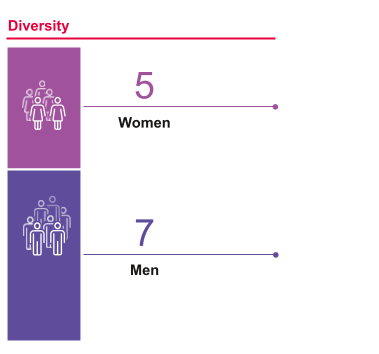
Appropriate balance in terms of seniority
Maintain an appropriate mix of longer-standing and newer Directors, lending the Board a perfect combination of dynamism and experience.
The objective is achieved.
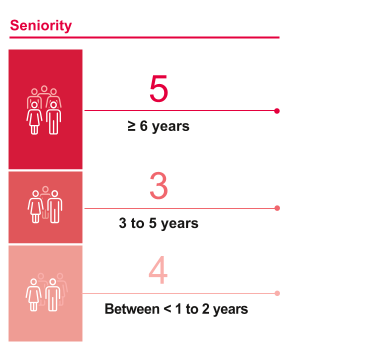
Diversity of skills
Ensure that Directors together have an appropriate range of complementary skills commensurate with the Board’s long-term strategic and development goals. The desired skills cover strategy, finance, digital technology, industry, services, ESG and international experience.
The objective is achieved.
The Directors cover the seven skills defined in the diversity policy. Nine Directors offer at least five of the seven key skills.
In 2022, the Board did not recommend the reappointment of Philippe Lazare for a second term, preferring a candidate possessing the requisite marketing and international expertise (particularly in China).
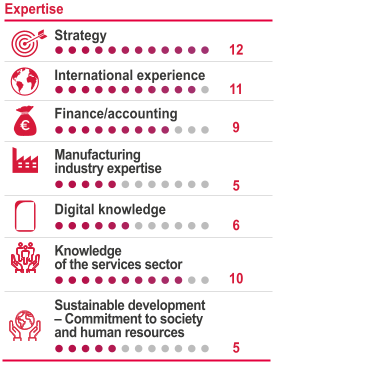
Balanced age structure
Pursuant to article 14 of the by-laws, no more than one-third of members can be over 70 years of age. The objective is to comply with the rule in the by-laws which is satisfactory.
The objective is achieved.
The average age of Directors is 57.
The average age of women on the Board is 54.
The average age of men on the Board is 59.
No Director is over 70 years of age. Directors’ ages range from 48 to 66.
Other remarks
Presence of foreign nationals on the Board of Directors
The Board of Directors tries to have as many foreign nationals as possible on the Board and to diversify the number of countries represented.
In 2022, with time zone and travel restrictions for face-to-face meetings for certain regions, the Board of Directors favored candidates resident in Europe with the requisite skills and experience.
In addition, the Directors have significant international experience or exposure acquired through significant positions or offices exercised abroad or in global companies.
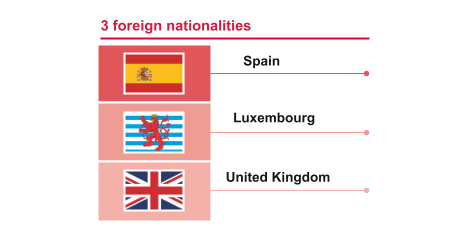
Main skills sought
International experience: previous or current experience as a Chief Executive Officer, Executive Committee member or senior executive in a large entity, or in high-level consulting or managerial functions, internationally or in a group with a global footprint. Experience acquired in international groups. International experience is also proof of the ability to successfully manage a cross-cultural environment, and time spent in a professional capacity in another country or in a corporate office in an international group.
Finance/accounting: extensive experience of corporate finance and auditing processes, financial control and reporting, risk management and insurance, accounting, cash management, taxation, mergers and acquisitions, and capital markets.
Manufacturing industry expertise: expertise in one of the Group’s vertical industries such as construction, real estate, transportation, Oil & Gas, marine & offshore, nuclear, defense, automotive, aerospace, IT, electronics and consumer products (the list is not exhaustive and is as broad and diverse as the Group’s clients). Ideally, this expertise has been acquired from roles held within one of the Group’s clients or competitors, but it can also derive from long-standing commercial operations in this market. It should be complemented by knowledge of the services business.
Digital: expertise or recent experience in developing and implementing technology and/or digital strategies, experience in companies with a strong technology and/or digital focus.
Knowledge of the services sector: experience of the services sector, knowledge of the Group’s businesses and competitive environment, experience in a business sector focused on innovation in BtoBtoS services.
Sustainable development – Commitment to society and human resources: understanding of environmental, social, societal and governance issues as well as knowledge of effectively managing non-financial performance. Sustainable development is a twofold challenge for Bureau Veritas, closely linked to its expertise in the fields of health, safety, quality, environmental protection and human rights, but also to its commitment as a responsible corporate citizen on environmental, social and governance issues.
Expertise of Directors
Name
Strategy
International experience
Finance/
AccountingManufacturing industry expertise
Digital knowledge
Knowledge of the services sector
Sustainable
development –
Commitment to society
and human resourcesAldo Cardoso
●
●
●
●
●
Laurent Mignon
●
●
●
●
●
Christine Anglade Pirzadeh
●
●
●
Claude Ehlinger
●
●
●
●
●
Jérôme Michiels
●
●
●
●
Julie Avrane
●
●
●
●
Ana Giros Calpe
●
●
●
●
Siân Herbert-Jones
●
●
●
Pascal Lebard
●
●
●
●
Lucia Sinapi-Thomas
●
●
●
●
●
Jean-François Palus
●
●
●
●
●
Frédéric Sanchez
●
●
●
●
-
3.3Organization and functioning of the Board of Directors
3.3.1Framework for the work of the Board of Directors
The conditions governing the preparation and organization of the work of the Board of Directors are set out in the Board’s Internal Regulations. The Internal Regulations represent the Governance Charter for Directors. They can be consulted on the Company’s website.
The Board of Directors meets as often as needed in the interests of the Company; meetings are convened by its Chairman. The Board met eight times in 2022, with only one session held by video conference.
The provisional annual schedule of Board of Directors’ meetings (excluding extraordinary meetings) is drawn up and sent out to each member before the end of the first half of the year.
The Statutory Auditors are invited to attend meetings of the Board held to finalize the annual and half-year financial statements.
For each meeting, a file covering the items on the agenda is prepared and sent to each member a few days before the meeting to allow prior examination of documents by the Directors.
During meetings, members of Executive Management give a detailed presentation of the items on the agenda. Each Director is provided with all the information needed to carry out his or her duties and can ask Executive Management to provide him or her with any useful documents (including any critical information about the Company). Presentations are followed by discussions before a vote is taken. Detailed minutes in draft form, summarizing the discussions and questions raised and mentioning the decisions and reservations made, are then sent to members for examination and comment before being formally approved by the Board of Directors.
The Directors may also be provided with useful information about the life of the Company at any time if such information is considered important or urgent.
They may also receive additional training, if they see fit, on the Group, its businesses and sector of activity.
Executive sessions
In accordance with the provisions of the AFEP-MEDEF Code, which recommends that at least one meeting be held each year without the presence of the Executive Corporate Officers, the Internal Regulations provide that the Company’s non-executive Directors meet once a year without the Executive Directors or Company Directors being present, in order to evaluate the performance of the Chairman, the Chief Executive Officer and the Deputy Chief Executive Officer(s).
This meeting is also an opportunity to reflect on the future of the management team. Each year, executive sessions are held (i.e., without the presence of the Chief Executive Officer). The Directors may also meet with the Company’s key executives without the Chief Executive Officer (who is notified in advance).
-
3.4Group management
3.4.1Chief Executive Officer

Didier Michaud-Daniel
Chief Executive Officer
64 years old
Nationality: French
Main business address:
Bureau Veritas, Immeuble Newtime, 40/52 boulevard du Parc, 92200 Neuilly-sur-Seine – France
First appointment:
Appointed Chief Executive Officer on February 13, 2012, with effect from March 1, 2012
Reappointed on February 23, 2017, with effect from March 1, 2017
Reappointed on February 23, 2022, with effect from March 1, 2022
End of term of office: 2023 Annual Ordinary Shareholders’ Meeting
Number of shares held in the Company: 907,300
Biography
Didier Michaud-Daniel was appointed Chief Executive Officer of Bureau Veritas on March 1, 2012. Before taking on this position, he had been President of OTIS Elevator Company since May 2008. He was previously Chairman of OTIS for the UK, Germany and the Central Europe region from August 2004 to May 2008. From September 2001 to August 2004, Didier Michaud-Daniel served as Chief Executive Officer of OTIS UK and Ireland, after 20 years of service at OTIS France. Didier Michaud-Daniel began his career at OTIS in 1981 as a technical salesperson, progressing into sales management and operational support. In 1991, he was appointed Field Operations Director for OTIS France, and in 1992 was promoted to Paris Field and Sales Operations Director. He was named Deputy Chief Executive Officer in charge of Operations in January 1998. Didier Michaud-Daniel is a graduate of France’s École Supérieure de Commerce, with a degree in Business Management, and a graduate of INSEAD. Didier Michaud-Daniel is a Chevalier de la Légion d’honneur.
Other current positions
Member of the Supervisory Board of Tarkett (a)
Positions held within the Group
Chairman of Bureau Veritas International SAS
Positions no longer held (but held in the last five years)
None
Multiple directorships (b)
1 office as Director and 1 as Chief Executive Officer
(a) Listed company.
(b) Pursuant to the recommendation of the AFEP-MEDEF Code, the number of offices held must not exceed the maximum number of offices held as Executive and Non-Executive Corporate Officers, including as a Director of Bureau Veritas SA, i.e., five offices in French or foreign listed companies.
-
3.5Statements relating to Corporate Officers
3.5.1Service agreements involving Corporate Officers or Directors and Bureau Veritas or one of its subsidiaries
-
3.6Other information on governance
3.6.1Summary of delegations of authority and authorizations granted by the Shareholders’ Meeting to the Board of Directors (articles L. 225-37-4 and L. 22-10-10 of the French Commercial Code)
The table below summarizes the delegations of authority and authorizations relating to share capital granted by the Shareholders’ Meeting to the Board of Directors that are still in effect at the filing date of this Universal Registration Document.
Nature of the delegation/authorization granted to the Board of Directors
Date of the Shareholders’ Meeting (SM)
Duration and expiration of the authorization
Maximum nominal amount
Use during the year
Authorization granted to the Board of Directors to trade in the Company’s ordinary shares.
SM of June 25, 2021
(17th resolution)18 months, i.e., until December 24, 2022
Maximum purchase price per share: €45
10% of the share capital (a)
1,915,000 shares bought back in 2022
OSM of June 24, 2022
(18th resolution)18 months, i.e., until December 23, 2023
Maximum purchase price per share: €45
10% of the share capital (b)
Not used
Overall ceiling for capital increases and sub-ceiling for capital increases without preemptive subscription rights for existing shareholders.
SM of June 25, 2021
(18th resolution)- ●Overall maximum nominal amount of capital increases with and without preemptive subscription rights set at €21,600,000 (40%) (c)
- ●Nominal amount of capital increases without preemptive subscription rights set at €5,400,000 (10%) (d)
- ●Overall maximum nominal amount of debt securities: €1,000,000,000 (e)
Not used
Delegation of authority granted to the Board of Directors to increase the share capital with preemptive subscription rights for existing shareholders by issuing (i) ordinary shares in the Company and/or (ii) securities in the form of equity securities giving access immediately and/or in the future to existing or new equity securities of the Company and/or one of its subsidiaries and/or (iii) securities representing debt securities giving or that may give access to new equity securities issued by the Company or any of its subsidiaries.
SM of June 25, 2021
(19th resolution)26 months, i.e., until August 24, 2023
Maximum nominal amount of capital increases: €16,200,000 (30%) (c)
Maximum nominal amount of debt securities: €1,000,000,000 (e)
Not used
Increase in the share capital by capitalizing reserves, retained earnings, share premiums or any other sums that may be capitalized.
SM of June 25, 2021
(20th resolution)26 months, i.e., until August 24, 2023
Maximum nominal amount of capital increases: €16,200,000 (30%)
Not used
Delegation of powers granted to the Board of Directors to issue ordinary shares of the Company and/or securities giving immediate and/or future access to the Company’s share capital, without preemptive subscription rights for existing shareholders, in an amount not exceeding 10% of the share capital, as consideration for in-kind contributions made to the Company.
SM of June 25, 2021
(21st resolution)26 months, i.e., until August 24, 2023
Maximum nominal amount of capital increases: 10% of the share capital (c)(d)
Maximum nominal amount of debt securities: €1,000,000,000 (e)
Not used
Issue of (i) ordinary shares of the Company and/or (ii) securities giving immediate or future access to the Company’s share capital as consideration for securities contributed as part of a public exchange offer launched by the Company, with automatic waiver by existing shareholders of their preemptive subscription rights.
SM of June 25, 2021
(22nd resolution)26 months, i.e., until August 24, 2023
Maximum nominal amount of capital increases: €5,400,000 (10%)(c)(d)
Maximum nominal amount of debt securities: €1,000,000,000 (e)
Not used
Delegation of authority granted to the Board of Directors to issue, by means of a public offering (other than those referred to in article L. 411-2, 1° of the French Monetary and Financial Code), ordinary shares of the Company and/or securities giving immediate and/or future access to the share capital of the Company or a subsidiary, without preemptive subscription rights for existing shareholders.
SM of June 25, 2021
(23rd resolution)26 months, i.e., until August 24, 2023
Maximum nominal amount of capital increases: €5,400,000 (10%) (c)(d)
Maximum nominal amount of debt securities: €1,000,000,000 (e)
Not used
Delegation of authority granted to the Board of Directors to issue, by means of a public offering referred to in article L. 411-2, 1° of the French Monetary and Financial Code, applying exclusively to qualified investors and/or to a restricted circle of investors, ordinary shares of the Company and/or securities giving immediate and/or future access to the share capital of the Company or a subsidiary, without preemptive subscription rights for existing shareholders.
SM of June 25, 2021
(24th resolution)26 months, i.e., until August 24, 2023
Maximum nominal amount of capital increases: €5,400,000 (10%) (c)(d)
Maximum nominal amount of debt securities: €1,000,000,000 (e)
Not used
Authorization granted to the Board of Directors, in the event of an issue of securities without preemptive subscription rights for existing shareholders under the 23rd and 24th resolutions, to set the issue price on the terms set by the Shareholders’ Meeting, up to a maximum of 10% of the share capital per year.
SM of June 25, 2021
(25th resolution)26 months, i.e., until August 24, 2023
10% of the share capital per 12-month period
Not used
Delegation of authority granted to the Board of Directors to increase, in the event of excess demand, the number of securities to be issued in the event of a capital increase with or without preemptive subscription rights for existing shareholders.
SM of June 25, 2021
(26th resolution)26 months, i.e., until August 24, 2023
15% of the initial issue (c)(d)
Not used
Authorization granted to the Board of Directors to grant stock subscription options, with express waiver by existing shareholders of their preemptive subscription rights, or stock purchase options to employees and/or Corporate Officers of the Group.
SM of June 25, 2021
(27th resolution)26 months, i.e., until August 24, 2023
1.5% of the share capital
Sub-ceiling applicable to Corporate Officers: 0.1% of the share capital (f)
1,041,900 options or 0.23% of the share capital at the grant date
Authorization granted to the Board of Directors to grant existing or new ordinary shares of the Company to employees and/or Corporate Officers of the Group, with automatic waiver of shareholders’ preemptive subscription rights.
SM of June 25, 2021
(28th resolution)26 months, i.e., until August 24, 2023
1% of the share capital
Sub-ceiling applicable to Corporate Officers: 0.1% of the share capital (f)
1,125,410 performance shares or 0.25% of the share capital at the grant date
Delegation of authority granted to the Board of Directors to issue ordinary shares of the Company and/or securities giving immediate and/or future access to the Company’s share capital to members of a company savings plan, without preemptive subscription rights for existing shareholders.
SM of June 25, 2021
(29th resolution)26 months, i.e., until August 24, 2023
Maximum nominal amount of capital increases: 1% of the share capital (c)(d)
Not used
Authorization granted to the Board of Directors to reduce the share capital by canceling all or some of the shares of the Company acquired under any share buyback program.
SM of June 25, 2021
(30th resolution)26 months, i.e., until August 24, 2023
10% of the share capital
Cancellation of 1,915,000 shares in 2022
(a) The maximum amount allocated to the share buyback program is €2,035,012,905, corresponding to a maximum of 45,222,509 shares purchased on the basis of a maximum unit price of €45 (excluding transaction costs) and on the number of shares comprising the Company’s share capital at December 31, 2020. In the event of an acquisition, merger, spin-off or contribution, the treasury shares acquired for this purpose may not exceed 5% of the total number of shares comprising the Company’s share capital.
(b) The maximum amount allocated to the share buyback program is €2,039,956,785, corresponding to a maximum of 45,332,373 shares purchased on the basis of a maximum unit price of €45 (excluding transaction costs) and on the number of shares comprising the Company’s share capital at December 31, 2021. In the event of an acquisition, merger, spin-off or contribution, the treasury shares acquired for this purpose may not exceed 5% of the total number of shares comprising the Company’s share capital.
(c) The overall maximum nominal amount of the capital increases that may be carried out under the 19th, 21st to 24th, 26th and 29th resolutions approved by the Shareholders’ Meeting of June 25, 2021 may not exceed €21,600,000.
(d) The overall maximum nominal amount of the capital increases that may be carried out under the 21st to 24th, 26th and 29th resolutions may not exceed €5,400,000.
(e) The overall maximum nominal amount of securities representing debt securities that may be issued under the 19th and 21st to 24th resolutions approved by the Shareholders’ Meeting of June 25, 2021 may not exceed €1,000,000,000.
(f) The overall maximum number of shares that may be granted under the 27th and 28th resolutions approved by the Shareholders’ Meeting of June 25, 2021 may not exceed 1.5% of the Company’s share capital, it being specified that the sub-ceiling applicable to Corporate Officers will be equal to 0.1% of the Company’s share capital (shared with the 27th and 28th resolutions).
-
3.7Corporate Officers’ compensation
This section was prepared by the Board of Directors in conjunction with the Nomination & Compensation Committee, and sets out:
- ●the compensation policies applicable to Corporate Officers (Directors, Chairman, Chief Executive Officer and Deputy Chief Executive Officer(s)) in respect of their corporate office, pursuant to article L. 22-10-8 I of the French Commercial Code (Code de commerce), which will be the subject of a resolution to be put to the vote at the 2023 Shareholders’ Meeting (see section 3.7.2);
- ●the report on compensation paid in or awarded for 2022, as required under articles L. 22-10-34 I and II and L. 22-10-9 I of the French Commercial Code (see section 3.7.3) and notably including:
- ●the information referred to in article L. 22-10-9 I of the French Commercial Code concerning each Corporate Officer, as well as the ratios measuring compensation awarded to the Chairman and the Chief Executive Officer as a proportion of the compensation paid to Group employees alongside changes in those ratios over the past five years in relation to the Group’s performance, which will be the subject of a resolution to be put to the vote at the 2023 Shareholders’ Meeting pursuant to article L. 22-10-34 I of the French Commercial Code, and
- ●the fixed, variable and extraordinary components of the total compensation and benefits in-kind paid in or awarded for 2022 to the Chairman and the Chief Executive Officer, which are the subject of two separate resolutions pursuant to article L. 22-10-34 II of the French Commercial Code;
- ●the standard tables summarizing the information to be disclosed in the Universal Registration Document on compensation paid or awarded to Corporate Officers by the Company or by any company included in the scope of consolidation, pursuant to article L. 233-16 of the French Commercial Code and in accordance with the AFEP-MEDEF Code and AMF recommendations in this regard (the “AMF Table(s)”) (see section 3.7.4);
- ●the reports required by articles L. 225-184 and L. 225-197-4 of the French Commercial Code on stock option and performance share grants (see section 3.8.3).
The information presented in this section also takes into account the recommendations set out in the AFEP-MEDEF Code, as well as those issued by the AMF on corporate governance and executive compensation in listed companies.
3.7.1Compensation policy for Corporate Officers
The compensation policy for each category of Corporate Officer is reviewed each year to ensure that it complies with applicable regulations, market practices, recommendations of the AFEP-MEDEF Code and of the AMF, and that shareholders’ remarks and the votes cast by shareholders at Annual Shareholders’ Meetings are duly taken into account.
The policies were last reviewed on February 22, 2023 by the Board of Directors, following a recommendation of the Nomination & Compensation Committee. Pursuant to article L. 22-10-8 of the French Commercial Code, each policy is put to the vote of shareholders at the Shareholders’ Meeting. If shareholders reject the policies, the last policies approved will continue to apply.
3.7.1.1Principles and objectives of Corporate Officer compensation
General principles underlying the compensation policy for Corporate Officers
Balance and clarity
The overall compensation structure is in line with the Group’s strategy and objectives to achieve a fair balance between each component of compensation in order to improve performance and competitiveness over the medium and long term.
The Chief Executive Officer’s compensation consists of clearly established components, each linked to a specific objective.
Proportionality and consistency
The policy, mechanisms and levels of compensation awarded to the Chief Executive Officer are set consistently with those applicable to the Group’s other executives.
Each year, the Nomination & Compensation Committee reviews and assesses the appropriateness of the compensation packages and particularly the criteria relating to the award of variable compensation for the coming year.
In order to establish an appropriate level of compensation for each category of Corporate Officer, the Nomination & Compensation Committee relies on the recommendations of an independent external consulting firm to benchmark compensation practices and adopt best governance principles. The ability to attract, motivate and retain world-class executives through competitive compensation is essential to the Group’s success.
Given the Group’s unique characteristics within the SBF 120 index and the European TIC sector, as well as its broad geographic footprint spanning nearly 140 countries across the globe, the benchmarking study is based on the following peer groups:
- ●CAC 40 and Next 20 companies;
- ●similar-sized companies in the Services sector;
- ●companies in the international TIC sector.
The Board of Directors has decided not to introduce a clawback clause for variable compensation, as it considers it unnecessary given the demanding annual objectives underpinning the variable portion. Payment of variable compensation for a given year is subject to the approval of the Shareholders’ Meeting pursuant to article L. 22-10-34 II of the French Commercial Code.
Simplicity and understandability
Each year, the Nomination & Compensation Committee recommends financial and non-financial performance criteria and specific levels of objectives to the Board of Directors. The criteria and levels selected are consistent with the Group’s strategy.
Objectives of the compensation policy
Attractiveness and competitiveness
The structure and level of executive compensation is benchmarked each year against the practices of companies with similar characteristics, challenges and environments, with the help of independent consulting firms. The markets serving as a benchmark in the analysis are the CAC 60 (CAC 40 companies and the top 20 companies of the SBF 120) and the international TIC market.
Reward performance
Performance-based variable pay is a key component of the executive compensation policy. The performance criteria used to determine the annual bonus and long-term incentive plans are demanding, and are aligned with the Group’s strategy and the interests of its shareholders.
Align stakeholders’ interests
The compensation policy is designed to attract, motivate and retain the Group’s high-performing employees and to meet the expectations of shareholders and other stakeholders, particularly by tying compensation to the Group’s performance. The policy is aligned with the Company’s interests and respects Corporate Social Responsibility concerns, thereby ensuring the continuity of the Group’s business.
Executive Committee compensation policy
The compensation policy applicable to Executive Committee members is reviewed annually by the Nomination & Compensation Committee and the Board of Directors, and is in line with the principles and objectives used to determine the compensation policy for the Chief Executive Officer.
- ●fixed compensation;
- ●annual variable compensation;
- ●a long-term incentive plan with the implementation of stock option and/or performance share grants subject to presence and performance conditions.
The performance criteria support the Group’s strategy and take into account the Group’s financial and operating performance as well as criteria related to Bureau Veritas’ Corporate Social Responsibility.
These principles and objectives underpin the compensation structure applicable to all Group employees.
Compensation for all Group employees is made up of fixed compensation and short- and long-term variable components. The short- and long-term variable components compensate individual and collective (financial and CSR) performance. Each employee is eligible for some or all of these components according to his or her responsibilities, skills and performance within the Group.
Annual process for preparing the compensation policy for Corporate Officers
In compliance with the principles of the compensation policy, the Nomination & Compensation Committee applies a strict process when preparing executive compensation so as to enable the Board of Directors to make informed decisions.
Annual review of the compensation policy for Corporate Officers
The compensation policy for Corporate Officers is reviewed annually by the Board of Directors. As part of its review, the Board of Directors – based on the work of the Nomination & Compensation Committee – discusses whether it believes the policy should be revised (in terms of structure, components, level of compensation, etc.) in light of developments within the Group or its markets, and any particular events impacting the Group or its organization. The review is also an opportunity for the Board to assess and ensure that the policy remains consistent and relevant with respect to the objectives set for each category of Corporate Officer.
Possible adaptations and adjustments to the compensation policy for Executive Corporate Officers
In the event of circumstances having a significant impact on a component of the Executive Corporate Officer’s variable compensation and/or on the Company’s performance, and, consequently, likely to alter the Board of Directors’ assessment of an Executive Corporate Officer’s performance, the Board of Directors may decide to adapt or adjust this compensation policy, in accordance with the conditions presented below.
These provisions allow the Board of Directors to ensure that the applicable compensation policy remains in line with the performance and effective involvement of the Executive Corporate Officer, the performance and interests of the Company and the interests of its shareholders and employees.
Accordingly and on an exceptional basis, the Board of Directors will have the power to adapt the performance criteria for annual variable compensation and/or long-term variable compensation and to adjust the parameters attached to those criteria (weightings, thresholds, targets, objectives) both upwards and downwards, in order to take into account the occurrence of exceptional circumstances which could not have been anticipated at the date of drafting of this compensation policy.
The circumstances under which the Board of Directors may use this exceptional power are, in particular, a substantial change in the Group’s scope of consolidation or in the scope of responsibility of the Executive Corporate Officer concerned, or any event beyond the control of Bureau Veritas, such as a change in accounting method or standard, a major external event such as a pandemic or a major geopolitical event, or a structural change affecting the markets, the economy and/or one of the Group's business sectors.
Under no circumstances may these adaptations or adjustments lead to the overall ceiling for the Executive Corporate Officer’s compensation being exceeded or the ceiling for any component of compensation, as defined by this compensation policy, being modified, nor may they call into question the pre-established nature of the compensation criteria.
In such a case, the Board of Directors would make its decision on the recommendation of the Nomination & Compensation Committee, ruling on the matter without the presence of the Executive Corporate Officer concerned. This decision should be reasoned and justified in light of the circumstances that led to it. It shall be communicated as soon as possible to the Company’s shareholders.
It should be noted that the Board of Directors did not derogate from or adjust the compensation policy in 2022.
Changes in governance
The Board of Directors also considered the practical application of the compensation policy if there were to be a change in governance or a new Corporate Officer appointed during the year, either to replace an outgoing Corporate Officer (executive or Director), or to strengthen Executive Management or the Board of Directors as a whole.
- ●in the case of a Director, compensation would be determined in accordance with the compensation policy applicable to Directors (see section 3.7.2.1 below); the Board would therefore take into account the date on which the Director’s term of office starts;
- ●in the case of a Chairman, Executive Corporate Officer, Chief Executive Officer or Deputy Chief Executive Officer, compensation would be set in accordance with the specific compensation policy applicable to the category concerned. The Board of Directors would conduct an overall analysis of the situation of the Corporate Officer in question (skills, experience, role, whether or not he or she works for the Group, etc.) and of the Group (context of the appointment, impact on governance, performance, etc.), in order, in the case of an Executive Corporate Officer, to determine the objectives for the variable portion, level of performance, maximum and weighting in relation to the annual fixed compensation, subject to the ceilings set out in the compensation policy applicable to the Chief Executive Officer and Deputy Chief Executive Officers (if any) (see section 3.7.2.3 below).
Conflicts of interest
The Board of Directors and the Nomination & Compensation Committee are responsible for preventing and managing any conflicts of interest that may arise in the decision-making process, in particular when deciding the compensation of the Corporate Officers. The Chief Executive Officer is involved in the work of the committee, except for any agenda items that concern him. Similarly, the Chairman does not participate in the deliberations concerning his compensation and abstains from participating in discussions on the policy that concerns him.
3.7.1.2Dialogue with shareholders
As part of the dialogue with its shareholders, Bureau Veritas organizes meetings with investors and voting advisory agencies before the Shareholders’ Meeting and throughout the year on topics related to governance and executive compensation. Each year, the Group reviews its policy in light of the feedback received.
In 2022, these meetings provided an opportunity to present to investors and proxies the changes in the compensation policy for Bureau Veritas’ Corporate Officers, submitted to shareholders for approval at the Shareholders’ Meeting of June 24, 2022.
Thanks to the quality of shareholder dialogue within the Group as reported to the Nomination & Compensation Committee, shareholders regularly support the compensation policy put to their vote at the Shareholders’ Meeting, along with the clarification of certain elements and information contained in the compensation policies, the “Say on Pay” or the report on compensation.
Based on work undertaken by the Nomination & Compensation Committee since June 2022 on the issues raised through the shareholder dialogue, it was decided that:
- ●Corporate Social Responsibility (CSR) targets should apply to the variable portion of compensation for all Group executives. These targets were already included in the objectives for the annual variable compensation awarded to the Chief Executive Officer and the members of the Executive Committee;
- ●CSR-related targets should be introduced for the Group’s long-term incentive plans in 2022 and also applied in 2023:
- ●details of the CSR criteria incorporated into the Group’s short- and long-term compensation policy are provided in section 2.6.1;
- ●the introduction in 2023 of objectives linked to the change in Bureau Veritas’ Total Shareholder Return (TSR) in the long-term incentive plans of the Chief Executive Officer and members of the Executive Committee;
- ●as part of ongoing efforts to improve the transparency of information on executive pay, the compensation policies and the report on executive compensation were reviewed by the Nomination & Compensation Committee to further improve transparency. A detailed description of the long-term incentive scheme is provided in section 3.8.3.
- ●the 2023 compensation policy for Directors, as presented in section 3.7.2.1 (ex-ante vote);
- ●the 2023 compensation policy for the Chairman of the Board of Directors, as presented in section 3.7.2.2 (ex-ante vote);
- ●the 2023 compensation policy for Executive Corporate Officers applicable to the Chief Executive Officer and to any Deputy Chief Executive Officers, as presented in section 3.7.2.3 (ex-ante vote);
- ●the report on executive compensation (covering Directors, the Chairman of the Board and the Chief Executive Officer) paid or awarded in 2022, as presented in section 3.7.3 (ex-post vote);
- ●the “Say on Pay” relating to the Chief Executive Officer, as presented in section 3.7.3.4;
- ●the “Say on Pay” relating to the Chairman of the Board, as presented in section 3.7.3.4.
-
3.8Interests of Corporate Officers, Directors and certain employees
3.8.1Interests of Corporate Officers and Directors in the Company’s capital
At the publication date of this Universal Registration Document, the interests of Corporate Officers and Directors in the capital of Bureau Veritas were as follows:
Didier Michaud-Daniel, Chief Executive Officer, holds 907,300 shares, representing 24.7 x his annual compensation for 2022, at a per-share value of €24.49 (the reference price on June 21, 2022).
Didier Michaud-Daniel, Chief Executive Officer, also holds 1,708,728 stock options granted under the July 15, 2015, June 21, 2016, June 21, 2017, June 22, 2018, June 21, 2019, June 26, 2020, June 25, 2021 and June 14, 2022 plans.
A detailed description of stock option plans is provided below in section 3.8.3.3 – Stock subscription or purchase options, of this Universal Registration Document.
Directors
Number of shares
Percentage of capital
Aldo Cardoso
12,351
NS
Laurent Mignon
1,200
NS
Christine Anglade Pirzadeh
1,200
NS
Claude Ehlinger
1,230
NS
Ana Giros Calpe
1,200
NS
Julie Avrane
1,200
NS
Siân Herbert-Jones
1,224
NS
Pascal Lebard
1,200
NS
Jean-François Palus
1,200
NS
Lucia Sinapi-Thomas
2,040
NS
Frédéric Sanchez
1,200
NS
Jérôme Michiels
1,200
NS
-
Risk factors and management
-
4.1Risk factors
Investors are advised to carefully read the financial and non-financial risks described in this section, as well as the other information contained in this Universal Registration Document, before taking any investment decisions.
In accordance with Regulation (EU) No. 2017/1129 (“Prospectus III”) and in compliance with the ESMA Guidelines, at the date this Universal Registration Document was filed, the risks presented below are the main risks considered specific to the Bureau Veritas Group and/or to its securities that Bureau Veritas believes could have a significant net impact on the Group, its businesses, its financial position, its earnings and/or its outlook should they materialize. The occurrence of one or more of these risks could result in a decrease in the value of the Company’s shares, and investors could lose all or part of their investment.
The Group’s various operating departments, as well as support functions both in and outside France, identify and assess risk along with the related risk management procedures on an ongoing basis. Reports are regularly submitted to the Executive Committee, the Audit & Risk Committee and the Board of Directors. They help to prepare and update the risk map described in section 4.2 – Internal control and risk management procedures, of this Universal Registration Document.
The Group has also taken out various insurance policies, as described in further detail in section 4.3 – Insurance, of this Universal Registration Document. The Group’s insurance strategy is to best protect the Group’s employees and assets against the occurrence of identified major insurable risks that may affect it.
In any event, other risks that Bureau Veritas does not consider to be specific to its businesses as they generally also concern other issuers in varying degrees, regardless of their activities, such as risks related to the climate, international economic sanctions or exchange rate fluctuations, could also have an adverse impact on the Group, its businesses, its financial position, its earnings and/or its outlook. Other risks may exist or may come to exist that are not known by Bureau Veritas at the date of this Universal Registration Document or that are presented in other sections of the Universal Registration Document and considered at that date unlikely to have a significant adverse impact on the Group, its businesses, its financial position, its earnings and/or its outlook should they materialize.
In 2020, as part of the work to update the Group’s risk map, all Group-wide processes for preparing the map were reviewed. This task involved all Operating Groups and support functions (see section 4.2.1 – Organization and general approach to internal control and risk management, of this Universal Registration Document). A total of 40 key risks were identified, including risks specific to the Group’s businesses.
- ●cybersecurity risk is now included in the risk factors, in the “Risks related to the Group’s operations and activities” category;
- ●the seven risks discussed in the 2019 Universal Registration Document published in March 2020 correspond to other risks specific to the Group and are described below.
In 2022, the Group’s risk map was updated, with input from the members of the Executive Committee and the network of Risk Managers in each Operating Group. This update was reviewed in January 2023 by the Board of Directors’ Audit & Risk Committee. The updated risk map takes into account the impact of the action plans implemented in 2021 and 2022, as well as changes in the Group’s internal and external environment. This revision did not result in any changes to the risk factors or their net impact, as described below.
- ●risks related to the Group’s operations and activities;
- ●risks related to human capital;
- ●risks related to acquisitions.
Risks are classified within their respective category in decreasing order of importance as determined by the Company based on the probability that the risks will materialize and the estimated extent of their impact on the Group, its businesses, its financial position, its earnings and/or its outlook, and after applying any risk mitigation measures. The order of importance as determined by Bureau Veritas could change at any time, in light of new external facts or circumstances, developments in the Group’s businesses, or changes in the impact of measures to manage and mitigate risks.
For certain risks, references are made to specific chapters or sections of this Universal Registration Document in which they are discussed in more detail. Internal control and risk management procedures in place within the Group are described in section 4.2 – Internal control and risk management procedures, of this Universal Registration Document.
Risk factors are assessed in terms of (i) frequency or probability of occurrence, (ii) gross impact (i.e., the impact if there were no risk prevention or mitigation measures), and (iii) the level of control of the organization. The table below shows the results of this net impact risk assessment. Each of the risk factors shown is ranked “low”, “medium” or “high” on the risk scale.
Low
Medium
High
Net impact
●
●●
●●●
4.1
Risk factors
Net impact
4.1.1
Risks related to the Group’s operations and activities
Cybersecurity risk
●●●
Legal risk related to changing regulations
●●
Risk related to the non-renewal, suspension or loss of certain authorizations
●●
Ethics risk
●●
Risk related to litigation or pre-litigation proceedings
●●
Risk related to the production of forged certificates
●
4.1.2
Human risks
Risks related to human capital
●●
4.1.3
Risks related to acquisitions
Risk of impairment of intangible assets resulting from acquisitions
●
In 2022, major geopolitical and economic events emerged, while Covid-19 continued to impact some parts of the world.
The effects of the Covid-19 pandemic and the increase in global geopolitical tensions were not considered to call into question the frequency, impact, nature or classification of Bureau Veritas’ risks, as shown in the Group risk map. However, some risks are likely to be accelerated.
4.1.1Risks related to the Group’s operations and activities
Cybersecurity risk
Description
After two years of Covid-19 and the adaptations it required, 2022 was shaped by the lasting transformation in the use of IT systems. Remote rather than in-office working remained the norm to a large extent, and led to the use of new digital tools and solutions. The war in Ukraine also changed the risk landscape along with the behavior and modus operandi of cyber criminals.
User exposure to a hybrid workspace – company intranet and Internet – continually raises cybersecurity risk over the long term.
In this context, the Group constantly reviews cybersecurity risk to ensure a swift response and is further accelerating its transformation by stepping up measures to protect its business-critical systems and infrastructures:
- ●the expectations and requirements of the Group’s clients in terms of IT security are also constantly growing. Maturity and leadership in cybersecurity and in data protection are therefore directly correlated with clients’ trust in the Group and its growth trajectory;
- ●the Group’s activities and processes increasingly rely on technical infrastructure and IT applications to deliver services;
- ●the Group’s international presence requires multiple, interconnected information systems able to process increasing volumes of data. Malfunctions or shutdowns related to external threats (viruses, hacking) or internal threats (malicious acts, violation of data protection) could lead to an inability to ensure continuity of service for the critical information systems that host operating, financial and strategic information, to lost or leaked information, delays and/or additional costs representing a risk for Bureau Veritas’ strategy and business continuity. If these databases and the related back-ups were destroyed or damaged for any reason whatsoever, the Group’s business could be disrupted.
As part of its business, the Group collects and processes personal data. Within the European Economic Area (EEA), the Group is subject to Regulation (EU) No. 2016/679 of the European Parliament and of the Council on data protection (hereafter the “Regulation”). The Regulation requires a high level of transparency, particularly with regard to data subjects, and increases corporate accountability (elimination of upstream controls of processing tasks, obligation to document any decision made with regard to processing [accountability principle], obligation to report any breach to the competent supervisory authorities, etc.) and the amount of criminal penalties applicable in cases of non-compliance. Similar regulations protecting data privacy also apply in other regions (e.g., Canada, Singapore and Australia) and concern all Bureau Veritas Operating Groups.
Risk control and mitigation measures
The risk control and mitigation measures implemented by Bureau Veritas with respect to cybersecurity include the following:
- ●protection against malicious acts: central security systems have been devised and put in place, offering protection against software attacks (viruses, phishing, etc.), and against attempts to hack into the Group’s systems. These security measures and policy are audited every year by a specialized independent company, which simulates intrusion attempts in addition to its audit work;
- ●new technologies have been introduced to improve Bureau Veritas’ protection, detection and response capabilities, in particular PCs, servers and mobile devices;
- ●a Security Operations Center (SOC) was set up in 2020, covering the Bureau Veritas network, critical infrastructures, back-up systems and the cloud. The SOC has advanced capabilities for managing threats or responding to incidents;
- ●leading-edge, secure solutions for identity authentication, management and governance were deployed in 2022; two-factor authentication was set up for each user;
- ●a partnership has been put in place with an application security specialist to perform vulnerability scans and penetration testing, including via ongoing cooperation with the Operating Groups and the central IT teams;
- ●a Disaster Recovery Plan (DRP) has been developed for the Group’s main data centers and its cloud, enabling them to migrate their critical software and infrastructure to an alternative data center in the event of a major disaster, with minimal loss of data;
- ●a charter defining the rights and responsibilities of Group information system users in terms of cybersecurity has been introduced;
- ●training and awareness-raising sessions have been organized for all Group users (employees, partners and suppliers) since 2019, helping to reduce vulnerability to hacking and the risk that viruses and other threats will spread;
- ●collaborative messaging and advanced security solutions designed to reinforce multi-factor authentication and increase protection against phishing have been rolled out across the Group;
- ●efforts have been made to avoid technologies and solutions becoming obsolete, leading to the large-scale introduction of cloud-based solutions (SaaS as a priority), alongside more timely upgrades and security updates.
Data confidentiality and security, particularly in terms of personal data, is one of the issues taken up in the Group’s Compliance Program. This program puts in place the measures needed to enhance the Group’s procedures and organization in terms of personal data protection. Data protection risk control and mitigation measures implemented by Bureau Veritas include:
- ●training and awareness-raising sessions are organized for the Group’s employees (senior management, headquarters staff, IT and HR teams, etc.);
- ●legal and technical measures have been put in place to serve as a framework for ensuring that all processing of personal data within Bureau Veritas complies with the applicable laws and regulations;
- ●all employees and all external users are briefed on the Group’s applicable data protection policies;
- ●procedures are in place to allow individuals to exercise their rights to privacy and to enable a record of processing activities to be kept and any data breaches to be reported and notified to the competent supervisory authority;
- ●contracts with external service providers now include stricter requirements: in addition to the provisions regarding the processor’s obligations under the Regulation, the Group’s contracts now also contain the security measures that must be implemented by the service provider.
Potential impacts on the Group
Cybersecurity risk could have:
- ●financial consequences (loss of client contracts, operating losses, penalties, etc.);
- ●consequences on the Group’s reputation (unlawful disclosure of confidential and personal data, loss of accreditations and/or approvals to provide certain services); and/or
- ●legal consequences (liability with regard to legal entities and/or individuals on which the Group holds information).
Failure to comply with such regulations could result in criminal and/or financial penalties for the Group and harm its reputation.
Changes in the risk in 2022
The measures approved in the wake of the ransomware attack on Bureau Veritas at the end of 2021 were implemented in 2022.
Three key initiatives were launched and rolled out:
- ●deployment of an EDR solution to protect all Group servers and PCs. Implementation of XDR, an advanced threat detection technology;
- ●deployment and configuration of new market-leading solutions for identity and access management for all Group users;
- ●implementation of a “Zero Tolerance” policy for PC equipment, server and network compliance. This program has significantly improved compliance in these areas.
In 2023, the focus will be on strengthening and systematizing user, client and data protection, compliance and resilience by:
- ●continuing the identity and access management (IAM) program for enhanced data protection and integrating the IAM with EDR/XDR and SASE network technologies;
- ●pursuing zero-tolerance policies for non-compliant IT equipment and IT stakeholder awareness initiatives to ensure the ongoing compliance of “Security and Privacy by Default” applications and infrastructure and maintaining the security enhancement program for privileged accounts;
- ●adopting new technologies for network security and cloud access and implementing “Zero Trust” architecture by integrating and combining technologies and processes for managing identity and access, IT equipment and networks.
Despite the measures in place, there is no such thing as zero risk. The Group will continue to strengthen its preparedness to deal with cyber incidents and attacks.
Legal risk related to changing regulations
Description
The Group conducts its business in a heavily regulated environment, with regulations sometimes differing widely from one country to the next. Most of Bureau Veritas’ business activities involve inspecting, testing or certifying its clients’ compliance with all types of benchmarks and standards (derived from regulations or contracts), and this often requires it to obtain the necessary licenses and authorizations from the relevant public or private bodies.
These regulatory frameworks are therefore at the heart of most of the Group’s operating activities and directly determine its capacity to exercise its TIC activities (see section 4.1.2 – Human risks) as well as the operating conditions in which it conducts them.
Amid the economic downturn, clients affected by a possible reversal in their business cycle could be inclined to encourage, advocate (through lobbying efforts) or even demand a relaxation in controls or a reduction in the number of required inspections, tests or certifications performed by their TIC services provider. In this regard, private regulatory frameworks (not resulting from legislation but from contractual standards imposed by clients on their suppliers), such as in the oil and gas sector or retail industry for example, would be the first to be affected by a reduction in the number of tests and/or inspections.
Furthermore, increased competitive pressure on testing, inspection and certification activities could drive an acceleration in efforts to harmonize international or cross-industry benchmarks and standards with which Bureau Veritas clients regularly need to demonstrate their compliance in order to act in accordance with applicable laws and regulations. This would lead to the trivialization and commoditization of the services sold by the Group.
If the trend were to swing the opposite way, it would lead to fragmentation owing to a decoupling of the Chinese, US and European economies. Certain countries could also choose not to allow private or foreign companies to engage in the local TIC market, or may decide to change the rules for conducting business such that the Group can no longer operate in those countries.
Risk control and mitigation measures
The Group endeavors to monitor all of these changes through its regulatory intelligence in order to anticipate, monitor and give its input to the competent authorities when new regulations are being drafted.
As a member of national and international associations of the TIC profession, including the TIC Council (formerly the International Federation of Inspection Agencies – IFIA) and the International Association of Classification Societies (IACS), Bureau Veritas is able to keep informed of any such regulatory changes.
Potential impacts on the Group
It follows that changes in regulations applicable to the Group’s businesses may be either favorable or unfavorable. Stricter regulations or stricter enforcement of existing regulations, while creating new business opportunities in some cases, may also result in new conditions for the Group’s activities that increase its operating costs, limit the scope of its businesses (for example, in connection with real or perceived conflicts of interest) or more generally slow Bureau Veritas’ development.
In particular, important changes in regulations or legislation applicable to the Group’s businesses in the principal countries where it operates may lead to frequent, or even systematic, claims involving the professional liability of employees, the Company or its subsidiaries. The Group could face multiple lawsuits and may be ordered to pay substantial damages, despite the fact its services were provided in the jurisdiction prior to any regulatory changes. In extreme cases, such changes in the regulatory environment could lead Bureau Veritas to exit certain markets where it considers the level of regulation to be overly restrictive.
A relaxation in requirements or harmonization of laws, regulations, benchmarks and standards which form the basis of Bureau Veritas’ testing, inspection and certification services, would potentially have a negative impact on revenue. This would also be the case if its clients relaxed the requirements imposed on their supply chains (standards, regulations and contractual requirements controlled by the Group). A decoupling of the Chinese, US or European economies would impact operating profit due to a potential increase in compliance costs or in the costs incurred to adapt Group facilities in different countries for certain laboratories.
Changes in the risk in 2022
On the whole, the analysis of this type of risk inherent to the Group’s TIC activities in 2020 and 2021 remained relevant in 2022, leading Bureau Veritas to consider:
- the impact of deteriorating economic conditions on the financial health of its clients, potentially leading to pressure on the regulator to:
- ●relax or push back the introduction of new mandatory standards and regulations,
- ●reduce the number of tests, inspections and certifications usually carried out by the Group on behalf of its clients (when they are not required by law or regulations);
- the impact of increased competitive pressure (via the trivialization and commoditization of the services sold by the Group) resulting from an acceleration in efforts to harmonize international or cross-industry standards, rules and regulations with which its clients have to comply;
- changes in the geopolitical situation leading to increased protectionism and a decoupling of the Chinese, US and European economies, with a resulting reduction in international trade between these regions and countries.
Risk related to the non-renewal, suspension or loss of certain authorizations
Description
Much of the Group’s business requires it to obtain and maintain accreditations, approvals, permits, delegations of authority, official recognition and authorizations more generally (hereafter referred to as “Authorizations”) at local, regional or global level, issued by public authorities or by professional organizations following long and often complex review procedures.
Most Authorizations are granted for limited periods of time and are subject to periodic renewal by the authority concerned. For some of its businesses (in particular Government Services in the Agri-Food & Commodities business and Marine & Offshore), the Group (or division concerned) must be an active member of certain professional organizations in order to be eligible for certain projects.
Although the Group closely monitors the quality of services provided under these Authorizations, as well as the renewal and stability of its Authorizations portfolio, any failure to meet its professional obligations or conflicts of interest (real or perceived as such), could cause Bureau Veritas to lose one or more of its Authorizations either temporarily or on a permanent basis. A public authority or professional organization which has granted one or more Authorizations to the Group could also unilaterally decide to withdraw such Authorizations.
Government Services (included within the Agri-Food & Commodities business), and in particular Destination Inspection or Technical Assistance to Customs, Verification of Conformity (VOC) and Single Window (SW) solutions, involve a relatively limited number of programs, contracts and accreditations (hereafter referred to as “Contracts”) signed with or granted by governments or public authorities (“Authorities”).
These Contracts, awarded within the scope of international calls for tender, have terms of between three and five years (sometimes ten years for Single Windows). Since the ultimate purpose of these Contracts is to transfer expertise to the Authorities, they are often not renewed and the related operations are often discontinued once the expertise has been transferred to said Authorities. This could cause revenues in the country concerned to suddenly dry up.
However, certain Contracts that are not renewed may be supported by local teams in the form of technical assistance provided to the Authorities, allowing operations to continue in that country.
Risk control and mitigation measures
For each of its businesses, Bureau Veritas has put in place a specific organization for managing and monitoring Authorizations. The management of Authorizations used in several countries was reinforced in 2017, particularly in the Agri-Food & Commodities, Certification, Industry and Marine & Offshore businesses, through optimum organization and implementation of control tools (especially employee qualification management and supervision, Internal Audit management, shared service centers to monitor execution, and Commitment Committees to analyze and prevent conflicts of interest). These tools and systems are regularly reviewed and enhanced by the Group.
Centralized management of international Authorizations has been stepped up and their geographic footprint streamlined in order to limit the Group’s exposure to the risk of losses. Internal initiatives aimed at raising awareness of potential conflicts of interest and accreditation requirements have also been rolled out so that the risks associated with Authorizations can be better understood and addressed.
To reduce its exposure, Bureau Veritas endeavors to diversify the geographic footprint of its portfolio of Government Services businesses and to structure its programs so that services are paid for by the operators and not by the relevant governments. By engaging in ongoing intensive diplomatic and commercial efforts, the Group is also better able to anticipate crises and manage such risks if they were to arise.
Lastly, Bureau Veritas seeks to secure its Contracts as far as possible with the help of its internal and external counsel. Additional information on these Authorizations and their management is provided in section 1.6 – Accreditations, approvals and authorizations and section 4.2 – Internal control and risk management procedures, of this Universal Registration Document.
Potential impacts on the Group
The non-renewal, suspension or loss of any of these Authorizations and Contracts, or of its position as member of certain professional organizations, could have a significant adverse effect on the Group’s business, financial position, earnings or outlook.
For example, in Government Services, the Group has around 30 Contracts of the type described above, most of which involve services for countries in Africa, the Middle East and Asia. These Contracts, which represent aggregate revenue of around €180 million, are generally for a period of one to three years (or ten years for Single Window). Many of them are subject to local administrative law and may be unilaterally terminated at short notice at the discretion of the government or authority concerned. They are also subject to the uncertainties inherent in conducting business in emerging countries, some of which have been or could be subject to political or economic instability, sudden and frequent changes in regulations, civil war, violent conflict, social unrest or actions of terrorist groups. The suspension, cancellation or non-renewal of even a small number of these Contracts could have a significant adverse effect on the Group’s business, financial position, earnings or outlook.
In addition, in performing the Contracts entered into with governments or public authorities, the Group may face difficulties in collecting amounts receivable, and the collection process could prove long and complex. The non-payment or late or partial payment of substantial sums owed under these Contracts could also have a significant adverse effect on Bureau Veritas’ business, financial position, earnings or outlook.
Changes in the risk in 2022
The risk related to the non-renewal, suspension or loss of certain Authorizations is still declining thanks to prevention measures rolled out by the Group.
Ethics risk
Description
The Bureau Veritas brand is that of a recognized world leader operating with unparalleled know-how, independence, objectivity and integrity for almost two centuries. Independence, objectivity and integrity are the foundation of trust, and trust is at the heart of Bureau Veritas’ relations with its clients. The Group’s communications are a tangible demonstration of its commitment to “Shaping a World of Trust”. Ethics has long been an “absolute” for Bureau Veritas, which strives to enforce strict ethical values and principles in conducting its business (principles of transparency, honesty and integrity, fight against corruption, fair employment, health and safety). However, the risk of isolated acts in breach of these values and principles by Group employees, agents or partners cannot be ruled out. These may include employee actions or failures to act in the face of corruption in order to secure personal gain, facilitate business development, avoid or settle disputes or fast track administrative decisions, as well as fraudulent acts, conflicts of interest, anti-competitive practices, violation of international economic sanctions, and more.
In terms of ethical conduct, Bureau Veritas believes its main risk exposure to be the passive corruption of a Group employee during an audit carried out at a client’s premises or at the premises of one of the client’s suppliers on behalf of that client. This risk increases when (i) the client or company audited is located in a jurisdiction where corruption is considered to be endemic, culturally accepted or commonly attempted, or (ii) the audited entity’s business or the development of that business depends on the delivery of a favorable report by a Group employee. Failure to comply with independence or objectivity rules (which may or may not result from an act of passive corruption) is also considered a major risk for the Group.
In addition, in performing the Contracts entered into with governments or public authorities, the Group may face difficulties in collecting amounts receivable, and the collection process could prove long and complex. The non-payment or late or partial payment of substantial sums owed under these Contracts could also have a significant adverse effect on Bureau Veritas’ business, financial position, earnings or outlook.
Risk control and mitigation measures
Thanks to the deep-seated and broadly publicized commitment of its Executive Management team, the Group has set up a Compliance Program. This includes a Code of Ethics and a manual of internal rules and procedures applicable to all employees, a dedicated central and regional internal organization, a whistleblowing hotline, specific training courses, and a corruption risk map, as well as third-party due diligence and audit procedures, which fall under the responsibility of the Group’s Ethics Committee. Any incidents of identified non-compliance with the Group’s ethical standards are subject to disciplinary measures. These risk management procedures are audited every year.
The Group’s Compliance Program is described in further detail in section 4.2 – Internal control and risk management procedures and in section 2.5.1 – Ethics, of this Universal Registration Document.
Potential impacts on the Group
Group employees, executives or companies may be held liable for any failure to comply with ethical principles and standards. This risk is heightened by the number and variety of the commercial partners working with Bureau Veritas (intermediaries, partners and subcontractors) and by the fact that the Group does business in certain countries that are particularly well known for corruption risk. This situation could therefore lead to penalties – particularly financial penalties – and/or affect Bureau Veritas’ reputation and image, and adversely impact its businesses, financial position, earnings and/or outlook.
As well as legal and administrative penalties and reputational harm, failure to comply with the Group’s ethical principles and standards could render stakeholders liable as well as result in the loss of accreditations, approvals, delegations of authority, official recognition and more generally, of authorizations issued by public authorities or professional organizations.
Changes in the risk in 2022
The ethics risk remains intrinsically the same from one year to the next. The degree of management improves as new and ever stricter procedures and controls are put in place.
Risk related to the production of forged certificates
Description
The Group’s main mission is to ensure that products, assets and systems comply with a given framework (mainly standards and regulations in terms of quality, safety, environmental protection and social responsibility). Bureau Veritas acts as an independent body and issues reports and certificates stating that products, assets and systems conform to applicable standards and regulations. Certification enables companies to conduct their business activities (e.g., place products on the market), access new markets or strengthen their reputation.
Since obtaining certification is often vital for companies, Bureau Veritas is exposed to the risk that its reports or certificates are falsified or tampered with, or that counterfeit reports or certificates are issued, infringing Bureau Veritas’ trademarks and/or copyright. The production of forged or counterfeit reports can result from employee conduct or, more commonly, external sources (fraudulent behavior by a client or third party in order to meet regulatory requirements).
Risk control and mitigation measures
A policy aimed at preventing counterfeit certificates and reports has been in place in the Group since 2015. Whenever there is a suspected case of forged or counterfeit certificates, the Group conducts an investigation to rapidly identify the source and authors of the forgeries/counterfeits. Where applicable, it informs clients, accreditation bodies and, if necessary, government and customs authorities in accordance with applicable legal and regulatory requirements. Legal and criminal proceedings are also initiated to put a stop to the fraud and seek damages for the harm suffered by the Group. Penalties may be adopted against those responsible.
For example, an employee was suspended and subsequently dismissed after it was discovered he had tampered with the results of analyses. Clients and the relevant legal authorities were immediately notified of the discovery.
The Group’s Compliance Program, described in further detail in section 4.2 – Internal control and risk management procedures and in section 2.5.1 – Ethics, of this Universal Registration Document, helps to prevent and, where necessary, detect any fraud resulting from inappropriate employee conduct.
To address external counterfeit risks, the Group has developed technologies using timestamping, electronic signatures and QR codes for certificates or reports in a bid to reduce the risk of forged or counterfeit certificates and improve the traceability of the reports and certificates issued by Bureau Veritas.
Potential impacts on the Group
This situation could lead to legal proceedings (civil and criminal), jeopardize the Group’s ability to maintain or renew the Authorizations it needs to pursue certain activities, result in the withdrawal of certain products from the market and/or damage the reputation of the Group and the TIC industry in general. It could also adversely and significantly impact Bureau Veritas’ businesses, reputation, image, financial position, earnings and/or outlook.
Changes in the risk in 2022
The risk of forged certificates or reports remains stable, even though developments in information technologies could make such counterfeits either easier to produce and/or harder to detect or identify, despite the Group’s efforts in this regard.
Accordingly, the Group stepped up very significantly the deployment of technologies aimed at protecting against forgery and improving the traceability of reports and certificates in order to provide protection for all of its businesses. These technologies notably allow end users to verify document authenticity and content accuracy online.
Risk related to litigation or pre-litigation proceedings
Description
As for any TIC company, the nature of Bureau Veritas’ testing, inspection and certification activities is such that there is an inherent risk of the quality and pertinence of its work and findings being called into question in the event that flaws are subsequently identified or should major incidents occur.
What makes these types of claims different is that inspection companies can be held liable for sums that are often disproportionate in light of the amounts actually paid for the services provided.
In the normal course of business, the Group is therefore involved in a large number of litigation or pre-litigation proceedings seeking to establish its professional liability on a contractual or extra-contractual basis in connection with services provided.
Bureau Veritas is particularly exposed in terms of (i) frequency of occurrence: due to France’s Spinetta law of January 4, 1978, which establishes a presumption of joint and several liability for technical inspectors, the Group’s Construction business in France sees significant, recurring claims and the Group’s creditworthiness could also encourage third parties to make claims against it; (ii) timing: there may be a substantial delay between the date services are provided and the date a legal claim is filed or a legal decision is handed down (certain proceedings can last between 10 and 20 years); (iii) financial penalties: services provided for hundreds or thousands of euros can give rise to claims seeking several millions of euros in damages; and (iv) geographic presence: the Group operates in almost 140 countries, including countries whose legal and political systems can be unpredictable.
To put pressure on Bureau Veritas, in addition to litigation, some claimants readily initiate administrative or even criminal proceedings that are unfounded but can harm the Group’s image, for example proceedings seeking to call into question licenses granted to the Group.
Accordingly, we cannot rule out that new claims may be made against a Group company in the future, leading to substantial liability for the Group and thus having a significant adverse effect on the Group’s business, financial position, reputation, earnings or outlook. A detailed description of major legal proceedings to which the Group is a party is provided in section 4.4 – Legal, administrative and arbitration procedures and investigations, of this Universal Registration Document.
Risk control and mitigation measures
Bureau Veritas has implemented procedures aimed at preventing, monitoring and managing litigation. These procedures are described in section 4.2 – Internal control and risk management procedures, of this Universal Registration Document.
The Group’s legal experts work closely alongside its lawyers across the globe to manage these risks as effectively as possible. The Group also seeks to significantly insure itself against all financial consequences of claims asserting professional liability.
Provisions may be set aside to cover expenses resulting from such proceedings. The amount recognized as a provision is the best estimate of the expenditure required to settle the present obligation at the end of the reporting period. Details of total provisions for contract-related disputes are provided in section 6.6 – Notes to the consolidated financial statements, Note 27 – Provisions for liabilities and charges, of this Universal Registration Document.
Potential impacts on the Group
Substantial fines or damages handed down by a court in respect of an incident not insured by a pertinent insurance policy and not adequately provisioned for could have a significant adverse impact on the Group’s consolidated financial statements.
Moreover, multiple awards leading to substantial payouts from insurers under the Group’s insurance policies could result in a sharp rise in insurance premiums due to the negative claims history.
Changes in the risk in 2022
The Group’s efforts to manage this risk as effectively as possible by fine-tuning internal processes and extending insurance coverage are paying off. The Group’s civil liability claims history remained stable, although there is no guarantee this trend will continue owing to the global economic, commercial, political and legal environment in which the Group operates.
-
4.2Internal control and risk management procedures
4.2.1Organization and general approach to internal control and risk management
Main internal control and risk management stakeholders
Executive Management
Group Executive Management ensures that internal control objectives are set, particularly with respect to the control environment, risk assessment and management, internal control processes, reliable financial information and Group business management, based on the principles and organization previously defined by the Board of Directors.
- ●recognition of the full accountability of the management of Group companies;
- ●regular financial reporting;
- ●monitoring of relevant indicators by the different Group departments; and
- ●regular and occasional reviews of specific items as part of a formal or one-off process.
Where necessary, however, this general framework is adjusted for simplicity purposes so that the internal control process continues to be aligned with the size of the companies within the Group and so that the management teams of Group entities can duly discharge their responsibilities.
Audit & Risk Committee
In accordance with article L. 823-19 of the French Commercial Code (Code de commerce), the Audit & Risk Committee is chiefly responsible for monitoring the process of preparing financial information, the effectiveness of internal control and risk management systems and, where applicable, those of Internal Audit, and the independence of the Statutory Auditors.
After each meeting, the Chairman of the Audit & Risk Committee prepares a detailed report of the Committee’s work, proposals and recommendations for the Board of Directors.
Details of the work of the Audit & Risk Committee during 2022 are provided in section 3.3.7 – Committees of the Board of Directors, of this Universal Registration Document.
Internal Audit
The Internal Audit department reports to the head of Legal Affairs & Audit. To reinforce the department’s independence, it also reports functionally to the Chairman of the Audit & Risk Committee since the end of 2018.
The role of the Internal Audit department is to perform audits, principally financial audits, in the various entities of the Group. The entities to be audited are selected at the time of preparing the annual audit plan, which is discussed with Executive Management and validated by the Audit & Risk Committee. They are chosen primarily based on the risks identified, the resulting financial implications and previous internal or external audits. This formal, structured approach is designed to ensure adequate audit coverage for the Group’s entities over several years. In addition, the Internal Audit department oversees the Group’s recently acquired entities and regularly liaises with the Legal, Risk, Assurance and Compliance functions as part of its work.
In 2022, as the pandemic continued to affect several parts of the world, certain audit assignments were performed remotely by internal auditors. This enabled internal audit arrangements to be maintained, despite a deterioration in the conditions in which the assignments were performed.
These audits are aimed at analyzing and verifying that management and reporting rules are duly applied, as well as reviewing the quality of the internal control environment. The main procedures and cycles covered are:
- ●billing and revenues;
- ●purchasing, subcontracting and accounts payable;
- ●Human Resources;
- ●cash management;
- ●tax;
- ●financial statement closing procedures and reporting;
- ●the Group Compliance Program; and
- ●IT risks.
In addition, a review of the financial performance of the Group’s businesses is conducted when each audit assignment is carried out to verify the consistency of all the financial information produced by the entity being audited. The Internal Audit team continued its audit procedures relating to the Group’s Corporate Social Responsibility policy.
The audit reports are sent to the managers of the operating entities and to their superiors, the central operating departments and Group Executive Management. Audit reports set out remedial action plans for improving the control environment.
The Internal Audit department systematically monitors implementation of the action plans drawn up following Internal Audit assignments through a dedicated software program accessible to the audited departments, and gives Executive Management a monthly progress update on the implementation of recommendations.
In 2022, the implementation rate of recommendations issued by the Internal Audit department averaged just over 80%.
In addition to the annual audit program, the Internal Audit department heads up an internal control self-assessment campaign via the distribution of two questionnaires across the Group (see “Internal control framework and general principles”).
Group Compliance Officer
The Group Compliance Officer reports to Executive Management and draws on the resources of the Legal Affairs & Audit department.
The Group Compliance Officer is the head of the Bureau Veritas Compliance Program and a member of the Group’s Ethics Committee, which also comprises the Group Chief Executive Officer, the Deputy Chief Executive Officer, the Group Chief Financial Officer, and the Group Chief Human Resources Officer. This Committee deals with compliance issues within Bureau Veritas and supervises the implementation of the Code of Ethics. The Group Compliance Officer also relies on a network of Compliance Officers, the department’s liaisons in the Group’s different Operating Groups. The head of each operating unit is responsible for implementing and managing the Code of Ethics and the Code of Ethics manual within his or her particular remit, overseen by his or her Executive Vice-President.
Central departments
The implementation of internal control and risk management procedures is the responsibility of the central departments in their respective areas of expertise, i.e., Legal Affairs & Audit, Human Resources, Finance, Quality, Health & Safety, Security and Environment (QHSE), and Technical, Quality and Risk.
- ●The Legal Affairs & Audit department provides advice and assistance for any legal, insurance, risk and compliance issues affecting the Group. It helps review calls for tender, major contracts and mergers and acquisitions, and analyzes or supervises Group litigation and claims as necessary. In close cooperation with operational staff and the Group’s Technical, Quality and Risk departments, the Legal Affairs & Audit department helps identify the main risks associated with the Group’s activities, particularly by overseeing risk maps, and circulates the Group’s risk management policies and procedures. It is responsible for taking out the Group’s professional civil liability and property and casualty insurance policies. It also defines, implements and supervises the Group’s Compliance Program, which includes the Code of Ethics and its internal application procedures, a risk map relating to corruption and international sanctions, an externally managed ethics alert procedure, specific training and regular internal and external audits.
- ●The Human Resources department circulates the evaluation and compensation policies applicable to Group managers and ensures that all Group employees are compensated and assessed on the basis of objective, predefined criteria.
- ●The Finance department consolidates all of the Group’s financial information and manages the necessary reconciliations. It ensures that Group standards and frameworks are strictly applied, including the Group Management Manual (GMM). In this respect, it defines a series of procedures, tools and references intended to guarantee the quality and consistency of information provided (management reporting, financial statements). In particular, monthly reviews of results of operations, the net cash position and consolidation data allow financial and accounting information to be continually monitored and checked for consistency on a centralized basis.
- ●The Quality, Health & Safety, Security and Environment department defines and oversees the Group’s quality, safety, security and environment management system. It ensures that the various Operating Groups implement management systems, leads the continuous improvement process and organizes the verification of compliance with procedures.
- ●The Technical, Quality and Risk departments across the Operating Groups are responsible for drawing up the technical risk management policy and verifying the technical quality of services provided, the technical qualification of organizations (overseeing operating rights and accreditations) and operators, and applying technical guidelines and methodologies rolled out by the Group. They rely on local networks to circulate procedures and verify that they are duly applied among operating entities. They are tasked with auditing the operating entities, defining any corrective actions required and ensuring that these actions are implemented.
Internal control framework and general principles
Bureau Veritas has adopted the general principles of the AMF’s Reference Framework and has put in place a system that covers all of the Group’s subsidiaries. The aim is to provide them with a tool that they can use for internal control self-assessment and for identifying areas of improvement.
In accordance with the aforementioned Reference Framework, two annual self-assessment questionnaires are used at registered office level by the Internal Audit department: one covers the general principles of internal control, while the other concerns financial and accounting internal control more specifically, and, in particular, how the finance and accounting functions are organized at central level, intended for support functions (particularly Finance).
In 2022, internal control procedures were also modernized and strengthened by implementing periodic controls in all Group subsidiaries via a centralized system. This new system sets out the essential financial controls that can be implemented by each subsidiary, with teams authorized and empowered to document and validate them on a single platform.
At the time of each audit assignment, the Internal Audit department reviews the quality of the findings of the internal audit procedures. External auditors also review the internal control system as part of their work.
Like any system, internal control is dynamic and constantly improving, but it cannot provide absolute assurance that all risks have been eliminated.
Risk management framework and general principles
Organization
The Group’s risk management policy is focused on ensuring that the operating entities fulfill their contractual obligations in a competent and professional manner and on preventing professional civil liability claims for damages relating to a product, system or facility in respect of which the Group’s entities had provided services.
Risks are managed through a structured organization rolled out within the Group’s different Operating Groups. This organization is based on two complementary cross-functional networks and their respective departments: the Legal Affairs & Audit and the Technical, Quality and Risk departments.
The broad range of local operations and the need to give managerial autonomy to operational staff have led to the introduction of a global risk prevention strategy, which has been formally set down and rolled out to each division and Operating Group.
Mapping and managing risk
The Group regularly prepares and updates risk maps under the supervision of the Legal Affairs & Audit department, with help from all Operating Groups and support functions in order to identify and quantify the main risks and thereby improve risk management procedures. In 2021, following the comprehensive risk mapping process conducted in 2020, each priority risk, selected by the Executive Committee from among the 40 key risks identified, was the subject of working groups aimed at developing action plans to be deployed across the Group. A specific organization was defined for this purpose, including Risk Owners, appointed for each priority risk from among the Executive Committee members, and a network of Risk Managers appointed by the Executive Committee within each Operating Group. This process allows the necessary actions to be implemented. To manage these risks, specific action plans are being developed and will be subsequently rolled out by the operating teams under the responsibility of the Risk Officers designated by the Executive Committee. Cross-functional initiatives, mainly relating to technical standards, monitoring regulations and global insurance programs, are also defined and implemented across the Group.
In 2022, the Group’s risk map was updated, with input from the members of the Executive Committee and the network of Risk Managers in each Operating Group. The updated risk map takes into account the impact of the action plans implemented under the responsibility of the Risk Owners (members of the Executive Committee) in 2021 and 2022, as well as changes in the Group’s internal and external environment. Following the same approach as that used for the risk mapping in 2020, this revision resulted in the identification of new or existing priority risks, the appointment of Risk Owners within the Executive Committee, and the launch or continuation of action plans.
The operating departments also prepare targeted risk analyses when new business activities are launched or when the Group responds to calls for tender, assisted by the Technical, Quality and Risk departments and the Legal Affairs & Audit department.
Within its networks, the Group’s operational risk management policy aims to increase the number and specialization of technical centers. The Group wishes to develop Bureau Veritas technical standards that can be applied throughout the world, while satisfying the requirements of countries that apply the most stringent regulations.
Application of the risk management policy and the continual changes in services that the Group is asked to provide requires the commitment of local networks and risk management officers on all fronts (technical, quality, legal and compliance), thereby ensuring that they work together to enhance the Bureau Veritas brand image and reduce the risks of professional civil liability claims against the Group. The goal is to share the risk management approach and its objectives with operating teams, along with the information needed to take decisions consistent with the objectives set by the Board of Directors.
Preventing and monitoring litigation
The Legal Affairs & Audit department has put in place resources and procedures to enable twice-yearly assessments of disputes. A root cause analysis is also performed each year, in conjunction with Operating Groups for atypical disputes (after the fact).
The procedure for preventing and monitoring litigation is covered in the risk management policy. It describes the methods for managing litigation which require coordination between heads of operating entities, the Operating Groups, and the Legal Affairs & Audit department.
Each Operating Group defines the organization it has put in place to achieve the Group’s objectives, in order to:
- ●identify disputes from the outset;
- ●make sure that the relevant insurers are informed of any litigation claims;
- ●organize an effective management approach regarding the defense of the Group’s interests; and
- ●allow a centralized follow-up of significant litigation by the Legal Affairs & Audit department.
The Group’s policy of centralizing its professional civil liability and property and casualty insurance through global programs also facilitates controls and reporting.
Sustainability risks
-
4.3Insurance
In an insurance market under pressure, with the climate, political and inflationary crisis amplifying market adjustments, particularly in terms of exclusions, limits and rate increases, Bureau Veritas succeeded in renewing all of its insurance policies.
4.3.1Group Policy on insurance
The Group’s policy is to take out insurance policies that cover all its subsidiaries throughout the world. Insurance programs are centralized in order to achieve an appropriate match between the risks transferred and the coverage purchased, thereby maximizing economies of scale while taking into account the specific characteristics of the Group’s businesses and contractual or legal constraints.
The optimization of coverage and risk transfer costs is also based on the results of the risk map, as well as on the guarantees and capacity available on the insurance market.
To this end, the Group has taken out various global and centralized insurance policies placed via specialized insurance brokers with leading insurers such as Allianz Global Corporate & Specialty (AGCS), MSIG Insurance Europe AG, Chubb, QBE, AIG, MSAmlin, Zurich, RSA and Berkshire. All insurers selected by the Group have a minimum S&P rating of A-.
-
4.4Legal, administrative and arbitration procedures and investigations
In the normal course of business, the Group is involved with respect to its activities in a large number of legal proceedings seeking to establish its professional liability. Although the Group pays careful attention to managing risks and the quality of the services it provides, some services may result in adverse financial penalties.
Provisions may be set aside to cover expenses resulting from such proceedings. The amount recognized as a provision is the best estimate of the expenditure required to settle the present obligation at the end of the reporting period. The costs the Group ultimately incurs may exceed the amounts set aside to such provisions due to a variety of factors such as the uncertain nature of the outcome of the disputes.
At the date of this Universal Registration Document, the Group is involved in the main proceedings described below:
4.4.1Dispute concerning the construction of a hotel and commercial complex in Turkey
Bureau Veritas Gozetim Hizmetleri Ltd. Sirketi (BVG) and the Turkish company Aymet are parties to a dispute before the Commercial Court of Ankara relating to the construction of a hotel and business complex in respect of which the parties entered into a contract in 2003. In 2004, construction on the project was halted following the withdrawal of funding for the project by the Aareal Bank. Aymet filed an action against BVG in 2008, claiming damages for alleged failures in the performance of its project inspection and supervision duties and BVG’s responsibility in the withdrawal of the project’s financing.
Regarding the merits of the case, the documents presented to the court support the Company’s position that Aymet’s claims are without firm legal or contractual foundation. In a parallel proceeding between Aymet and Bank Aareal, the Turkish courts have now definitively ruled that Aareal Bank legitimately terminated its financing on account of a breach of contract by Aymet.
Under local law, Aymet’s claim is capped at 87.4 million Turkish lira, plus interest charged at the statutory rate and court costs.
On December 5, 2018, the Court upheld Aymet’s application in its entirety and ordered BVG to pay the amounts claimed. As BVG contests both the principle of its liability and the loss assessment, it has appealed this decision, filing a bank guarantee in order to oppose any attempt at enforcing it.
On May 26, 2022, the Pre-Appeal Court reversed that decision and remanded the case to the trial judge for further consideration. As a result of this favorable decision, the bank guarantee deposited by BVG was released as of June 14, 2022.
At the current stage of proceedings, the outcome of this dispute is uncertain, even though BVG’s legal counsel are optimistic. Based on the provisions set aside by the Group, and on the information currently available, and after considering the opinion of its legal counsel, the Company considers that this claim will not have a material adverse impact on the Group’s consolidated financial statements.
-
5.12022 highlights
5.1.1Strong organic revenue growth in the full year
Group revenue increased by 7.8% organically in 2022, benefiting from solid trends across most businesses and geographies. In the fourth quarter, organic growth achieved a strong 9.3%.
- ●more than half of the portfolio (Marine & Offshore, Buildings & Infrastructure and Agri-Food & Commodities) achieved high single digit revenue growth, up 8.5% organically on average. Marine & Offshore (up 9.4% organically) was amongst the best performing activities, led by both in-service and new build activity and essentially fueled by decarbonization trends. Agri-Food & Commodities (up 9.3% organically) outperformed the Group average and was supported by very favorable market conditions in Metals & Minerals, improving Oil & Petrochemical markets and strong growth for Government services. Buildings & Infrastructure growth (+7.6% organic) benefited from strong momentum across its Americas platforms but was impacted by lockdowns in China;
- ●a fifth of the portfolio (Industry) delivered double digit organic revenue growth, up 11.4% during the year with strong business activity for the energy segment and in particular Renewables and Oil & Gas;
- ●another fifth of the portfolio (Consumer Products Services and Certification) grew low to mid-single digit organically, up 2.6% on average. Certification (up 5.5%) benefited from the rising demand for Sustainability and ESG-driven services, despite challenging comparables. Conversely, Consumer Products Services’ growth was subdued by the multiple disruptions in China and weaker consumer spending overall which impacted the business.
-
5.2Business review and results
(€ millions)
2022
2021
Change
Revenue
5,650.6
4,981.1
+13.4%
Purchases and external charges
(1,620.5)
(1,394.0)
Personnel costs
(2,929.4)
(2,565.6)
Other expenses
(301.4)
(302.7)
Operating profit
799.3
718.8
+11.2%
Share of profit of equity-accounted companies
0.1
-
Net financial expense
(81.4)
(73.3)
Profit before income tax
718.0
645.5
+11.2%
Income tax expense
(233.4)
(199.3)
Net profit
484.6
446.2
+8.6%
Non-controlling interests
17.9
25.3
Attributable net profit
466.7
420.9
+10.9%
5.2.1Revenue
- ●organic growth of 7.8%;
- ●a 0.9% positive impact from changes in the scope of consolidation; and
- ●a 4.7% positive impact from currency fluctuations, mainly due to the appreciation of the US dollar and pegged currencies against the euro, partly offset by the depreciation of some emerging countries’ currencies.
-
5.3Cash flows and sources of financing
5.3.1Cash flows
(€ millions)
2022
2021
Profit before income tax
718.0
645.5
Elimination of cash flows from financing and investing activities
50.5
33.1
Provisions and other non-cash items
11.8
49.1
Depreciation, amortization and impairment
297.1
275.2
Movements in working capital attributable to operations
(12.5)
(13.6)
Income tax paid
(230.0)
(198.6)
Net cash generated from operating activities
834.9
790.7
Acquisitions of subsidiaries
(76.6)
(58.4)
Impact of sales of subsidiaries and businesses
(1.2)
1.6
Purchases of property, plant and equipment and intangible assets
(130.1)
(121.0)
Proceeds from sales of property, plant and equipment and intangible assets
4.7
6.5
Purchases of non-current financial assets
(11.5)
(13.0)
Proceeds from sales of non-current financial assets
15.0
15.9
Change in loans and advances granted
(0.3)
(3.8)
Dividends received from equity-accounted companies
0.1
0.2
Net cash used in investing activities
(199.9)
(172.0)
Capital increase
8.6
21.1
Purchases/sales of treasury shares
(49.8)
24.3
Dividends paid
(280.9)
(186.1)
Increase in borrowings and other financial debt
201.8
46.3
Repayment of borrowings and other financial debt
(82.9)
(504.3)
Repayment of amounts owed to shareholders
(17.3)
(12.9)
Repayment of lease liabilities and interest
(139.0)
(121.8)
Interest paid
(52.5)
(73.2)
Net cash used in financing activities
(412.0)
(806.6)
Impact of currency translation differences
22.3
11.3
Net increase/(decrease) in cash and cash equivalents
245.3
(176.6)
Net cash and cash equivalents at beginning of year
1,410.4
1,587.0
Net cash and cash equivalents at end of year
1,655.7
1,410.4
of which cash and cash equivalents
1,662.1
1,420.7
of which bank overdrafts
(6.4)
(10.3)
Net cash generated from operating activities
Net cash generated from operating activities increased by 5.6% to €834.9 million (up 1.4% on an organic basis). It benefited from the increase in profit before income tax, largely offset by higher income taxes, restructuring charges and higher capex. Despite the strong revenue performance in the fourth quarter, the working capital requirement outflow remained under control (at €12.5 million, compared to a €13.6 million outflow the previous year).
Working capital requirement (WCR) stood at €341.1 million at December 31, 2022, compared to €313.3 million at December 31, 2021. As a percentage of revenue, WCR slightly decreased by 30 basis points to 6.0%, compared to 6.3% in 2021, which was a record low in a context of limited revenue growth. This showed the continued strong focus of the entire organization on cash metrics, with key initiatives implemented under the Move For Cash program (optimizing the “invoice to cash” process, accelerating billing and cash collection processes throughout the Group reinforced by a central task force, and daily monitoring of cash inflows).
Change in net cash generated from operating activities
(€ millions)
2021 net cash generated from operating activities
790.7
Organic change
+1.1
Organic net cash generated from operating activities
791.8
Scope
+9.6
Net cash generated from operating activities at constant currency
801.4
Currency
+33.5
2022 net cash generated from operating activities
834.9
Free cash flow, corresponding to net cash flow generated from operating activities after tax, interest expense and purchases of property, plant and equipment and intangible assets (see the detailed definition in section 5.6 – Definitions of alternative performance indicators and reconciliation with IFRS, of this Universal Registration Document), was €657.0 million in 2022, up 9.0% year on year, notably led by currency moves, a reversing trend versus 2021. On an organic basis, free cash flow was up 2.6% year on year.
Change in free cash flow
Purchases of property, plant and equipment and intangible assets
The Group’s Inspection and Certification activities are fairly non-capital intensive, whereas its laboratory testing and analysis activities require investment in equipment. These investments concern the Consumer Products Services and Agri-Food & Commodities businesses and certain customs inspection activities (Government services, included within the Agri-Food & Commodities business) requiring scanning equipment and information systems.
Purchases of property, plant and equipment and intangible assets, net of disposals (Net Capex), amounted to €125.4 million in 2022, an increase compared to €114.5 million in 2021. This showed disciplined control over the Group’s net capex-to-revenue ratio of 2.2%, broadly stable compared to the level in 2021.
Interest paid
Interest paid fell to €52.5 million from €73.2 million in 2021. The decrease in interest paid is mainly due to the payment in January 2021 of the last coupon on the €500 million bond issue redeemed in January 2021 and the increase in income from cash and cash equivalents.
Net cash used in investing activities
Net cash used in investing activities reflects the Group’s acquisition-led growth. The breakdown of acquisitions made by the Group can be presented as follows:
(€ millions)
2022
2021
Purchase price of acquisitions
(95.6)
(55.6)
Remeasurement of securities at fair value (step acquisition)
-
-
Cash and cash equivalents of acquired companies
7.5
4.6
Purchase price outstanding at December 31 in respect of acquisitions in the year
16.8
2.0
Equity-settled payments
-
-
Purchase price paid in relation to acquisitions in prior periods
(0.8)
(7.5)
Impact of acquisitions on cash and cash equivalents
(72.1)
(56.5)
Acquisition fees
(4.5)
(1.9)
Acquisitions of subsidiaries
(76.6)
(58.4)
Acquisitions and disposals of companies
The Group carried out four transactions in 2022. A brief description of the acquisitions made is included in section 5.1 – 2022 highlights, and in Note 12 to the consolidated financial statements, included in section 6.6 – Notes to the consolidated financial statements, of this Universal Registration Document.
The net financial impact resulting from acquisitions was €76.6 million. This reflects payments in connection with the transactions and payments due to earn-out provisions related to prior-year acquisitions. No significant financial debt was carried in the opening statement of financial position of the acquired companies.
Net cash generated used in financing activities
Capital transactions (capital increases/reductions and share buybacks)
Capital transactions (capital increase and acquisitions/disposals of treasury stock) reflect, in particular, the exercise of stock options by beneficiaries of stock subscription and purchase option plans. These transactions, net of share buybacks in 2022, represent a €41.2 million negative impact on cash flow.
Dividends
In 2022, the Group paid out €280.9 million in dividends, including €239.5 million paid by Bureau Veritas SA to its shareholders in respect of 2021 (dividend of €0.53 per share, payable in cash).
Financial debt
Gross financial debt on the statement of financial position increased by €163.3 million at December 31, 2022 compared with end-2021, mainly due to the 10-year bilateral issue in September 2022 on the US Private Placement market, net of the bank facility repaid in China.
The decrease in adjusted net financial debt of €76.1 million versus December 31, 2021 (€1,051.4 million) reflects:
- ●free cash flow of €657.0 million;
- ●dividend payments totaling €280.9 million;
- ●acquisitions (net) and repayment of amounts owed to shareholders, accounting for €95.1 million;
- ●lease payments (related to the application of IFRS 16), accounting for €139.0 million;
- ●other items that increased the Group’s debt by €65.9 million (including foreign exchange and share buybacks).
-
5.4Events after the end of the reporting period
-
5.52023 outlook
Based on a healthy sales pipeline and the significant growth opportunities related to Sustainability, and despite an uncertain macro-economic environment, Bureau Veritas expects for the full year 2023 to deliver:
- ●mid-single-digit organic revenue growth;
- ●a stable adjusted operating margin;
- ●a strong cash flow, with a cash conversion(6) above 90%.
-
5.6Definition of alternative performance indicators and reconciliation with IFRS
The management process used by Bureau Veritas is based on a series of alternative performance indicators, as presented below. These indicators were defined for the purposes of preparing the Group’s budgets and internal and external reporting. Bureau Veritas considers that these indicators provide additional useful information to financial statement users, enabling them to better understand the Group’s performance, especially its operating performance. Some of these indicators represent benchmarks in the testing, inspection and certification (TIC) business and are commonly used and tracked by the financial community. These alternative performance indicators should be seen as a complement to IFRS-compliant indicators and the resulting changes.
5.6.1Growth
Total revenue growth
The total revenue growth percentage measures changes in consolidated revenue between the previous year and the current year. Total revenue growth has three components:
- ●organic growth;
- ●impact of changes in the scope of consolidation (scope effect);
- ●impact of changes in exchange rates (currency effect).
These components are presented in section 5.2.1 – Revenue, of this Universal Registration Document. Details of changes in revenue, at Group level and for each business, are provided in section 5.2.8 – Results by business, of this document.
Organic growth
The Group internally monitors and publishes “organic” revenue growth, which it considers to be more representative of the Group’s operating performance in each of its business sectors.
The main measure used to manage and track consolidated revenue growth is like-for-like, or organic growth. Determining organic growth enables the Group to monitor trends in its business excluding the impact of currency fluctuations, which are outside of Bureau Veritas’ control, as well as scope effects, which concern new businesses or businesses that no longer form part of the business portfolio. Organic growth is used to monitor the Group’s performance internally.
Bureau Veritas considers that organic growth provides management and investors with a more comprehensive understanding of its underlying operating performance and current business trends, excluding the impact of acquisitions, divestments (outright divestments as well as the unplanned suspension of operations – in the event of international sanctions, for example) and changes in exchange rates for businesses exposed to foreign exchange volatility, which can mask underlying trends.
The Group also considers that separately presenting organic revenue generated by its businesses provides management and investors with useful information on trends in its industrial businesses, and enables a more direct comparison with other companies in its industry.
Organic revenue growth represents the percentage of revenue growth, presented at Group level and for each business, based on constant scope of consolidation and exchange rates over comparable periods:
- ●constant scope of consolidation: data are restated for the impact of changes in the scope of consolidation over a 12-month period;
- ●constant exchange rates: data for the current year are restated using exchange rates for the previous year.
Scope effect
To establish a meaningful comparison between reporting periods, the impact of changes in the scope of consolidation is determined:
- ●for acquisitions carried out in the current year: by deducting from revenue for the current year revenue generated by the acquired businesses in the current year;
- ●for acquisitions carried out in the previous year: by deducting from revenue for the current year revenue generated by the acquired businesses in the months in the previous year in which they were not consolidated;
- ●for disposals and divestments carried out in the current year: by deducting from revenue for the previous year revenue generated by the disposed and divested businesses in the previous year in the months of the current year in which they were not part of the Group;
- ●for disposals and divestments carried out in the previous year: by deducting from revenue for the previous year revenue generated by the disposed and divested businesses in the previous year prior to their disposal/divestment.
Currency effect
-
5.8Material contracts
In light of the nature of its business, as of the date of this Universal Registration Document, the Company has not entered into any material contracts other than those entered into in the ordinary course of business, with the exception of the borrowings described in section 5.3.2 – Financing, of this Universal Registration Document.
1)Technology segment comprises Electrical & Electronics, Wireless testing activities and Automotive connectivity testing activities.2)Bank covenant calculation methods are defined by contract based on data prior to the application of IFRS 16.3)TAR: Total Accident Rate (number of accidents with and without lost time x 200,000/number of hours worked).4)Proportion of women from the Executive Committee to Band II (internal grade corresponding to a management or executive management position) in the Group (number of women on a full-time equivalent basis in a leadership position/total number of full-time equivalents in leadership positions).5)Greenhouse gas emissions from offices and laboratories, tons of CO2 equivalent net emissions per employee and per year corresponding to scopes 1, 2 and 3 (emissions related to business travel).6)Net cash generated from operating activities/Adjusted operating profit. -
Financial statements
-
6.1Consolidated income statement
(€ millions, except per share data)
Notes
2022
2021
Revenue
7
5,650.6
4,981.1
Purchases and external charges
8
(1,620.5)
(1,394.0)
Personnel costs
8
(2,929.4)
(2,565.6)
Taxes other than on income
(53.4)
(44.9)
Net (additions to)/reversals of provisions
8
0.5
(3.4)
Depreciation, amortization and impairment
13/14/15
(297.1)
(275.2)
Other operating income and expense, net
8
48.6
20.8
Operating profit
799.3
718.8
Share of profit of equity-accounted companies
0.1
-
Operating profit after share of profit of equity-accounted companies
799.4
718.8
Income from cash and cash equivalents
12.5
4.0
Finance costs, gross
(84.9)
(78.7)
Finance costs, net
(72.4)
(74.7)
Other financial income and expense, net
9
(9.0)
1.4
Net financial expense
(81.4)
(73.3)
Profit before income tax
718.0
645.5
Income tax expense
10
(233.4)
(199.3)
Net profit
484.6
446.2
Non-controlling interests
17.9
25.3
Attributable net profit
466.7
420.9
Earnings per share (in euros)
Basic earnings per share
30
1.03
0.93
Diluted earnings per share
30
1.02
0.92
-
6.2Consolidated statement of comprehensive income
(€ millions)
Notes
2022
2021
Net profit
484.6
446.2
Other comprehensive income
Items to be reclassified to profit
Currency translation differences (a)
12.4
128.8
Cash flow hedges (b)
(0.9)
0.8
Tax effect on items to be reclassified to profit
10
-
-
Total items to be reclassified to profit
11.5
129.6
Items not to be reclassified to profit
Actuarial gains/(losses) (c)
26
29.3
9.1
Tax effect on items not to be reclassified to profit
10
(7.3)
(2.1)
Total items not to be reclassified to profit
22.0
7.0
Total other comprehensive income, after tax
33.5
136.6
Total comprehensive income
518.1
582.8
Attributable to:
owners of the Company
504.8
547.5
non-controlling interests
13.3
35.3
(a) Currency translation differences: this item includes exchange differences arising on the conversion of the financial statements of foreign subsidiaries into euros. The differences result mainly from fluctuations during the period in the Singapore dollar for a positive €36 million, US dollar for a positive €11.8 million, Australian dollar for a negative €24.7million and Chinese yuan for a negative €17.4million.
(b) The change in cash flow hedges results from changes in the fair value of derivative financial instruments eligible for hedge accounting.
(c) Actuarial gains and losses: the Group recognizes actuarial gains and losses arising on the measurement of pension plans and other long-term employee benefits in equity. These actuarial differences reflect the impact of experience adjustments and changes in valuation assumptions (discount rate, salary inflation rate and rate of increase in pensions) regarding the Group’s obligations in respect of defined benefit plans.
The amount shown, €29.3 million, relates chiefly to actuarial gains of €28.3 million booked in France.
-
6.3Consolidated statement of financial position
(€ millions)
Notes
December 31, 2022
December 31, 2021
Goodwill
11
2,143.7
2,079.1
Intangible assets
13
392.5
402.5
Property, plant and equipment
14
374.8
364.3
Right-of-use assets
15
381.3
376.3
Non-current financial assets
17
108.1
107.4
Deferred income tax assets
16
122.6
128.5
Total non-current assets
3,523.0
3,458.1
Trade and other receivables
19
1,553.2
1,504.3
Contract assets
20
310.3
308.0
Current income tax assets
42.2
33.3
Derivative financial instruments
18
6.3
4.7
Other current financial assets
17
22.1
23.6
Cash and cash equivalents
21
1,662.1
1,420.7
Total current assets
3,596.2
3,294.6
Total assets
7,119.2
6,752.7
Share capital
22
54.3
54.3
Retained earnings and other reserves
1,807.8
1,584.2
Equity attributable to owners of the Company
1,862.1
1,638.5
Non-controlling interests
65.9
68.6
Total equity
1,928.0
1,707.1
Non-current borrowings and financial debt
24
2,102.0
2,362.0
Non-current lease liabilities
15
308.4
307.5
Other non-current financial liabilities
25
99.1
126.3
Deferred income tax liabilities
16
88.1
87.8
Pension plans and other long-term employee benefits
26
141.7
185.8
Provisions for liabilities and charges
27
72.9
80.2
Total non-current liabilities
2,812.2
3,149.6
Trade and other payables
28
1,267.4
1,275.0
Contract liabilities
20
255.0
223.9
Current income tax liabilities
103.7
101.8
Current borrowings and financial debt
24
535.4
112.1
Current lease liabilities
15
99.4
107.6
Derivative financial instruments
18
6.3
2.7
Other current financial liabilities
25
111.8
72.9
Total current liabilities
2,379.0
1,896.0
Total equity and liabilities
7,119.2
6,752.7
-
6.4Consolidated statement of changes in equity
(€ millions)
Share capital
Share premium
Currency translation reserves
Other reserves
Total equity
Attributable to owners of the Company
Attributable to non-controlling interests
At December 31, 2020
54.2
232.3
(445.9)
1,445.1
1,285.7
1,238.0
47.7
First-time application of 2021 IFRIC decisions
-
-
-
(7.2)
(7.2)
(7.2)
-
Capital increase
0.1
22.9
-
-
23.0
23.0
-
IFRS 2 expense – stock option and performance share plans
-
-
-
27.0
27.0
27.0
-
Dividends paid
-
-
-
(176.0)
(176.0)
(162.6)
(13.4)
Treasury share transactions
-
-
-
24.8
24.8
24.8
-
Additions to the scope of consolidation
-
-
-
8.7
8.7
(0.7)
9.4
Other movements(a)
-
-
-
(61.7)
(61.7)
(51.3)
(10.4)
Total transactions with owners
0.1
22.9
-
(184.4)
(161.4)
(147.0)
(14.4)
Net profit
-
-
-
446.2
446.2
420.9
25.3
Other comprehensive income/(expense)
-
-
128.8
7.8
136.6
126.6
10.0
Total comprehensive income
-
-
128.8
454.0
582.8
547.5
35.3
At December 31, 2021
54.3
255.2
(317.1)
1,714.7
1,707.1
1,638.5
68.6
Capital increase
0.1
6.6
-
(0.1)
6.6
6.6
-
Capital reduction
(0.1)
(49.6)
-
-
(49.7)
(49.7)
-
IFRS 2 expense – stock option and performance share plans
-
-
-
25.1
25.1
25.1
-
Dividends paid
-
-
-
(257.8)
(257.8)
(239.5)
(18.3)
Treasury share transactions
-
-
-
(0.6)
(0.6)
(0.6)
-
Additions to the scope of consolidation
-
-
-
4.3
4.3
-
4.3
Acquisition of non-controlling interests
-
-
-
(6.0)
(6.0)
(6.0)
-
Other movements(a)
-
-
-
(19.1)
(19.1)
(17.1)
(2.0)
Total transactions with owners
-
(43.0)
-
(254.2)
(297.2)
(281.2)
(16.0)
Net profit
-
-
-
484.6
484.6
466.7
17.9
Other comprehensive income/(expense)
-
-
12.4
21.1
33.5
38.1
(4.6)
Total comprehensive income
-
-
12.4
505.7
518.1
504.8
13.3
At December 31, 2022
54.3
212.2
(304.7)
1,966.2
1,928.0
1,862.1
65.9
(a) The “Other movements” line mainly relates to:
- ●changes in the fair value of put options on non-controlling interests;
- ●transfers of reserves between the portion attributable to owners of the Company and the portion attributable to non-controlling interests.
-
6.5Consolidated statement of cash flows
(€ millions)
Notes
2022
2021
Profit before income tax
718.0
645.5
Elimination of cash flows from financing and investing activities
50.5
33.1
Provisions and other non-cash items
11.8
49.1
Depreciation, amortization and impairment
13/14/15
297.1
275.2
Movements in working capital attributable to operations
29
(12.5)
(13.6)
Income tax paid
(230.0)
(198.6)
Net cash generated from operating activities
834.9
790.7
Acquisitions of subsidiaries
12
(76.6)
(58.4)
Impact of sales of subsidiaries and businesses
12
(1.2)
1.6
Purchases of property, plant and equipment and intangible assets
(130.1)
(121.0)
Proceeds from sales of property, plant and equipment and intangible assets
4.7
6.5
Purchases of non-current financial assets
(11.5)
(13.0)
Proceeds from sales of non-current financial assets
15.0
15.9
Change in loans and advances granted
(0.3)
(3.8)
Dividends received from equity-accounted companies
0.1
0.2
Net cash used in investing activities
(199.9)
(172.0)
Capital increase
22
8.6
21.1
Purchases/sales of treasury shares
(49.8)
24.3
Dividends paid
(280.9)
(186.1)
Increase in borrowings and other financial debt
24
201.8
46.3
Repayment of borrowings and other financial debt
24
(82.9)
(504.3)
Repayment of amounts owed to shareholders
12
(17.3)
(12.9)
Repayment of lease liabilities and interest
15
(139.0)
(121.8)
Interest paid
(52.5)
(73.2)
Net cash used in financing activities
(412.0)
(806.6)
Impact of currency translation differences
22.3
11.3
Net increase/(decrease) in cash and cash equivalents
245.3
(176.6)
Net cash and cash equivalents at beginning of year
1,410.4
1,587.0
Net cash and cash equivalents at end of year
1,655.7
1,410.4
of which cash and cash equivalents
21
1,662.1
1,420.7
of which bank overdrafts
24
(6.4)
(10.3)
-
6.6Notes to the consolidated financial statements
note 1GENERAL INFORMATION
Bureau Veritas SA (the “Company”) and all of its subsidiaries make up the Bureau Veritas Group (“Bureau Veritas” or the “Group”).
Since it was formed in 1828, Bureau Veritas has developed recognized expertise for helping its clients to comply with standards and/or regulations on quality, health and safety, security, the environment and social responsibility. The Group specializes in inspecting, testing, auditing and certifying the products, assets and management systems of its clients in relation to regulatory or self-imposed standards, and subsequently issues compliance reports.
Bureau Veritas is a limited company (société anonyme) under French law with a Board of Directors, and is subject to the provisions of Book II of the French Commercial Code (Code de commerce) applicable to commercial companies and to any other legal or regulatory provisions applicable to commercial companies and to its by-laws.
The address of its registered office is Immeuble Newtime, 40/52 Boulevard du Parc, 92200 Neuilly-sur-Seine, France. It is registered with the Nanterre Trade and Companies Register (Registre du commerce et des sociétés) under number 775 690 621. The Company’s APE Code, which identifies the type of business it carries out, is 7120B, corresponding to the business of technical analyses, testing and inspections. The Company’s Legal Entity Identifier (LEI) is 969500TPU5T3HA5D1F11.
The Company was incorporated on April 2 and 9, 1868, by Maître Delaunay, notary in Paris, France. Its incorporation will expire, unless wound up or extended by an Extraordinary Shareholders’ Meeting in accordance with the law and the Company’s by-laws, on December 31, 2080.
Between 2004 and October 2007, the Group was more than 99%-owned by Wendel. On October 24, 2007, 37.2% of Bureau Veritas SA shares were admitted for trading on the Euronext Paris market.
-
6.7Statutory auditors' report on the consolidated financial statements
This is a free translation into English of the Statutory Auditors’ report issued in French and is provided solely for the convenience of English speaking readers. This report includes information specifically required by European regulations or French law, such as information about the appointment of Statutory Auditors. This report should be read in conjunction with, and construed in accordance with, French law and professional auditing standards applicable in France.
Opinion
In compliance with the engagement entrusted to us by your Shareholders’ Meeting, we have audited the accompanying consolidated financial statements of Bureau Veritas for the year ended December 31, 2022.
In our opinion, the consolidated financial statements give a true and fair view of the assets and liabilities and of the financial position of the Group at December 31, 2022 and of the results of its operations for the year then ended in accordance with International Financial Reporting Standards as adopted by the European Union.
-
6.8Bureau Veritas SA statutory financial statements
Balance sheet at December 31
(€ thousands)
Gross value
Depr., amort. and impairment
Dec. 31, 2022 net
Dec. 31, 2021 net
Intangible assets
1,238
(1,230)
8
36
Tangible assets
16,494
(11,985)
4,509
3,984
Long-term investments
2,306,826
(13,584)
2,293,242
2,196,255
Total non-current assets
2,324,558
(26,799)
2,297,759
2,200,275
Work-in-progress
6,721
6,721
13,261
Trade receivables
137,489
(2,162)
135,327
133,629
Other receivables
1,696,109
(40,209)
1,655,900
1,670,383
Marketable securities
703,515
703,515
521,329
Treasury shares
196
196
15,369
Cash at bank and on hand
685,512
685,512
633,799
Total current assets
3,229,542
(42,371)
3,187,171
2,987,770
Prepaid expenses
5,852
5,852
7,668
Unrealized currency translation losses
4,465
4,465
4,997
Bond redemption premiums
1,701
1,701
2,121
Total assets
5,566,118
(69,170)
5,496,948
5,202,831
Share capital
54,293
54,399
Share premiums
210,538
253,542
Reserves and retained earnings
1,249,528
1,046,384
Net profit
416,907
441,604
Regulated provisions
973
973
Total equity
1,932,239
1,796,902
Provisions for liabilities and charges
57,710
62,411
Bank borrowings and debt
2,115,140
1,901,982
Trade payables
204,247
190,322
Other payables
1,169,055
1,229,381
Accrual accounts
0
0
Prepaid income
16,479
18,021
Unrealized currency translation gains
2,078
3,812
Total equity and liabilities
5,496,948
5,202,831
-
6.9Notes to the statutory financial statements
Note 1NON-CURRENT ASSETS
Non-current assets – gross values
(€ thousands)
January 1, 2022
Increases
Decreases
Reclassi-
fications and other movementsCurrency translation differences
December 31, 2022
Other intangible assets
1,244
-
(21)
-
15
1,238
Intangible assets
1,244
-
(21)
-
15
1,238
Fixtures and fittings
2,344
21
(3)
-
32
2,394
Machinery and equipment
3,350
352
(19)
-
161
3,844
Vehicles
1,011
49
(195)
(58)
(114)
693
Furniture and office equipment
4,164
113
(226)
-
135
4,186
IT equipment
4,167
916
(216)
11
58
4,936
Tangible assets in progress
61
394
-
(12)
(2)
441
Tangible assets
15,097
1,845
(659)
(59)
270
16,494
Investments in subsidiaries and affiliates
2,100,148
49,752
(782)
-
-
2,149,118
Investments in non-consolidated companies
284
-
-
-
-
284
Deposits, guarantees and receivables
125,600
78,210
(50,387)
-
41
153,464
Treasury shares
2,084
143,367
(91,615)
(49,876)
-
3,960
Long-term investments
2,228,116
271,329
(142,784)
(49,876)
41
2,306,826
Total
2,244,457
273,174
(143,464)
(49,935)
326
2,324,558
In April 2012, the Company set up a share buyback program in connection with its share-based payment plans in order to (i) deliver shares to beneficiaries of stock purchase options or performance share plans or (ii) cancel the repurchased shares.
At December 31, 2022, the Company held 163,922 treasury shares classified as long-term financial investments, held only in connection with the liquidity agreement.
Depreciation, amortization and impairment of non-current assets
(€ thousands)
January 1, 2022
Additions
Reversals
Reclassi-
fications and other movementsCurrency translation differences
December 31, 2022
Other intangible assets
(1,208)
(29)
21
-
(14)
(1,230)
Intangible assets
(1,208)
(29)
21
-
(14)
(1,230)
Fixtures and fittings
(1,564)
(191)
3
-
(16)
(1,768)
Machinery and equipment
(1,857)
(366)
19
-
(77)
(2,281)
Vehicles
(778)
(132)
143
58
125
(584)
Furniture and office equipment
(3,346)
(209)
177
-
(102)
(3,480)
IT equipment
(3,568)
(470)
216
-
(50)
(3,872)
Tangible assets
(11,113)
(1,368)
558
58
(120)
(11,985)
Investments in subsidiaries and affiliates
(28,235)
(1,622)
19,782
-
-
(10,075)
Investments in non-consolidated companies
(150)
-
-
-
-
(150)
Deposits, guarantees and receivables
(3,476)
-
-
117
-
(3,359)
Treasury shares
-
-
-
-
-
-
Long-term investments
(31,861)
(1,622)
19,782
117
-
(13,584)
Total
(44,182)
(3,019)
20,361
175
(134)
(26,799)
-
6.10Additional information regarding Bureau Veritas in view of the approval of the 2022 financial statements
6.10.1Activity and results of the parent company
-
6.11Statutory auditors' report on the financial statements
This is a free translation into English of the Statutory Auditors’ report issued in French and is provided solely for the convenience of English speaking readers. This report includes information specifically required by European regulations or French law, such as information about the appointment of Statutory Auditors. This report should be read in conjunction with, and construed in accordance with, French law and professional auditing standards applicable in France.
Opinion
In compliance with the engagement entrusted to us by your Shareholders’ Meeting, we have audited the accompanying financial statements of Bureau Veritas for the year ended December 31, 2022.
-
Information on the Company, share ownership and capital
-
7.3Main subsidiaries in 2022
The Group is made up of Bureau Veritas SA and its branches and subsidiaries. At the head of the Group, Bureau Veritas SA owns holdings in various companies in France and elsewhere. In addition to its activity as a holding company, it also engages in its own business activity through branches outside France.
The main cash flows between Bureau Veritas SA and its consolidated subsidiaries relate to brand royalties and technical royalties, centralized cash management and invoicing of relevant amounts for insurance coverage. The main cash flows between Bureau Veritas SA and its subsidiaries are presented in section 7.6.1 – Principal related-party transactions, of this Universal Registration Document.
A description of the eight main direct and indirect Bureau Veritas SA subsidiaries/branches is provided below.
- the entity has represented at least 5% of consolidated equity in one of the last two fiscal years;
- the entity has represented at least 5% of consolidated net profit in one of the last two fiscal years;
- the entity has represented at least 5% of consolidated revenue in one of the last two fiscal years;
- the entity has represented at least 5% of total consolidated assets in one of the last two fiscal years.
A list of Bureau Veritas SA subsidiaries is included in Note 37 to the 2022 consolidated financial statements – Scope of consolidation, included in Chapter 6 – Financial Statements, of this Universal Registration Document.
Bureau Veritas Holdings, Inc.
Bureau Veritas Holdings, Inc. is a US-based company incorporated in 1988 whose registered office is located at 1601 Sawgrass Corporate Parkway, Ste 400, Fort Lauderdale, FL 33323, United States. As a holding company that is directly wholly owned by Bureau Veritas SA, its corporate purpose is to hold the Group’s interests in the North American subsidiaries.
-
7.4Intra-group agreements
-
7.5Industrial franchise, brand royalties and expertise licensing agreements and central services
The Group has signed central services and industrial franchise or brand licensing agreements with most of its subsidiaries, generally in the form of framework agreements.
The aim of these agreements is to make Bureau Veritas SA’s industrial property available to Group entities and provide technical and administrative services to subsidiaries.
-
7.6Related-party transactions and Statutory Auditors’ special report on related-party agreements
7.6.1Principal related-party transactions
A detailed description of the intra-group contracts and other related-party transactions is set out in section 7.4 – Intra-group agreements, in this chapter, and in Note 34 to the 2022 consolidated financial statements – Related-party transactions, included in section 6.6 – Notes to the consolidated financial statements, of this Universal Registration Document.
-
7.7Share capital and voting rights
7.7.1Share capital
Change in share capital during the year ended December 31, 2022
At December 31, 2021, the share capital amounted to €54,398,847 and was divided into 453,323,725 shares with a par value of €0.12 each. The total number of theoretical voting rights amounted to 623,043,605 and the number of exercisable voting rights totaled 622,233,776.
In 2022, the Company’s share capital changed through the issue of 1,035,729 shares following the exercise of stock subscription options and the delivery of performance shares. The associated capital increases were placed on record by the Chief Executive Officer acting under a delegation granted by the Board of Directors further to the decisions of July 1, 2022 and January 26, 2023, and by the Board of Directors on July 27, 2022.
-
7.8Ownership structure
7.8.1Group ownership structure
Simplified ownership structure at December 31, 2022
Major direct and indirect shareholders
The Wendel group is the controlling shareholder of Bureau Veritas, holding 35.55% of its share capital and 51.70% of its theoretical voting rights at December 31, 2022.
With almost €10 billion in managed assets, Wendel SE is one of Europe’s leading listed investment firms.
Wendel invests in leading companies and in companies with the potential to become leaders. It is an active shareholder and partner that supports the management teams of its investments, empowering them and providing them with long-term assistance in order to achieve ambitious goals in terms of sustainable growth and value creation for shareholders. It also has the distinction of being a long-term, well-capitalized investment company with a dual investment grade rating and access to the financial markets, backed and controlled by Wendel-Participations, a stable family shareholder with a track record in the industrial sector spanning more than 315 years, including more than 40 years of investment experience.
Wendel SE is listed on Euronext Paris. Its Universal Registration Document can be viewed on the AMF website (www.amf-france.org) and downloaded from Wendel’s website (www.wendelgroup.com).
At December 31, 2022, Wendel SE was 39.6%-owned by Wendel-Participations SE (and affiliates), a company grouping together the interests of more than 1,000 members of the Wendel family.
In accordance with article 25 of the Company’s by-laws, a double voting right was granted in respect of shares held by Wendel in registered form for more than two years.
Percentage of the Group’s free float held by institutional investors
Breakdown of share capital and exercisable voting rights
Shareholders
At December 31, 2022
Share capital
Theoretical voting
rights
Voting rights
exercisable at the SM
Number of shares
% of shares held
Number of voting rights
% of voting rights
Number of voting rights
% of voting rights
Wendel group
160,826,908
35.55%
321,653,816
51.70%
321,653,816
51.71%
Free float (a)
289,312,178
63.94%
296,700,314
47.68%
296,700,314
47.70%
FCP BV Next
955,307
0.21%
1,910,614
0.31%
1,910,614
0.31%
Executive Officers (b)
1,177,221
0.26%
1,765,363
0.28%
1,765,363
0.28%
Treasury shares
172,840
0.04%
172,840
0.03%
-
-
TOTAL
452,444,454
100%
622,202,947
100%
622,030,107
100%
(a) Calculated by deduction.
(b) Members of the Executive Committee of Bureau Veritas at December 31, 2022.
To the best of the Company’s knowledge, no other shareholder owned more than 5% of the Company’s share capital or voting rights at December 31, 2022.
Shareholders
(%)At February 28, 2023
At December 31, 2022
At December 31, 2021
At December 31, 2020
Shares held
Voting rights
Shares held
Voting rights
Shares held
Voting rights
Shares held
Voting rights
% theoretical
% exercisable
% theoretical
% exercisable
% theoretical
% exercisable
% theoretical
% exercisable
Wendel group
35.54%
51.70%
51.71%
35.55%
51.70%
51.71%
35.48%
51.63%
51.69%
35.56%
51.33%
51.58%
Free float (a)
63.97%
47.70%
47.71%
63.94%
47.68%
47.70%
63.93%
47.70%
47.77%
63.41%
47.66%
47.89%
FCP BV Next
0.21%
0.30%
0.30%
0.21%
0.31%
0.31%
0.23%
0.33%
0.33%
0.24%
0.35%
0.35%
Executive Officers (b)
0.25%
0.28%
0.28%
0.26%
0.28%
0.28%
0.18%
0.21%
0.21%
0.14%
0.18%
0.18%
Treasury shares
0.03%
0.02%
-
0.04%
0.03%
-
0.18%
0.13%
-
0.65%
0.48%
-
TOTAL
100%
100%
100%
100%
100%
100%
100%
100%
100%
100%
100%
100%
(a) Calculated by deduction.
(b) Members of the Executive Committee of Bureau Veritas at December 31 of the year shown or, where applicable, at February 28, 2023.
Share ownership thresholds
Details of crossings of legal share ownership thresholds notified prior to January 1, 2022 are available on the AMF’s website, while details of crossings of thresholds set in the by-laws are notified to the Company and are available at its registered office.
In addition to the thresholds stipulated in article 11.2 of the Company’s by-laws (see section 7.10 – Articles of incorporation and by-laws, of this Universal Registration Document) and in article L. 233-7 of the French Commercial Code, any individual or legal entity acting alone or in concert, which comes to own a number of shares representing more than one-twentieth (5%), one-tenth (10%), three-twentieths (15%), one-fifth (20%), one-quarter (25%), three-tenths (30%), one-third (1/3), one-half (50%), two-thirds (2/3), eighteen-twentieths (90%) or nineteen-twentieths (95%) of the share capital or voting rights must inform the Company and the AMF of the total number of shares and/or voting rights held, before the close of trading on the fourth trading day following the date on which the share ownership threshold was exceeded. This information must also be provided within the same timeframe when the share capital or voting rights held fall below the aforementioned thresholds.
Failing this, shareholders are stripped of the voting rights attached to the portion of their shares exceeding the un-notified threshold for all Shareholders’ Meetings held up to the expiration of a two-year period following the date such notification failure was remedied. Under the same conditions, the voting rights attached to these un-notified shares cannot be exercised or delegated by the shareholder in question (article L. 233-14, paragraphs 1 and 2 of the French Commercial Code).
A standard form that can be used to report the crossing of legal share ownership thresholds is available on the AMF’s website.
To the best of the Company’s knowledge, and based on information provided by shareholders on crossings of share ownership thresholds set by the law and in the by-laws, the threshold crossings notified for the year ended December 31, 2022 are listed below.
Date of notification
Threshold crossed
Direction
(below or above the threshold)Wellington Management Group LLP
03/02/2022
5% of the voting rights
Below
06/20/2022
4% of the voting rights
Below
08/12/2022
5% of the capital
Below
12/07/2022
4% of the capital
Below
Investor B
03/02/2022
5% of the voting rights
Below
06/20/2022
4% of the voting rights
Below
04/28/2022
3% of the capital
Below
09/16/2022
2% of the voting rights
Below
Investor C
03/29/2022
2% of the capital
Above
06/24/2022
2% of the capital
Above
12/09/2022
2% of the capital
Above
12/27/2022
2% of the voting rights
Above
Investor D
06/28/2022
3% of the capital
Above
06/30/2022
4% of the capital
Above
In a letter received on January 3, 2023, an Investor C notified the Company that, on December 27, 2022, it had exceeded the threshold of 3% of the capital of Bureau Veritas.
The Group was not informed of any other threshold crossings between December 31, 2022 and March 21, 2023.
Shareholder voting rights
Pursuant to the Company’s by-laws as amended by the Shareholders’ Meeting of June 18, 2007 and which came into force on October 23, 2007, double voting rights are granted to all fully paid-up shares that are held in registered form for a period of at least two years.
This double voting right is deemed to be terminated for any share converted into a bearer share or subject to a transfer of ownership.
Nevertheless, the double voting right will not be lost, and the holding period will be deemed to have continued, in the event of transfer from registered to bearer form as a result of inheritance, sharing of assets jointly held between spouses, or in vivo donations from a spouse or from immediate family members.
At December 31, 2022, 169,758,493 shares carried double voting rights out of the 452,444,454 shares comprising the share capital.
Control of the Company
At December 31, 2022, the Company was controlled indirectly by Wendel SE, which held 35.55% of the share capital and 51.70% of the theoretical voting rights.
The structure and organization of the Board of Directors and its specialized committees, the number of independent Directors, the fact that the roles of Chairman and of Chief Executive Officer are separate, and compliance with the Internal Regulations and with the AFEP-MEDEF Code, help to manage the presence of a majority shareholder and avoid conflicts of interest. The Board of Directors of Bureau Veritas SA ensures in particular that at least one-third of its members are independent. Independent members of the Board of Directors are selected from persons who are independent and unconnected to the Company within the meaning of the Board of Directors’ Internal Regulations. Details of the composition of the Board of Directors, as well as any changes in the independence of its members, are provided in section 3.2 – Board of Directors, of this Universal Registration Document.
-
7.9Stock market information
7.9.1The Bureau Veritas share
Share data
Listing market
Euronext Paris, compartment A
Eligible status
Eligible for the share savings plan (“PEA”)
Eligible for the deferred settlement service (“SRD”)
Initial public offering
October 23, 2007 at €37.75 per share (or €9.44 adjusted for the 4-for-1 share split on June 21, 2013)
Indices
CAC 40 ESG, CAC Next 20, SBF 120, CAC Large 60, Euronext 100, EURO STOXX®, EURO STOXX® Industrial Goods & Services, EURO STOXX® Sustainability, STOXX® Europe 600, STOXX® Europe 600 Industrial Goods and Services, STOXX® Global ESG Leaders, STOXX® Global ESG Impact, Dow Jones Sustainability World, Dow Jones Sustainability Europe, MSCI Standard, FTSE4Good Index series
ISIN code
FR 0006174348
Ticker symbols
BVI
Reuters: BVI.PA
Bloomberg: BVI:FP
Number of outstanding shares at December 31, 2022
452,444,454
Number of exercisable voting rights at December 31, 2022
622,030,107
Daily average trading volume on Euronext in 2022
0.732 million shares
Stock market capitalization at December 31, 2022
€11,135 million
-
7.10Articles of incorporation and by-laws
This section contains a summary of the main provisions of the by-laws in force at the date of filing of this Document. A copy of the by-laws may be obtained from the Company’s website.
Corporate purpose (article 3 of the by-laws)
- ●classification, inspection, expert appraisal, as well as supervision of the construction and repair of vessels and aircrafts of all types and nationalities;
- ●inspections, audits, assessments, diagnoses, expert appraisals, measurements, analyses relative to the function, compliance, quality, hygiene, safety, environmental protection, production, performance and value of all materials, products, goods, equipment, structures, facilities, factories or organizations;
- ●all services, studies, methods, programs, technical assistance, consulting in the fields of industry, sea, land or air transport, services and national or international trade; and
- ●inspection of real property and civil engineering structures.
Except in the case of incompatibility with prevailing legislation, the Company may carry out all studies and research and accept expert appraisal or arbitration commissions in the fields related to its business.
The Company can publish any document, including sea and air regulations and registers, and can engage in any training activities related to the aforementioned activities.
More generally, the Company carries out any activity that may, directly or indirectly, in whole or in part, relate to its corporate purpose or further achievement of that purpose. In particular, this includes any industrial, commercial or financial transactions, any transaction related to real or movable property, the creation of subsidiaries, and acquisitions of financial, technical or other interests in companies, associations or organizations whose purpose is related, in whole or in part, to the Company’s corporate purpose.
-
Additional information
-
8.2Statutory Auditors
8.2.1Principal Statutory Auditors
PricewaterhouseCoopers Audit
PricewaterhouseCoopers Audit was reappointed as Statutory Auditor at the Ordinary Shareholders’ Meeting of June 24, 2022 for a period of six financial years expiring at the Shareholders’ Meeting to be held in 2028 to approve the financial statements for the year ending December 31, 2027.
PricewaterhouseCoopers Audit is a member of the Compagnie Régionale des Commissaires aux Comptes de Versailles et du Centre.
Ernst & Young Audit
-
8.3Documents on display
All Group publications (press releases, annual reports, annual and half-year presentations, etc.) are available upon request or can be consulted on the investor pages of our website at https://group.bureauveritas.com/investors. Users may sign up for email news alerts and download all Group publications since its IPO, the list of analysts who cover the Bureau Veritas share, and real-time share prices. Regulatory information is available here: https://group.bureauveritas.com/investors/financial-information/regulated-information
A Universal Registration Document (previously entitled “Registration Document”) is filed each year with the French financial markets authority (Autorité des marchés financiers – AMF). In accordance with its General Regulations, the Universal Registration Document is available on the AMF’s website (www.amf-france.org) or at https://group.bureauveritas.com/ (in French and English).
In light of the introduction of Regulation (EU) No. 2017/1129 of July 21, 2019 (“Prospectus 3”) and its Delegated Regulation No. 2019/980, Bureau Veritas has published a Universal Registration Document since 2019. The Universal Registration Document is intended to improve readability for shareholders and investors by representing a single, centralized source of information. It also includes financial and non-financial disclosures, notably in terms of strategy and risk factors.
The documents, or copies of the documents, listed below may be consulted at the registered office of Bureau Veritas at Immeuble Newtime, 40/52, Boulevard du Parc, 92200 Neuilly-sur-Seine, France, or received by e-mail on request:
- ●the by-laws of Bureau Veritas SA;
- ●all reports, letters and other documents, historical financial information, assessments and declarations made by external consultants at the request of Bureau Veritas, a part of which is included or mentioned in this Universal Registration Document;
- ●the historical financial information of Bureau Veritas and its subsidiaries for each of the two financial years preceding the publication of this Universal Registration Document.
Moreover, in accordance with AMF recommendation No. 2012-05 (amended October 5, 2018), the Company’s updated by-laws may also be viewed online at https://group.bureauveritas.com.
Basis for disclosure of regulated information
Pursuant to the application of disclosure obligations for regulated information which came into force on January 20, 2007 following the implementation of the Transparency Directive into the AMF’s General Regulations, Bureau Veritas’ Investor Relations department ensures the full and effective disclosure of regulated information. At the time of its disclosure, regulated information is filed with the AMF and posted on the Group’s website.
Full and effective disclosure is achieved through electronic means in compliance with the criteria defined by the AMF’s General Regulations, which requires disclosure to a wide public within the European Union using methods that guarantee the security and disclosure of such information. In this regard, Bureau Veritas’ Investor Relations department calls on a professional information provider that meets the criteria set out in Regulation (EU) No. 596/2014 on market abuse and in the AMF’s General Regulations. The information provider appears on the list of professional information providers published by the AMF; accordingly, there is a presumption of full and effective disclosure.
-
8.4Information incorporated by reference
- ●for the financial year ended December 31, 2021, the management report, the consolidated financial statements (and the related Statutory Auditors’ report) and the statutory financial statements (and the related Statutory Auditors’ report), set out on pages 357 to 383, 385 to 451, 452 to 457, 458 to 479, and 480 to 483 of the Universal Registration Document filed with the AMF on March 29, 2022 under number D. 22‑0176;
- ●for the financial year ended December 31, 2020, the management report, the consolidated financial statements (and the related Statutory Auditors’ report) and the statutory financial statements (and the related Statutory Auditors’ report), set out on pages 263 to 289, 291 to 351, 352 to 357, 358 to 377, and 378 to 381 of the Universal Registration Document filed with the AMF on March 25, 2021 under number D. 21-0191.
-
8.5Glossary
A
- ●AFEP-MEDEF Code: corporate governance code for listed companies drawn up by the French association of private companies (AFEP) and the French employer federation (MEDEF), after consulting the various market stakeholders. It contains a set of demanding and specific recommendations on corporate governance. The AFEP-MEDEF Code is regularly revised and updated.
-
8.6Cross-reference tables
To facilitate the reading of this Universal Registration Document, the tables below cross-reference:
- ●the main headings of a Universal Registration Document as provided for in Annexes 1 and 2 of Commission Delegated Regulation (EU) No. 2019/980 of March 14, 2019 supplementing Regulation (EU) No. 2017/1129 of June 14, 2017;
- ●the main disclosures required in the Annual Financial Report as provided for under article L. 451-1-2 of the French Monetary and Financial Code (Code monétaire et financier) and article 222-3 of the AMF’s General Regulations;
- ●the main disclosures required in the management report as provided for under articles L. 22-10-34 et seq., L. 232-1 et seq. and R. 225-102 et seq. of the French Commercial Code;
- ●the main disclosures required in the report on corporate governance as provided for under articles L. 225-37 et seq. of the French Commercial Code;
- ●the disclosures on compensation presented in accordance with the 11 tables recommended by the AMF (see also the AFEP-MEDEF Code).
These tables provide the numbers of the pages of this Universal Registration Document containing the disclosures required under the abovementioned laws, regulations and recommendations.
8.6.1Universal Registration Document
Cross-reference table for the Universal Registration Document – Annexes 1 and 2 of Commission Delegated Regulation (EU) No. 2019/980 of March 14, 2019 supplementing Regulation (EU) No. 2017/1129 of June 14, 2017
Page(s)
1.
Persons responsible, third party information, experts’ reports and competent authority approval
512
1.1
Persons responsible for the information
512
1.2
Declaration by those responsible
512
1.3
Name, address, qualifications and potential interests of experts
N/A
1.4
Information sourced from a third party
N/A
1.5
Statement that the document has been filed with the competent authority
1
2.
Statutory Auditors
2.1
Names and addresses of the auditors
513
2.2
Auditors that have resigned, been removed or have not been reappointed during the period covered by the historical financial information
513
3.
Risk factors
4.
Information about Bureau Veritas
340 - 350, 400,
437 - 4414.1
Legal and commercial name
490
4.2
Place of registration, registration number and LEI
490
4.3
Date of incorporation and length of life
490
4.4
Domicile and legal form, legislation under which the issuer operates, country of incorporation,
address and telephone number of the registered office, website with a disclaimer490
5.
Business overview
5.1
Principal activities
5.1.1
Nature of the issuer’s operations and its principal activities
70 - 92 of the 2022 Universal Registration Document (URD)
81-104 of the 2021 URD
50-71 of the 2020 URD
5.1.2
Significant new products and/or services introduced
193 - 199
5.2
Principal markets
60 - 61 of the 2022 URD
68 - 69 of the 2021 URD
34 - 35 of the 2020 URD
5.3
Important events in the development of the business
58 - 59, 362 - 383
5.4
Strategy and objectives
63 - 69
5.5
Risk of dependency on patents or licenses, industrial, commercial or financial contracts or new manufacturing processes
93 - 94
5.6
Competitive position
62
5.7
Investments
5.7.1
Material investments made
378, 382 of the 2022 URD
374, 379 of the 2021 URD
280, 284 of the 2020 URD
5.7.2
Material investments in progress and future commitments
382, 412 - 415
5.7.3
Information relating to joint ventures and undertakings in which the issuer holds a proportion of the capital likely to have a significant effect on the assessment of its own assets and liabilities, financial position or profits and losses
443 - 454, 468 - 471
5.7.4
Environmental issues
181 - 192, 193 - 211
6.
Organizational structure
6.1
Brief description of the Group
2 - 51, 491 - 492
6.2
List of significant subsidiaries
491 - 492
7.
Operating and financial review
7.1
Financial condition
7.1.1
Development of the issuer’s business and of its position, including both financial and, where appropriate, non-financial KPIs
18 - 19, 362 - 383, 390 - 394 of the 2022 URD
54 - 55, 358 - 380, 386 - 390 of the 2021 URD
20 - 23, 264 - 286, 292 - 296 of the 2020 URD
7.1.2
Issuer’s likely future development and activities in the field of research and development
94, 139, 197 - 199
7.2
Operating results
7.2.1
Significant factors, unusual or infrequent events or new developments
367 - 375, 404
7.2.2
Discussion of material changes in net sales or revenues
367 - 375, 404
8.
Capital resources
8.1
Information on the issuer’s capital resources
393
8.2
Sources and amounts of cash flows
376 - 379, 394
8.3
Information on borrowing requirements and funding structure
379 - 382
8.4
Restrictions on the use of capital resources that have materially affected or could materially affect the Group’s operations
400
8.5
Anticipated sources of funds
382
9.
Regulatory environment
93 - 94, 193, 200, 223
10.
Trend information
10.1
Most significant trends in production, sales and inventory, and costs and selling prices, and any significant change in the financial performance of the Group since the end of the last financial period to the date of the Universal Registration Document
383, 442
10.2
Known trends, uncertainties, demands, commitments or events that are reasonably likely to have a material effect on the issuer’s prospects for at least the current financial year
383
11.
Profit forecasts or estimates
11.1
Statement on the validity of a forecast included in a previous prospectus
N/A
11.2
Statement setting out the principal assumptions upon which the issuer has based its forecast or estimate
N/A
11.3
Statement of comparability with historical financial information and consistency with accounting policies
N/A
12.
Administrative, management and supervisory bodies and senior management
12.1
Board of Directors and senior management
237 - 263, 277 - 280
12.2
Administrative, management and supervisory bodies and senior management conflicts of interest
283
13.
Compensation and benefits
287 - 336
13.1
Compensation and benefits in-kind
287 - 322
13.2
Total amounts set aside or accrued to provide for pension, retirement or similar benefits
287 - 322
14.
Board practices
264 - 276
14.1
Date of expiration of current terms of office
248 - 263, 277
14.2
Service contracts
283
14.3
Information about the Audit & Risk Committee and the Nomination & Compensation Committee
270 - 275
14.4
Statement of compliance with the applicable corporate governance regimes
232
14.5
Potential material impacts on the corporate governance
233 - 246
15.
Employees
15.1
Number of employees and breakdown
63, 149 - 151, 212 - 216
15.2
Shareholdings and stock options of the members of the Board of Directors and senior management
316 - 322, 323 - 338
15.3
Employee involvement in the capital
162, 241, 330 - 336, 498 - 500
16.
Major shareholders
16.1
Shareholder notifications
500
16.2
Existence of different voting rights
501, 508
16.3
Direct or indirect ownership or control of the issuer and measures in place to ensure that control is not abused
48 - 49, 59, 396,
498 - 49916.4
Arrangements, known to Bureau Veritas, the operation of which may at a subsequent date result in a change of control
286
17.
Related party transactions
441
18.
Financial information concerning assets and liabilities, financial position and profits and losses
18.1
Historical financial information
18.1.1
Audited historical financial information covering the latest three financial years
362 - 386, 390 - 443, 461 - 483 of the 2022 URD
358 - 383, 386 - 451, 458 - 479 of the 2021 URD
263 - 289, 291 - 351, 358 - 377 of the 2020 URD
18.1.2
Change of accounting reference date
N/A
18.1.3
Accounting standards
443, 463 - 464
18.1.4
Change of accounting framework
443, 463 - 464
18.1.5
Financial information prepared according to French accounting standards
461 - 465
18.1.6
Consolidated financial statements
390 - 454
18.1.7
Age of financial information
December 31, 2022
18.2
Interim and other financial information
N/A
18.3
Auditing of historical annual financial information (audit report)
455 - 460, 484 - 488 of the 2022 URD
452-457, 480-483 of the 2021 URD
352-357, 378-381 of the 2020 URD
18.4
Pro-forma financial information
411
18.5
Dividend policy and amount
68, 503, 366
18.6
Administrative, legal and arbitration proceedings
359 - 360
18.7
Significant change in financial or commercial position
387
19.
Additional information
19.1
Share capital
495
19.1.1
Subscribed share capital
495
19.1.2
Shares not representing capital
497
19.1.3
Treasury shares
495, 499
19.1.4
Securities
495 - 501
19.1.5
Acquisition rights or obligations
497
19.1.6
Options or agreements
497
19.1.7
History of share capital
498
19.2
Articles of Incorporation and by-laws
506 - 510
19.2.1
Corporate purpose
506
19.2.2
Share rights and preferences
506 - 507
19.2.3
Provisions affecting change of control
286
20.
Material contracts
387
21.
Documents available
514
